
- Indoor Gardening
- Houseplants
- Hydroponics
- Houseplants Made Easy Book


How To Care For A Wandering Jew Plant (Your Complete Guide)
When it comes to houseplants able to brighten up indoor spaces, it doesn’t get much more colorful than the variegated foliage of a Wandering Jew plant ( Tradescantia zebrina ). With their hardy nature and ease of care, they are a perfect choice for those feeling they kill everything they bring indoors. We’ve listed a quick summary of their care below.
How To Care For A Wandering Jew Plant: Grow your Wandering Jew in well-drained soil, kept moist but not soggy through regular watering. Create humidity, keep indoor temperatures between 50°F (10°C) to 85°F (29°C) and fertilize monthly.
Continue reading because we’ve taken all the guesswork out of caring for your Wandering Jew and keeping it healthy and happy for years to come.
How To Care For A Wandering Jew Plant
Wandering Jew plants belong in the Commelinaceae family, which includes around 652 different species. The family is made up of herbs, climbers and several epiphytes, with some used as outdoor and indoor ornamentals like Wandering Jew.
There are three different plants commonly known as Wandering Jews; Tradescantia fluminensis , Tradescantia pallida , and Tradescantia zebrina. Of the three, Tradescantia zebrina is the most common one grown and has the most eye-catching and colorful foliage. All three have the same requirements for care and good growth.
Native to Mexico and Guatemala, Wandering Jew is classified as a tender evergreen perennial that performs well planted outdoors in frost-free regions. Those living in cooler environments can easily grow it as an indoor plant planted either in containers or in hanging baskets. Outdoors it’s typically used as a quick-growing groundcover.
Although a common name shared with several very different plants, Wandering Jew is often called Inch Plant , due to the leaf margins being spaced about an inch apart. You may also find Wandering Jew listed as Zebrina Pendula , but is synonymous with Tradescantia zebrina and is the same plant.

When it comes to Wandering Jew plants, it’s all about the attention-grabbing foliage. The succulent stems give way to leaves that are a deep purple on their undersides with the upper portion striped in silvery-gray and greenish-blue. The oval leaves grow to about 2.5 inches long and the stems grow about 2 feet long. It makes a beautiful plant used in hanging baskets, with the long stems cascading over the side.
Even grown indoors, Wandering Jews have a fast rate of growth and before you know it, the plants will be spilling over your container’s or hanging basket’s sides. Whereas some indoor plants seem to take forever to fill out, this isn’t a problem with properly cared for Wandering Jew plants.
There are several other cultivars (varieties) of Wandering Jew, which include:
- ‘Purpusii’ has unstriped, hairy foliage that is either solid red or reddish-green.
- ‘Quadricolor’ produces metallic-green foliage striped in red, white and green.
Wandering Jew plants are the ideal candidates for beginner houseplant gardeners due to their hardiness and robust growth. Below we’ve outlined all the basics of their proper care, as well as identifying and preventing any potential problems so you can enjoy your Wandering Jew for years to come. The best indoor plants are those that are happy and healthy.

Soil Conditions For Wandering Jew Plants
Wandering Jew plants tolerate growing in a wide range of soils provided they drain well. Although they do tolerate and prefer moist conditions, the soil must drain properly to prevent root and stem rot from occurring. Therefore, it is necessary to use a lighter weight soil mixture in your pots rather than heavier soils that don’t provide proper drainage.
Straight potting soils are usually too heavy, retain too much moisture and have a tendency to leave the soil soggy. You can use a heavier potting soil in your soil mixture, just be sure to incorporate a lighter soil mix to provide the Wandering Jew the drainage required for healthy growth.
Commercial potting mixes work well and many have a slow-release fertilizer mixed in, which cuts down on the need for frequent feedings. The slow-release blends usually continue to fertilize the Wandering Jew for about three months.
You can also make your own soil by mixing several ingredients together such as:
- Using equal parts of compost and a potting mix.
- Mixing equal portions of compost, peat and potting soil or a potting mix.
- Using equal portions of a course sand, compost and potting soil or a potting mix.
Whatever soil you choose to use, just make sure it drains well and contains a bit of fertility for the best performance of your Wandering Jew plants.
Preferred Light Conditions
Although Wandering Jew plants tolerate lower light conditions than many houseplants, to help retain those striking colors the plant is known for, place the container in a location indoors receiving filtered sunlight. If your plant starts losing some of the color in the foliage, move it to a location that receives a bit more light.
In addition, if the lower portion of the stems start suffering leaf drop, the Wandering Jew isn’t get enough light and needs to be relocated to a brighter area inside the home.
Once the warm weather of spring arrives and if you’d like to give your Wandering Jew a bit of a break from its indoor location, place it in an outdoor spot that receives partial sun to partial shade. Moving it to an outdoor location with too much sun may leave the foliage sunburned.
Indoor Temperature Requirements
In the Wandering Jew’s native environment, temperatures are consistently warm without the threat of frosts or freezes. Generally, if the indoor temperatures inside your home are comfortable for you, they will also be comfortable for your Wandering Jew plant.
Indoor temperatures between 50°F (10°C) to 85°F (29°C) are a good range for your Wandering Jew plants. Plants grown in this temperature range produce the healthiest growth.
If you gave your plants a break from their indoor location, just make sure to bring them back indoors before the cold weather of winter strikes.
Water Requirements
Wandering Jews prefer soils that are regularly kept moist, not soggy, compared to many indoor houseplants. However, this doesn’t mean the soil should be kept so wet they never begin to dry out. Keeping the soil too wet for too long promotes rot to set in and you may end up killing your Wandering Jew plants. Your Wandering Jew is more likely to forgive you if you forget to water over watering too much and too often.
A good rule to follow is if the soil starts to feel like it’s about to become very dry, apply water. It’s easy to know exactly when to water by:
- Sticking your finger into the soil and if the top inch is starting to feel dry, water until it runs from the container’s bottom drain holes.
During the warm growing season of spring through summer, you can probably expect to water once each week. However, during winter when the Wandering Jew goes into dormancy (its growth slows), you will probably only need to water about every other week.

Humidity Requirements
Compared to many tropical plants grown indoors, Wandering Jew plants aren’t quite as fussy about humid conditions , but still need some humidity for the best growth and performance. Don’t let the thought of creating a humid environment stress you out because replicating humidity for your indoor plants is relatively easy and basic.
- Fill a spray bottle with room temperature water and mist the Wandering Jew several times each week.
- If you’re growing the Wandering Jew in a container and not in a hanging basket, you can set the pot on a tray of pebbles. As you water, the water seeps from the bottom drain holes onto the tray of pebbles and as it evaporates, it creates a humid environment around the plant.
- If your bathroom gets the appropriate amount of light for the Wandering Jew, you can allow it to grow there. Due to the regular use of water in a bathroom, moisture is created, creating the humidity the Wandering Jew requires.
Fertilizer Needs
Unless the soil mixture contains a slow-release fertilizer blend, which feeds the Wandering Jew for about three months, fertilizing monthly is sufficient for proper growth. You have several choices when it comes to fertilizer you can use for your Wandering Jew plant.
- Use a houseplant fertilizer applied at half-strength, applied when you do your regular watering.
- Use an all-purpose, water-soluble blend for outdoor and indoor plants, applied at half-strength and used during your regular watering schedule.
- If your soil mixture didn’t contain a slow-release fertilizer or it’s been about three months, if one was contained in the soil, you can reapply slow-release fertilizer granules sprinkled over the top of the soil. Follow the package directions on amounts.
When it comes to the appropriate time of year to fertilize the Wandering Jew, only fertilize while it’s actively growing, which is spring throughout summer. In winter, the plant goes through a dormant stage and all growth slows, so there is no need to apply fertilizer. Wait until spring arrives before you resume fertilizing the plant.
The one thing you will need to pay attention to when it comes to fertilizing is the buildup of salts in the soil, which can result in foliage burns. Wandering Jew plants have a low tolerance to salty soils. Preventing any salt buildup is relatively simple:
- If the plant isn’t too big, you can take the entire pot to your sink or bathtub and allow water to run slowly through the soil for about five minutes, flushing out any salts.
- If the plant is too big for indoor flushing, take it outside and allow water from the hose to run slowly through the soil for about five minutes. Allow the water to drain and then bring the plant back indoors.
Pruning Requirements
The pruning needs of Wandering Jew plants are low. If you want to control the size of the plant and promote bushier growth, you can pinch off the tips of the stems. To keep the plant always looking its best, you can trim off any broken, dead or damaged stems and leaves throughout the year.
When using pruning tools to trim your Wandering Jew always make sure they are clean so you don’t transfer any diseases or pests to your plant. This is as easy as wiping off the blades with alcohol.
Some people experience skin irritations when handling the cuttings due to the sap , so if you are unsure if you are one of these unlucky gardeners, it might be best to wear gardening gloves when pruning or handling Wandering Jew cuttings.
Potting Needs
If you purchased your Wandering Jew already potted in a hanging basket or 1-gallon container, it should thrive as is for a year or more before it requires repotting. However, if you received rooted cuttings in smaller containers like 4- to 6-inch pots, you most likely need to repot them into something a bit larger so they can grow properly.
This also cuts down on the need for repotting in a month or two as the Wandering Jew begins to outgrow its present pot.
When it comes to the pot’s material, any type works quite well for growing this plant from clay to plastic. However, if you grow your Wandering Jew in a pot made of a porous material like terra cotta, the soil is going to dry quicker than if it was growing in a plastic pot. This means you will need to water more frequently.
Once your Wandering Jew starts getting too big for its present container, it’s time to repot it into one that is around 1- to 2-inches larger. Although the plant likes a moist soil, make sure the pot has bottom drainage to prevent the possibility of rot due to conditions that are too wet.
If you like, you can dress the container up by placing the draining one inside a decorative pot without bottom drain holes, but be sure to empty out any additional water once the inner pot thoroughly drains.
I think a decorative outer pot can add so much to the beauty of your houseplants, so I do this with almost all of my houseplants. Read this article which discusses my favorite decorative planters if you need some inspiration.
Potting and repotting your Wandering Jew is basic:
- Gently remove the Wandering Jew from its present container, being careful not to break the succulent stems.
- Fill the new container that drains about a quarter of the way full with a fertile, well-drained potting mix.
- Check the Wandering Jew’s root system and if it’s growing bunched together and filled the previous pot, gently tease the roots apart with your hands.
- Place the Wandering Jew into the new container and finish filling it with soil.
- Water the Wandering Jew until it runs from the bottom drain holes and place in a bright location indoors.

Propagating New Plants
When it comes to propagating new plants, Wandering Jew is about as easy as it gets. Even if you have never done this before you should have success starting its cuttings. When you trim to control its size, don’t throw those cuttings away but use them to start additional plants.
You have two choices when it comes to rooting your cuttings and both are easy. The first thing you will want to do is obtain your cuttings. Trim off a 4- to 6-inch cutting from the mother plant and you’re ready to start rooting.
Rooting in Soil
- Fill a 6-inch to 1-gallon container that drains with a rich, well-drained potting mix. Water the soil to settle it.
- Make about a 2-inch indentation in the soil where you want to place the Wandering Jew cutting.
- Remove the bottom leaves from the cutting where you will be inserting it into the soil. You can do this by pinching them off with your fingers.
- Place the cutting into the indentation and firm the soil up around it with your fingers.
- Water the soil again and place the cutting in the same light conditions where the mother plant was thriving. Keep the soil moist but not soggy.
Roots should form in about four weeks and after about eight weeks, the Wandering Jew cuttings should form a new root system.
Rooting in Water
- Fill a glass jar or plastic container with about 3-inches of room temperature water.
- Pinch off any leaves from the section of the Wandering Jew cutting that will be submerged in the water.
- Place the cutting in the water and situate the container in a bright indoor location.
- Change the water in the container about every other week, or when cloudy.
You should start seeing new roots form on the cuttings in several weeks. Once the roots are several inches long, you can repot the cuttings into a draining container filled with fertile, well-drained soil.
Disease Problems
Wandering Jew plants grown indoors are hardy and don’t have major diseases that plague them. However, rot is their biggest enemy and caused by soils that are too heavy and do not drain properly, retaining too much water. Overwatering and planting in pots that don’t drain are other causes of rot problems.
When rot rears its ugly head you’ll notice the bottom stems, as well as the foliage turning black, becoming mushy and the entire plant collapses. If this happens and seems to start affecting the entire Wandering Jew plant, you can trim off healthy, unaffected sections of the stems and repot into fresh, clean soil. Since there is no saving the rot-infected sections, you will have no choice but to discard those portions of the plant.
Steps for preventing problems with rot include:
- Using lightweight potting mixes that drain well and aren’t too heavy, which leads to the soil remaining too wet for too long. Some types of potting soils have a tendency to be heavy and need mixing with a potting mix, compost, coarse sand or peat.
- Don’t overwater your Wandering Jew. Although they prefer growing in moist soils, this doesn’t mean constantly soggy soil. Stick your finger into the soil and if the top inch is starting to become dry, apply water until it runs from the bottom of the pot.
- Make sure the pot you are growing your Wandering Jew in has bottom drainage. If you have placed the pot inside a decorative one that doesn’t drain, make sure to empty all the water from it after you have watered.
Pest Problems
Although indoor Wandering Jew plants are not big candidates for problems with pests, several can cause an infestation and problems. As with any pest problem indoors or outside in the garden, quick control is always the best option to keep your plants healthy. It also assures the pests do not migrate to your other plants causing even bigger problems and headaches.
The pests most likely to infest your indoor Wandering Jew plants are:
- Aphids: Aphids come in a host of different colors and are tiny, pear-shaped, sap-sucking insects that usually congregate in large masses along the Wandering Jew’s stems. In large infestations, they can kill the plant or severely weaken it. If the infestation is small, you can wipe the pests off the stems with a moist cloth. However, if the infestation is large, you will probably have to spray the plant with an insecticidal soap or Neem, reapplying as suggested on the package.
- Spider Mites: Spider mites are another sap-sucking pest that if left unchecked can quickly kill or weaken the Wandering Jew. It is easy to tell if you have a spider mite problem as these tiny, white pests spin fine webbing that covers the plant. Spider mites can be the bane of houseplants so quick control is necessary. Use an insecticidal soap or Neem and spray the entire plant, reapplying as suggested on the product label.
- Whiteflies: Whiteflies are other sap-sucking pests that can quickly kill or weaken your Wandering Jew if not quickly controlled. They are another easily identifiable pest, as just touching the plant sends the tiny whiteflies from the plant’s foliage and into the air, hovering right above it. Control the problem with an insecticidal soap or Neem, spraying the entire plant and reapplying as suggested on the product’s label.
- Mealybugs: Sap-sucking mealybugs show up on the Wandering Jew as cottony masses covering the stems and crotches of the foliage. Control the problem by spraying the entire plant with insecticidal soap or Neem, reapplying as suggested on the product’s label. If the infestation is small, you can also wipe them from the stems and leaves with a damp cloth.

Is Wandering Jew A Perennial?
Wandering Jew plants are considered a tender, evergreen perennial. Unlike annuals, and if grown in preferred conditions with proper care, Wandering Jews should live and keep on growing for quite a few years, both indoors and outside.
Why Are My Wandering Jew Plant’s Leaves Losing Their Color?
If your Wandering Jew is growing in light conditions that are too low, the leaves will start to lose their color and become duller. When grown indoors and to keep the bright color on the foliage, make sure the Wandering Jew is growing in a location receiving bright light.
Why Are My Wandering Jew’s Leaves Dropping?
Wandering Jew plants grown in light conditions that are too low will start dropping leaves at the base of their stems. Solve the problem by moving the plant to an indoor location that is brighter. For the best leaf color and growth, they prefer an indoor location receiving bright light.
Why Are My Wandering Jew Cuttings Rotting In Soil?
If your Wandering Jew cuttings are rotting in soil it could be one of two things causing the problem. The soil you are growing the cuttings in may be infected with a fungus that is infecting them with rot.
You can solve the problem by planting the cutting in a sterile, well-drained potting mix. Another cause might be the soil is remaining too soggy and the container doesn’t drain.
Make sure you are using a soil that drains well and doesn’t remain soggy, do not overwater and use a container with bottom drainage. Water the cuttings when to top inch of soil feels dry to the touch.
Can I Root Wandering Jew Cuttings In Water?
Wandering Jew cuttings root quite well in water. Fill a container with several inches of water, remove any leaves that would be submerged and stick the cut end into the water.
Fill the container with fresh, clean water about every other week. You should start seeing root form on the cuttings in several weeks. Once the roots get several inches in length, you can repot the cuttings in a draining container with rich, well-drained soil.
Are Wandering Jew Plants Toxic?
When it comes to humans, Wandering Jew’s sap can cause skin irritation in humans that are allergic to it. Therefore, it’s best to wear gardening gloves when handling or pruning the plant.
The plant is listed as toxic to dogs and cats, due to its tendency to cause skin allergies and dermatitis. To keep your pets and children safe, make sure you situate your indoor Wandering Jew out of the reach of both.
If you’d like some indoor plants that are non-toxic, check out this article which discusses my favorite non-toxic houseplants.
Do Wandering Jew Plants Produce Blooms?
When grown outdoors, Wandering Jews produce small, three-petaled, lavender flowers, but the plant rarely ever blooms grown indoors as a houseplant.
Can I Grow Wandering Jew Outdoors?
Wandering Jew plants grow as perennials planted outdoors in frost-free climates, however, those with cooler weather can plant outdoors and treat it as an annual.
What’s The Growth Rate For Wandering Jew Plants?
When grown in proper conditions with proper care, Wandering Jew plants are considered fast growers.
Many thanks for reading my guide to Wandering Jew care. This really is a great indoor plant for your home. Beautiful and easy to care for, its hard to go wrong.
If you want more help with looking after your indoor plants, check out the rest of my articles , and head over to my resources section , where I have some great recommended resources, books and equipment to help you grow healthier, more beautiful plants.

Wandering Jew Plant – Ultimate Care Guide
By: Author Daniel
Posted on Last updated: September 18, 2023

Sharing is caring!
- Facebook 60
You are reading this guide to learn more about the Wandering Jew Plant and its care . I have had this plant at home for many years and write about all the growing aspects in this guide.
Wandering Jew Plant Care Takeaways
What is the wandering jew plant.
The Wandering Jew, or Tradescantia zebrina, by its scientific name (old name = Zebrina pendula) is native to Mexico. It is not to be confused with Tradescantia albiflora, which also goes by Wandering Jew and has very similar care needs.
Tradescantia zebrina has attractive foliage, sporting exciting zebra-patterned leaves. It also flowers. But when kept as a houseplant, this rarely ever happens. It is a fast-growing and excellent groundcover, according to the University of Florida .

W andering Jew Plant Care
To keep your Wandering Jew plant thriving, ensure it receives bright, indirect sunlight. Keep it in average room temperatures of 60-75°F (16-24°C). Fertilize once a month during spring and summer. In winter, relocate the plant to a cooler area with temperatures of 54-59°F (12-15°C).
Table of Contents
Tradescantia zebrina Growing guide
Tradescantia zebrina care is pretty straightforward, but it certainly can’t hurt to glance at the most important things to consider when caring about this herbaceous perennial plant.
So, without further ado, let’s see how you can make your Wandering Jew, aka the Inch plant, as happy as possible.
Any good potting soil will do for your Wandering Jew. For instance, this could be Miracle Gro potting soil readily available online in stores like Amazon.
But these plants not only feel very comfortable in soil but can also be kept in hydroponics .
Sunlight is a vital aspect when it comes to the well-being of most houseplants. Some houseplants do well with moderate sunlight, while others only thrive (or flower) when a certain level of sunlight is guaranteed.
The Wandering Jew does best in bright, indirect sunlight .
If you are unsure what that means, please look at our Light Levels article.
The Wandering Jew, a tropical native, thrives best when the root ball is always well moisturized. Still, waterlogging should be avoided whenever possible, as this could lead to root rot .

This tropical plant does not enjoy limy water. Use soft water whenever possible. Rainwater and distilled water are very good choices.
Temperature
People who own an Inch plant and keep it outside run the risk of exposing it to cold temperatures. This is where indoor plant owners have the upper hand.
Wandering Jews can thrive with average room temperatures of 60 to 75°F (16 to 24°C) if it doesn’t drop for long periods. Anything below 12°C for an extended period could be fatal for your Wandering Jew.
Wandering Jews prefer a humidity of around 70%
The perennial, herbaceous Wandering Jew plant is native to Mexico, Central America, and Colombia, so it should not surprise you that it likes a good deal of humidity.
To ensure high humidity levels, regularly misting your plant is a very good idea. A hand mister filled with water does the trick.
As for the location, you may want to keep your Wandering Jew in the bathroom , as this is usually the place in the house with the highest humidity.
Feed your plant once a month during spring and summer. In winter, fertilizing is not necessary.
Also, fertilization of the Wandering Jew is only necessary from the second year of cultivation or after repotting.
Propagation
It is best propagated through stem tip cuttings. Propagating the Wandering Jew is an easy task.
Wandering Jews don’t get very tall. They might reach a height of about 14 inches (36 cm) when kept indoors. They spread to about 10 inches (25 cm).
(Re)potting
The thing with the Wandering Jew is that it grows fast , hence its nickname “Inch plant.” Because of its fast-growing pace, the plant usually gets very leggy, and leaves are often lost near the base of the plant.
Repotting is pivotal for keeping the root system healthy regardless of the actual plant species. However, how often a houseplant needs to be repotted depends on various factors.
Some houseplants grow incredibly fast, so they need to be repotted often. Others, on the other hand, grow very slowly, so repotting is not a top priority.
That said, repotting your Wandering Jew occasionally is a good idea.
How long does a Wandering Jew live?
As far as the longevity of Wandering Jews goes, they often don’t get older than 2 to 3 years.

Wandering Jew Watering
Water about once every 5-7 days in spring and summer. Keep the soil slightly humid. Do not let the Wandering Jew dry out between waterings. Use your index finger to check if the soil is dry down 1-2 inches of soil (2.5 – 5 cm).
Reduce watering to every 10-14 days in autumn and winter.
Wandering Jew Propagation
The Wandering Jew roots very easily . The plant can easily be propagated through stem tip cuttings.
When propagating your Wandering Jew, make sure that your plant is in a healthy condition.
Please follow our step-to-step guide to propagate your Wandering Jew through stem tip cuttings.
Propagation through stem tip cuttings
- Identify the plant that you want to replicate. It should have healthy growth and plenty of stems.
- Make clean cuts on sections that are three to six inches in length .
- Use a sharp knife and carefully cut the leaves on the stem’s bottom half.
- If you want, you can dip the exposed end of the stem in a rooting hormone . This will speed up the rooting process. However , it is unnecessary .
- Place your stem tip cuttings into a pot with fresh soil after thoroughly watering the potting mixture.
- Use a clear plastic bag to hold in moisture, taking it off to water weekly .
- Keep your eyes on the plant for new growth . You should start to see roots in about two to three weeks . Once this happens, transfer the plant babies to a larger pot.
Note: Instead of rooting your stem tip cuttings directly in soil, you could also root them in water .
Wandering Jew Pest Control
Wandering Jews are prone to aphids and spider mites attacks. So, you will need to look out for these two little pests.
Some of these are known to cause defoliation, while others can kill the plant altogether. Depending on the severity of the infestation, you may need to use chemicals or insecticides .
Aphids on my Inch Plant
The Wandering Jew is not particularly susceptible to plant diseases or pests. Yet, you might have to deal with an aphid attack at some point. These parasites pierce the leaves of their host plant and suck their sap.
Like scale insects, they excrete sticky honeydew, by which you can immediately recognize the infestation.
Aphids can multiply explosively, especially in warm , dry environments.
As a preventive measure, ensure regular watering and occasional misting of your Wandering Jew.
The best way to combat aphids is to control them mechanically by rinsing them off the plant with water . Isolate the plant from the rest of the collection.
Pest Prevention
To prevent the Wandering Jew from pest infestations, plucking dried leaves regularly makes sense as well as using neem oil. The dried leaves lying on the substrate must be removed. Otherwise, there is a risk of rotting or infestation by parasites and fungi .
Wandering Jew Problems
Brown leaf tips.
Brown leaf tips is a very common problem with a wide variety of houseplant. Depending on the species, the causes for this problem can be very different, though.
So what causes leaves to turn brown with Wandering Jews?
My Wandering Jew has only green leaves (not enough variegation)
If you do own a variegated Wandering Jew but only see a great amount of non-variegated leaves, chances are that your plant does not get enough sunlight .
To solve the problem, allow your Wandering Jew some bright, indirect sunlight by placing it in a sunnier location.
Fading leaves
If your inch plant’s foliage is suddenly losing color and sports fading leaves, this is another sign that it does not get enough sunlight .
Dropping leaves
Dropping leaves is another very common problem many plant parents must deal with regularly . If your Wandering Jew drops leaves, this is usually due to too low or too high temperatures .
In summer , ensure your Wandering Jew is exposed to average room temperatures.
In winter , it should be kept in a cooler environment.
Is Wandering Jew care difficult?
Wandering Jews are considered low-maintenance plants and are perfectly suitable for beginners.
They do well at average room temperatures, don’t demand a very high level of humidity (which is sometimes difficult to achieve in a home environment), and it is very easy to propagate them through stem tip cuttings.
Which plant species are commonly referred to as “Wandering Jew”?
Tradescantia zebrina as well as Tradescantia albiflora.
What is the difference between Tradescantia zebrina and Zebrina pendula?
There is no difference between Tradescantia zebrina and Zebrina pendula. Zebrina pendula is just the old name for Tradescantia zebrina.
Does my Wandering Jew flower at all?
Wandering Jews are indeed flowering plants. However, when kept indoors, they very rarely flower.
How long can you keep a Wandering Jew?
If you don’t propagate your Wandering Jew, you can keep it for about three years. After that period, the quality of your Wandering Jew will most likely decrease. If you regularly propagate your leafy friend through stem tip cuttings, you can keep it indefinitely.
Any display tips for Wandering Jews?
Wandering Jews look great in hanging planters!
Is the Wandering Jew toxic to cats?
The Wandering Jew plant is toxic to cats. Therefore, you have to keep your cat away from this plant.
Is the Wandering Jew toxic to dogs?
Yes, the Wandering Jew plant is toxic to dogs. Therefore, you must ensure your dog does not come in contact with this plant.
What are the health benefits of Tradescantia zebrina, if any?
Not only is The Wandering Jew a beautiful houseplant famous for its striking foliage, but it also presents several health benefits for humans. It is especially known for its antioxidant and antibacterial activity, and it is widely used in Traditional Medicine in several countries. Tradescantia zebrina is also believed to be a valuable source for treating kidney diseases.
The Last Zebrina
The Wandering Jew is a great houseplant that looks stunning in hanging planters. Its care is easy apart from its humidity-loving nature.

Daniel has been a plant enthusiast for over 20 years. He owns hundreds of houseplants and prepares for the chili growing seasons yearly with great anticipation. His favorite plants are plant species in the Araceae family, such as Monstera, Philodendron, and Anthurium. He also loves gardening and is growing hot peppers, tomatoes, and many more vegetables.
Related Posts
(image credits, IG:oohyouplantsy) I have a hide-away in my home that I escape to for…
How much light does my plant need? This is a relevant question as too little…
I love plants that offer an eye-catching burst of color. They sure put a smile…
Most of the 45+ species in the Monstera genus are famous for their unusual leaves…
One of the rarest Anthuriums is the Anthurium Reflexinervium, a gorgeous plant naturally found only…
Hoya Lauterbachii belongs to Hoyas's family, which are known to be the largest plants on…
Wandering Jew Plants Guide: How to Grow & Care for “Tradescantia zebrina”
It might surprise you to learn that “the wandering Jew” isn’t a single plant, its name used to describe a collection of plants in the Tradescantia genus.
Many countries around the world view the wandering Jew as an invasive species. Therefore, you won’t find many of them as regular additions to gardens . However, the vine makes for an excellent indoor plant .
Table of Contents
Quick Facts
Wandering jew plant varieties.
The wandering Jew refers to three different plants in the Tradescantia genus. The three varieties are the zebrina, fluminensis, and the pallida.
Tradescantia Zebrina
The zebrina is the most common of the three species, and it features dark-green foliage that contrasts against the brilliant-white three-petal flowers the plant produces.
As you can imagine, the plant also gets part of its name from the zebra-like foliage. The center of the leaf id has a creamy-white color, and the outer trimming of the leaves has a silver lining.
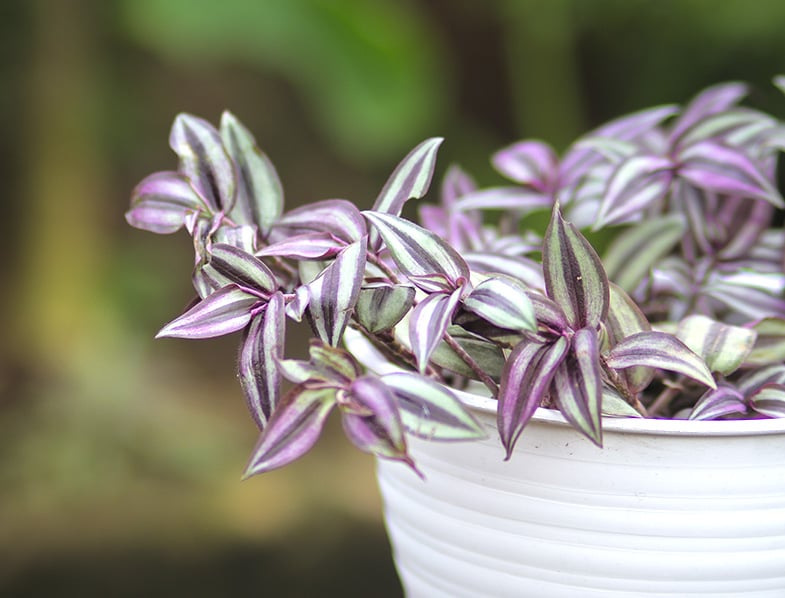
Tradescantia Fluminensis
This wandering Jew species features white flowers, and it’s a trendy indoor plant around the world. The species originates from the southeastern region of Brazil. It’s an evergreen perennial plant that flowers all-year-round and lasts for many years if the owner takes care of it correctly.
The oval-shaped foliage of the Fluminensis is green in color and has a glossy look. The leaves attach to fleshy stems, and the stem nodes quickly put roots down into the soil, allowing for the rapid spread and growth of the plant in ideal growing conditions.
When the plant flowers , it produces a set of flowers with three white petals. The flowers don’t bear any seeds, and they might also emerge in clusters. There are various sub-species of this plant as well, and some types, such as variegate, feature different leaf colors, such as yellow or cream streaks in the leaves.
The plant does best in USDA zones 9 to 12, as it loves the additional humidity in these regions as well. The wandering Jew doesn’t do well in colder climates, so stick to planting in the southern states.
The wandering Jew also prefers full sunlight during the day, and you’ll need to feed it a reasonable amount of water throughout the week. The plant doesn’t enjoy being dry for long periods.
Tradescantia Pallida
This variety originates in Mexico, and it’s the most attractive of the three Tradescantia genus. This wandering Jew produces long, pointy leaves that can reach lengths of 7-inches. The leaf will eventually turn a purple color, but the tips might remain red or green during the color transition.
There are visible segmentations on the stem of this wandering Jew, and it’s for this reason that many countries classify this plant as invasive.
The segments break easily, but they root readily, evolving into two plants with little care. Fortunately, for fans of the plant, it also makes it easy to grow the plants for cuttings as well.
Tradescantia pallida don’t like the cold, and it will die back in colder environments in the Northern states, especially if it grows outside. This wandering Jew produces small flowers that bloom in colors of pink, lavender, and white. The flowers feature three petals, and while they aren’t show-stopping, then do add a beautiful aesthetic to the plant.

- shipped in inproved box to save the plant

Last update on 2024-05-02 / Affiliate links / Images from Amazon Product Advertising API
Natural Air Cleaners
One of the reasons why the wandering Jew is such a popular house plant is its natural air-cleaning properties. The wandering Jew is an excellent “air scrubber,” and it removes bacteria and VOCs from the air inside your home, exchanging it for fresh air that enhances your home.
Some research also shows that the wandering Jew can assist in soil remediation, as well. The plant can remove heavy metals from the soil, helping restore the root health of other plants in the same flowerbed or pot.
Caring for Your Wandering Jew Plant
All varieties of the wandering Jew are easy to care for, provided that you grow them in the right climate and conditions. As long as the plant receives regular watering and pruning, it will thrive, and you’ll also manage to control the growth as well.
If you plant in a sunny spot in your home, then you can expect your tradescantia to last for many seasons. It’s also important to note that the plant might not flower it in its first season. However, by the third year, you should see plenty of flowers that emerge in the summer months.

As mentioned, the wandering Jew prefers sunny planting locations. The plant prefers later afternoon sun to morning sun, but it does well in any sunny area around the home. The more light you give the plant, the more flowers it produces in the flowering season.
If your wandering Jew does not get sufficient sunlight, you’ll notice that the color of the leaves starts to fade. Move the plant to a sunny spot, and it should recover in less than a week.
The wandering Jew enjoys a balanced moisture level in its soil . Don’t let the earth get too dry, as it might cause burning in the tips of the leaves. Likewise, the wandering Jew does not enjoy excessively wet soil either. The plant is susceptible to forming root rot if you “keep its feet wet.”
To check if it’s time to water your wandering Jew, push your finger about 1-inch into the soil. If it feels dry, then give your plant some water.
You must ensure you use a rich, loamy soil that drains well when planting your wandering Jew. When planting in a pot, make sure you add a layer of gravel at the bottom of the pot to enhance drainage. Add perlite to the soil to assist with drainage as well.
You can get away with using a standard potting mix when planting indoors , and other soil enhancements we recommend you add are the following.
- Coarse sand and perlite for drainage
- Humus or peat
- A light dusting of lime
- A few handfuls of rich organic compost
You want the soil to retain water but still allow optimal drainage.
During the growing season, fertilize your wandering Jew plant using a liquid-based fertilizer product. Make sure that you dilute the fertilizer to 50-percent strength.
Strong concentrations can result in burning in the tips of the leaves of the plant. You can also add a granular slow-release fertilizer to the soil once a year at the start of spring.
The wandering Jew grows quickly, and it might take over its pot in one or two seasons, depending on the size of the container. Therefore, you’ll need to pull up the plant and divide it from year-to-year, depending on its growth rate.
If you choose to re-pot your plant, make sure you use a pot that’s at least 50-percent larger than the old one. Line the pot with potting soil and a few handfuls of rich organic compost. Dig around the edges of the existing container to loosen the root ball. After loosening, pull the base of the plant to release it from the pot.
Move the plant to its new pot, and then fill with potting mix to cover the roots — Pat down the soil, and then water lightly.
Wandering Jew plants require regular pruning . The plant grows quickly, and if you don’t prune, then it can overtake the pot fast. Pruning also helps the stem, from getting “leggy,” meaning that the plant starts to look bare at the base. Pruning keeps the plant healthy and growing at an optimal rate.
All; you need to do is prune back any stems and pinch the stem tips. The wandering Jew will then send out two new shoots from the pinched top, helping your plant spread out into a bush-like appearance.
Propagation
The wandering Jew is easy to propagate . This plant grows quickly in a variety of conditions, which is one of the reasons why most countries list it as invasive. You can propagate your cuttings after your pruning session, without much effort.
Remove all of the leaves but the top set after pruning the stem. Place the cutting in another smaller pot with moist potting soil . Leave the container in the sun, and you should find that the cutting roots in a month.
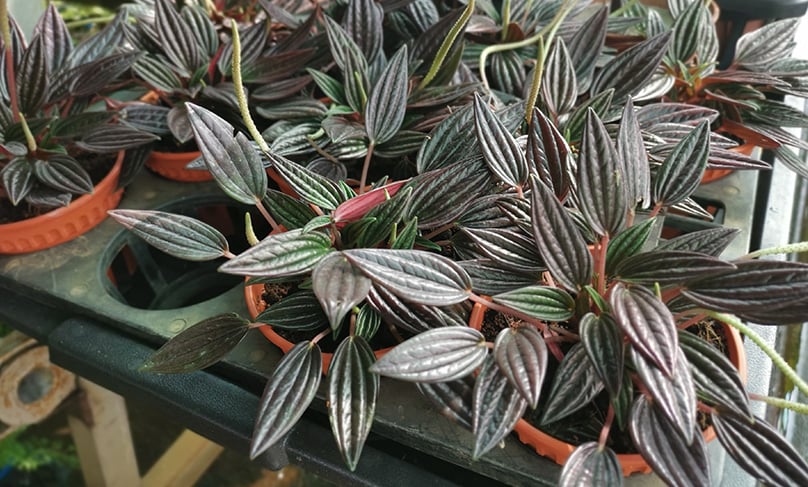
Being an indoor plant , the wandering Jew does not get much attention from pests. However, spider mites can be a problem for your plant if you don’t take care of it and watch for the presence of pests.
Spider mites are tiny spider-like bugs that form a web around the inside of the leaves of the plant. If left unmanaged and untreated, they might start to cause yellow spots in the foliage. The wandering Jew might also fail to flower in the summer months as well.
Over-watering your wandering Jew plant can result in the onset of diseases like root rot. Ensure that you have a well-draining soil mix before planting your wandering Jew. Provided that you do everything you can to ensure your soil drains well, you should never have a problem with root rot in your wandering Jew plant.
Wandering Jew Plants FAQS
What is the best way to grow a wandering jew plant.
The best way to grow a Wandering Jew plant involves placing it in a location that gets plenty of sunlight, preferably late afternoon sun. You should use well-draining, loamy soil to plant it, and ensure a balanced moisture level by watering it regularly but not excessively. The plant also appreciates humidity and occasional fertilizing with a liquid-based fertilizer diluted to 50% strength during the growing season. Pruning should be done regularly to manage its growth.
Is Wandering Jew easy to grow?
A: Yes, Wandering Jew plants are generally easy to grow. They adapt well to various conditions and are fast-growing. They can be propagated easily from cuttings and require minimal maintenance beyond regular watering, pruning, and an occasional application of fertilizer. However, they do not tolerate cold climates very well.
Does wandering Jew like full sun or shade?
Wandering Jew plants prefer locations with full sunlight. They can tolerate some shade but too much shade can cause the color of the leaves to fade. More sunlight exposure generally leads to more flowers during the flowering season.
How often do you water Wandering Jew?
Wandering Jew plants should be watered regularly to maintain a balanced moisture level in the soil. However, the soil should not be allowed to become too dry or too wet. Overwatering can lead to root rot. A good way to check if it’s time to water is to push your finger about 1-inch into the soil. If it feels dry, it’s time to water the plant.
Is Tradescantia Zebrina easy to grow?
Yes, Tradescantia Zebrina, a variety of Wandering Jew, is easy to grow. It requires similar care to other Wandering Jew varieties and is known for its adaptability and quick growth.
Does Tradescantia Zebrina need full sun?
Tradescantia Zebrina does best in a location with full sunlight. While it can tolerate some shade, insufficient sunlight can cause the leaves to lose their vibrant color. Like other Wandering Jew plants, the more light it gets, the more flowers it produces during its flowering season.

Hollie is a life-long gardener, having started helping her Dad work on their yard when she was just 5. Since then she has gone on to develop a passion for growing vegetables & fruit in her garden. She has an affinity with nature and loves to share her knowledge gained over a lifetime with readers online. Hollie has written for a number of publications and is now the resident garden blogger here at GardenBeast. Contact her at [email protected] or follow on twitter https://twitter.com/greenholliec
Pampas Grass Guide: How to Plant & Care for “Cortaderia Selloana”
Rhaphidophora tetrasperma guide: how to grow & care for “mini monstera”, corn plant guide: how to grow & care for “dracaena fragrans”.
under the photo “easy to propagate”, that is not a wandering jew-its a peperomia “rosso!”
My wandering jew plants leafs are getting dried. Why is that?
It’s not getting enough humidity
Could you elaborate on “rich organic compost”? What should it be made of, exactly? Can I use compost accelerator in the soil mix?
Worm castings are great, or worm tea, egg shell tea is another.
What month does the jew break ground to start growing?
All depends on your specific areas weather pattern and seasons.
Do NOT BUY ANY OF THIS SPECIES if you have a dog because dogs are very allergic to these plants & come out in bad rashes if they wander through them!
Leave A Reply Cancel Reply
Save my name, email, and website in this browser for the next time I comment.
Type above and press Enter to search. Press Esc to cancel.
- Privacy Policy

- Houseplants
- Gardening And Landscaping
Wandering Jew Plant (Tradescantia or Spiderwort): Care, Types, Images and More
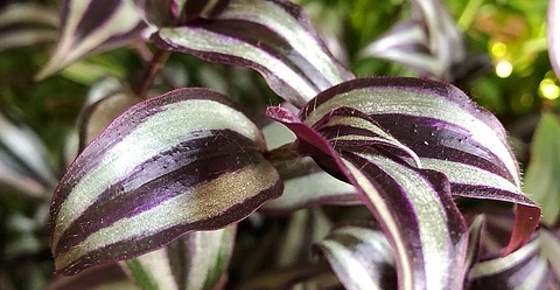
The wandering Jew plant is a common name for different species of plants that belong to the Tradescantia genus. There are around 75 different types of plants in Tradescantia genus and some are called inch plants, spiderwort, striped wandering Jew, Boat Lily, Purple Queen, or flowering inch plant. Wandering Jew plants are great house plants because they are relatively easy to care for. They are also easy to grow because the wandering Jew plant propagates easily from cuttings.
Some types of wandering Jew plants have green and gold leaves, some have reddish leaves, and others have green fuzzy leaves. There are also types of wandering Jew plants that flower. Depending on the species, the wandering Jew plant could have purple, white, or pink flowers.
How to care for wandering Jew plant : For the Tradescantia or spiderwort plant to thrive, grow in a plenty of indirect light and plant in fertile, moist potting soil with good drainage. Make sure the soil isn’t too dry or too damp and keep medium humidity levels. The ideal temperature range is between 65°F (18°C) and 75°F (23°C). You can fertilize every four weeks during the growing season with a diluted liquid houseplant fertilizer.
In this article, you will find all you need to know about this delightful houseplant. You will also get tips and ideas on how to care for your wandering Jew plants.
Wandering Jew Plant (Tradescantia or Spiderwort) – Overview of the Plant and Its Flowers
The botanical name for wandering Jew plant is Tradescantia zebrina and is also called the inch plant. However, the name wandering Jew is given to many herbaceous perennial plants in the Tradescantia genus. ( 1 )
Species of Tradescantias naturally grow outdoors in countries in Asia, Africa, Central and South America, and Australia. Varieties of wandering Jew plants also thrive well indoors, where, like their garden varieties, they grow well when it is warm, sunny, and moderately humid.
According to the United States Department of Agriculture, various varieties of Tradescantias are regarded as invasive plants in the wild. However, it is the fast-growing nature of spiderworts, wandering Jews, and inch plants that makes them perfect houseplants. ( 2 )
Many people like to grow wandering Jews or spiderworts in hanging baskets or grow them in pots to decorate a garden.
What does a wandering Jew look like?
Plants from the Tradescantia varieties have leaves that seem to grow in all directions (hence the term “wandering Jew”).
One of the distinct features about foliage on wandering Jews is that many of them have striped leaves. Sometimes, the leaves can be purple and silver stripes, whereas other types of Tradescantias have leaves that are almost all silver. ( 3 )
You may also notice that some varieties of wandering Jew plant have different colors on the underneath of the leaf. For example, the Tradescantia zebrina has green/silver leaves on the upper side and deep red or burgundy colors on the underside.
Wandering Jew flower
Wandering Jew houseplants also produce attractive flowers. These flowers can sometimes be white or can range in color from pink to various shades of lilac and purple. ( 3 )
However, plant lovers don’t usually grow wandering Jews indoors or outdoors for their blooms. It’s the beautiful variation of leaf colors that makes various types of Tradescantias so desirable houseplants.
Types of Wandering Jew (Spiderwort) Plants
The most popular types of Tradescantia plants to keep indoors are Tradescantia fluminensis ( spiderwort ), Tradescantia pallida ( purple heart ), and Tradescantia zebrina ( wandering Jew ).
Wandering Jew or inch plant ( Tradescantia zebrina )
This type of wandering Jew houseplant has purple and green leaves with a stripe pattern that resembles zebra’s stripes. There are types of wandering Jews that have bluish green leaves and purple hues on the underside.
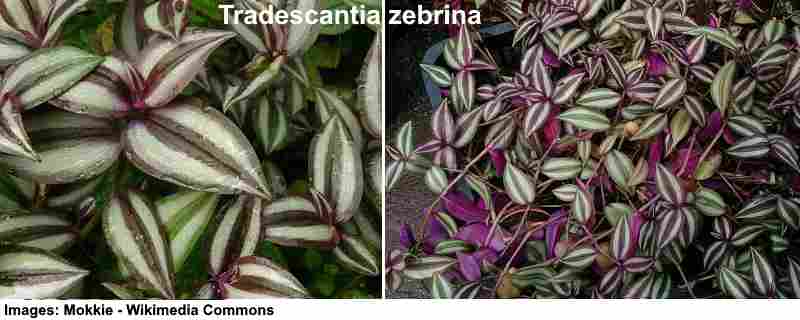
Tradescantia fluminensis (spiderwort)
There are a number of types of Tradescantia that are called spiderwort. This is distinguished from some Tradescantias as it has ovel shiny dark green leaves with pointed tips which are slightly fleshy .
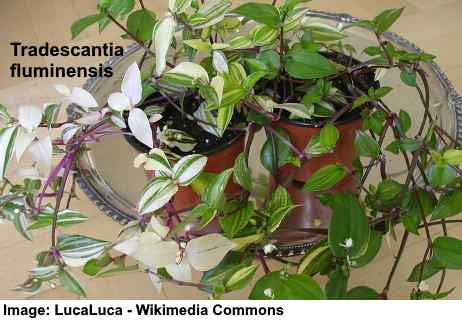
Picture of wandering Jew plant with white flowers
Tradescantia pallida (purple heart)
This type of spiderwort plant is also commonly referred to as wandering Jew. The T. pallida houseplants have vibrant purple leaves and light pink flowers when they bloom.
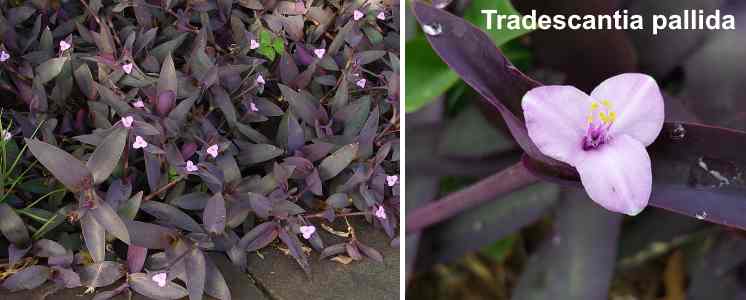
Wandering jew plant with deep purple leaves and light purplish-pink flowers
Tradescantia callisia
The leaves of T. callisia varieties are sometimes referred to as creeping inch plants. They have remarkably stripy leaves made up of green and white stripes.
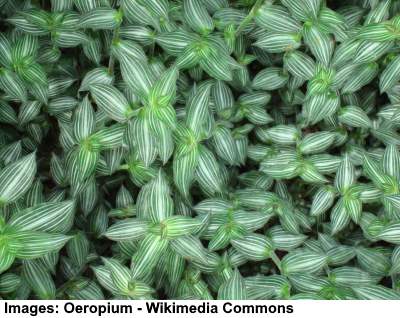
Picture of green wandering jew
Wandering Jew Plant Care (How to Grow Spiderwort or Tradescantia)
Caring for wandering Jew plants is fairly simple and straightforward. All plants in the Tradescantia genus enjoy moist soil, sunny but indirect sunlight, and warm conditions.
So, it doesn’t matter if you have fuzzy leaf Tradescantias, purple queen varieties, spiderworts, or wandering Jews, they all require the same type of care.
Light requirements for Tradescantias
To make sure that wandering Jew plants grow successfully, they require a good amount of light. This ensures that they grow with healthy leaves that have a vibrant green, silver, purple, or lilac colors.
The best place to place wandering Jew plant or spiderworts is in an east- or west-facing location. This means that they get plenty of natural light without being in direct sunlight when the sun is at its strongest.
The only exception is if you have Tradescantia pallida plants with dark purples leaves. They usually thrive in direct sunlight, although you should regularly check them in the summertime to make sure the sun isn’t too strong.
One sign that your Tradescantia isn’t getting enough light is if the color of their leaves starts to fade.
Best growing temperature for Spiderwort or Tradescantia
One of the reasons why wandering Jew plants are good for the home is that they thrive in room temperature.
The best temperatures for growing any type of Tradescantia plant is between 65°F (18°C) and 75°F (23°C). The houseplants also thrive in conditions that are described as “average humidity.”
If you grow Tradescantias outdoors, you should be aware of a drop in night temperatures and lower temperatures during winter. You should bring Tradescantias indoors if the temperature drops.
Best watering techniques for wandering Jew plant care
To care for your inch plant, spiderwort, or wandering Jew, you should keep the soil moist.
The best way to water a wandering Jew is to water the soil thoroughly and let the water drain out the bottom. Another way to water your purple house plant is to put water in the plant pot tray and allow the plant to soak up as much as it needs.
Some beginners who start caring for houseplants such as Tradescantias for the first time buy a soil moisture gauge to help get the soil moisture levels just right.
When it comes to proper watering for your wandering Jew, always make sure the soil isn’t too dry or too damp. Usually, weekly watering in the summertime is enough to keep your Tradescantia growing well.
The best fertilizer for wandering Jew houseplants
The reason why Tradescantias are so easy to care for is that they don’t usually require any feeding.
If you decide to encourage your inch plant or spiderwort to grow faster, then choose a liquid organic fertilizer mixed at half strength and use once a month.
Most houseplant growers don’t feed their wandering Jew plants in the fall or winter as they tend to become “leggy” or “straggly.”
Which type of soil to use for Tradescantias
To properly care for wandering Jew varieties of houseplants, you only need to plant them in regular potting soil.
How to prune wandering Jew plants
In time, Tradescantia plants require some cutting back and pruning. This helps to give your houseplant a bushier appearance and also gives you plenty of cuttings to propagate.
For Tradescantia pruning, you just need to pinch off the stem tips to leave about ¾ of the length. This will encourage your plant to grow better and become more attractive.
Growing Plants from Wandering Jew Cuttings
Even for the most novice of houseplant owners, propagating any type of Tradescantia plant is very easy. After you have cut back your “leggy” wandering Jew stems, you will have a large number of cuttings that you can use to grow new house plants.
How to propagate wandering Jew plant leaves
To prepare your wandering Jew cuttings or purple heart plant cuttings for propagation, you need a couple of stems about 1-2 inches long. Remove all the leaves apart from 2 or 3 at the end of the stem.
There are 2 ways you can grow wandering Jew plants from cutting:
- The first way is to just put a cutting in potting soil and wait for it to grow. All you have to do is make sure that the soil is kept moist and not overly damp.
- The other way to grow a Tradescantia from a cutting is to put the stem in water. You should notice that new roots start to grow within a week. When you notice new roots growing, you can transfer your cuttings to a pot to grow a new houseplant.
Wandering Jew Outdoor Plant Care
Tradescantia plants are great garden plants and grow well outdoors in warmer zones in the U.S. (USDA growing zones 9-11). In fact, it is because they grow so well outside in warmer countries and are quite invasive that they are classed as a weed in certain countries.
You can easily care for any Tradescantia plants to add color and beauty to your garden. Purple hanging plants or wandering Jew vines with stripy leaves can grace any patio, doorway, or garden area.
As with caring for wandering Jews or spiderworts indoors, Tradescantia plants growing outdoor should be protected from direct sunlight. So, place your plants in shady areas of the garden. But it’s good to remember that some bright light will help the wandering Jew plant produce more flowers.
Temperature
Also, frost can damage the plant, so, if you live in areas where fall and winter temperatures drop below 10°F (12°C), you should take them indoor and continue to grow them as houseplants.
Problems with Wandering Jew Plant (Spiderwort)
Even though it is relatively easy to care for wandering Jew plants, you can still come across certain problems.
Let’s look at some growing tips for Tradescantia plants to avoid or remedy some common problems.
The most common pest when growing wandering Jews indoors are bugs such as spider mites or aphids . The appearance of these pests on your bushy spiderwort or inch plant may be a sign that conditions are too dry.
To help remedy the problems of pests on your Tradescantia, mist the leaves regularly and make sure the soil is moist enough. You may need to wash off the mites with water to help get rid of the infestation.
One of the beauties about caring for wandering Jew plants indoors or outdoors is that they are not susceptible to disease. Usually, any discoloration of the leaves or poor growth is connected to the soil being too dry or too damp.
Fungal infections
Overwatering spiderworts, inch plants, or wandering Jews can cause a fungal growth called botrytis to develop in the roots.
Brown leaves
As with most problems associated with caring for Tradescantias, brown leaves can also indicate that the growing environment isn’t right. The leaves of your wandering Jew could have turned brown because of too much or too little sunlight. Also, too much watering can affect leaf health.
Where to Buy Wandering Jew Plants
Many garden centers and online stores stock many different varieties of wandering Jews. You will also find that Tradescantia cuttings are available online.
Because many different types of wandering Jews are so easy to grow yourself, you could ask a friend for a cutting if they have the plant. You can also get more Tradescantia houseplant or garden plants by propagating cuttings from plants you already have.
FAQ Related to Wandering Jew Plant (Tradescantia)
Do they need any pruning.
To properly care for wandering Jews, the leaves and stems require pruning. The stems can grow quite long and start losing their leaves from the base. The best time to prune any Tradescantia plant is just before the growing season in late winter or early spring.
You may also find that Tradescantias grow better if you give them a mild prune in late summer.
How to prevent wandering Jew roots from rotting?
Go easy on the watering to stop Tradescantia plants’ roots from rotting. Water them enough to keep the soil moist during summertime and only occasionally in the winter.
Are wandering Jew plant leaves toxic to animals?
While not toxic to cats or dogs, the leaves of wandering Jew plants can cause irritation. If you have pets that like to nibble on leaves, you can still benefit from the beauty of Tradescantias if you grow the outdoor plant in hanging baskets.
Can I grow my Tradescantia plant outdoors?
Yes, you certainly can. Wandering Jew plants grow well out of doors in warm climates. During the summertime, you can move your indoor houseplants to the garden and place them away from direct sunlight.
Dashes of purple colors, bright pinks, or interesting green and purple stripped leaves can make an interesting feature in any garden or balcony.
Can you train a wandering Jew plant?
Tradescantia plants are easy to train because their stems can grow very long and you can wrap them around objects. Wandering Jew plant stems can grow up on trellises or obelisks or up around any other item.
Heavily pruning wandering Jews in late winter can also help to train the plant to grow into a colorful bush.
How fast does wandering Jew plant grow?
Tradescantia cuttings should start growing roots within a week or so. Once the plant is established, you can expect it to grow about an inch every week. Some people claim this is the reason that some Tradescantias are called inch plants.
Can Tradescantia houseplants cause allergies?
The sap of wandering Jew plants or prolonged skin exposure to its leaves could cause allergic reactions.
The journal Allergy reports that indoor plants such as Tradescantia can also cause symptoms such as itching of the throat, swelling, wheezing, and runny eyes and nose. ( 4 )
Do wandering Jew varieties have any health benefits?
Although not widely used, extracts from Tradescantia zebrina have certain medicinal properties. You can buy inch plant herbal liquid extracts that are said to have many antioxidant properties.
Researchers have found that therapeutic compounds in Tradescantia extracts have antibacterial, anticancer, and antioxidant uses. ( 5 )
Related articles:
- Moses In Cradle Care: How to Grow Tradescantia spathacea
- Chinese Money Plant Care: How to Grow Pilea Peperomioides
- Dracaena Marginata Plant Care: How to Grow Madagascar Dragon Tree
- PRO Courses Guides New Tech Help Pro Expert Videos About wikiHow Pro Upgrade Sign In
- EDIT Edit this Article
- EXPLORE Tech Help Pro About Us Random Article Quizzes Request a New Article Community Dashboard This Or That Game Popular Categories Arts and Entertainment Artwork Books Movies Computers and Electronics Computers Phone Skills Technology Hacks Health Men's Health Mental Health Women's Health Relationships Dating Love Relationship Issues Hobbies and Crafts Crafts Drawing Games Education & Communication Communication Skills Personal Development Studying Personal Care and Style Fashion Hair Care Personal Hygiene Youth Personal Care School Stuff Dating All Categories Arts and Entertainment Finance and Business Home and Garden Relationship Quizzes Cars & Other Vehicles Food and Entertaining Personal Care and Style Sports and Fitness Computers and Electronics Health Pets and Animals Travel Education & Communication Hobbies and Crafts Philosophy and Religion Work World Family Life Holidays and Traditions Relationships Youth
- Browse Articles
- Learn Something New
- Quizzes Hot
- This Or That Game
- Train Your Brain
- Explore More
- Support wikiHow
- About wikiHow
- Log in / Sign up
- Home and Garden
- Indoor and Patio Plants
A Complete Guide to Wandering Jew Plant Care
Last Updated: May 28, 2024 Fact Checked
- Potting Your Plant
- Caring for Your Plant
Preventing Pests & Disease
Expert q&a, things you'll need.
This article was co-authored by Chai Saechao and by wikiHow staff writer, Dev Murphy, MA . Chai Saechao is the Founder and Owner of Plant Therapy, an indoor-plant store founded in 2018 based in San Francisco, California. As a self-described plant doctor, he believes in the therapeutic power of plants, hoping to keep sharing his love of plants with anyone willing to listen and learn. There are 12 references cited in this article, which can be found at the bottom of the page. This article has been fact-checked, ensuring the accuracy of any cited facts and confirming the authority of its sources. This article has been viewed 644,010 times.
Wandering Jews are beautiful vining plants known for their solid or variegated leaves. These hardy perennials thrive outdoors as groundcover or in pots that allow their tendrils to cascade. They’re relatively easy to care for and incredibly simple to propagate, making them great houseplants! Keep reading for an easy step-by-step guide to Wandering Jew maintenance, from planting to watering to pruning.
Things You Should Know
- Keep your Wandering Jew in a warm spot (around 50–80 °F (10–27 °C)) with lots of bright, indirect sunlight.
- Pot your plant in well-draining potting soil in a container with drainage holes. Keep the soil moist, but not soaking wet.
- Pinch or prune the leaves when the plant gets leggy to promote bushiness, or when any leaves or vines begin to brown or rot.
Potting Your Wandering Jew Plant

- Refer to this map to see if your area's temperatures are warm enough to support a Wandering Jew plant, if you're planning on keeping it outside. According to the USDA, the Wandering Jew plant grows best in zones 9-11.
- If you don’t live in USDA hardiness zones 9-11, keep in mind that you may not be able to keep your plant outside during the winter. You may want to grow it inside instead.

- If you use a hanging basket, remember to turn it daily so it gets equal amounts of sunlight.
- If you’re hanging your plant, choose a lightweight or plastic pot so it won’t fall. This also makes it easier to move inside in case of frost.

- Be careful not to use soil that’s too heavy, as Wandering Jews need light soil that drains well. [3] X Research source
- Buy well-draining soil, or, if you already have heavier soil, mix equal parts soil with compost, or equal parts soil, compost, and peat.
- Purchase a Wandering Jew plant at a gardening or home improvement center, or propagate cuttings from established plants . Wandering Jew cuttings grow very quickly.
Watering, Fertilizing & Pruning Your Plant

- If you’re growing your plant indoors, an eastern facing windowsill is a good spot. The plant will receive bright indirect light throughout the day, but watch to make sure the space doesn't become too hot in the afternoon. If so, move the pot a few feet away or use a curtain to filter the light. [5] X Research source
- If the plant primarily remains outside, find a spot that receives indirect sunlight. This could be on a porch that gets morning sun for several hours. Just make sure that it's not sitting in direct sunlight without any shade for most of the day.

- If you've set your pot on a saucer, empty the saucer when it fills.
- The plant's growth will slow in the winter months, meaning it needs to be watered less often. Simply let it remain a little dry for a bit longer before watering.
- Some people find it convenient to put self-watering aqua globes in their plant pots; however, these glass globes require cleaning and regular filling. You'll still need to monitor your plant's moisture if you choose to use them.

- Read the container's instructions carefully before fertilizing, as some liquid fertilizers may actually be powders requiring you to mix in water.

- The best time to prune is during the spring and summer months, when the plant is putting on the most growth. After you've pruned, give the plant a chance to put on new shoots and fill in.
- If you find your plant is too dense and bushy, you'll need to prune around the base so that the plant can get adequate circulation and sunlight.

- Generally, expect to repot your plant annually, but keep an eye out for signs your plant has outgrown its container within that time frame: once you see roots creeping out from under the plant through the drainage holes, or popping up through the soil, it’s time to repot. [10] X Trustworthy Source Penn State Extension Educational organization dedicated to delivering science-based information to people, businesses, and communities Go to source

- Try to use distilled or bottled water when misting the leaves for the best results.
- Brown leaves can also be a sign that your plant is getting too much sunlight. In this case, make sure your plant is not directly in the sun by moving the pot or placing a filter, such as a curtain, in between the plant and the window.

- Root rot can spread very quickly, so act fast when you see signs of it. It can be heartbreaking to cut away a large chunk of your plant, but if you wait too long, you could lose the whole plant. [14] X Research source
- Other signs of root rot include spongy, black roots.

- Though "Wandering Jew" is the most common name for this plant, some people may find this term offensive. Consider using "wandering dude" or "inch plant" instead. Thanks Helpful 2 Not Helpful 2
- "Wandering Jew" doesn't refer to just one plant: it refers to a variety of Tradescantia species, the 3 most common of which include Tradescantia fluminensis ("Quicksilver"), Tradescantia pallida ("Purple Heart"), and Tradescantia zebrina ("Tricolor"). Care is the same for all 3. Thanks Helpful 1 Not Helpful 1

- Be careful when pinching or pruning your plant. Wandering Jew sap can cause skin irritation in some people and allergic reactions in dogs. To be safe, wear gardening gloves when pruning your Wandering Jew. [15] X Research source Thanks Helpful 0 Not Helpful 0
- Wandering Jew cuttings or a plant
- Well-draining potting soil
- Pot or hanging basket
- 10-10-10- fertilizer
- Aqua globes (optional)
- Pruning shears (optional)
- Gardening gloves
You Might Also Like

- ↑ https://houseplantcentral.com/tradescantia-zebrina-care-info/
- ↑ https://www.almanac.com/plant/inch-plants
- ↑ https://getbusygardening.com/wandering-jew-plant-care/
- ↑ https://www.weekand.com/home-garden/article/indirect-light-plants-18005506.php
- ↑ https://www.almanac.com/plant/wandering-jew
- ↑ https://www.weekand.com/home-garden/article/use-101010-fertilizer-garden-18057536.php
- ↑ https://www.gardeningknowhow.com/houseplants/wandering-jew/growing-wandering-jew-plants.htm
- ↑ https://extension.psu.edu/repotting-houseplants
- ↑ https://www.houseplantsforyou.com/wandering-jew/
- ↑ https://www.gardeningknowhow.com/plant-problems/disease/treating-root-rot-gardening-tips-for-housplants.htm
- ↑ https://www.wildinteriors.com/blog/2019/10/30/treating-root-rot-and-soft-rot-in-houseplants
- ↑ https://www.weekand.com/home-garden/article/wandering-jew-plants-dangerous-dogs-18063157.php
About This Article

To take care of your Wandering Jew plant, place it by an east-facing window so that it gets a combination of direct and indirect sunlight. Keep the soil moist, but not soaked, and water the soil instead of the top of the plant to avoid rot. You should also fertilize the Wandering Jew plant every two weeks with a liquid 10-10-10 fertilizer. To keep the plant from getting leggy, trim back the stems in the spring and summer. Did this summary help you? Yes No
- Send fan mail to authors
Reader Success Stories
Nancy Gibson
Jun 6, 2016
Did this article help you?

Sherry Clark
Mar 30, 2016
Sep 23, 2016
Beverly Cox
May 18, 2016

Featured Articles

Trending Articles

Watch Articles

- Terms of Use
- Privacy Policy
- Do Not Sell or Share My Info
- Not Selling Info
Get all the best how-tos!
Sign up for wikiHow's weekly email newsletter
Grow. Play. Every Day!

- House & Home
- Houseplants
Wandering Jew Care: How to Grow a Long and Luscious Inch Plant (Tradescantia Zebrina)
Tradescantia zebrina (commonly known as wandering Jew, spiderwort, or inch plant) is popular for a reason: This beginner-friendly houseplant is low-maintenance and grows quickly. It’s also super easy to propagate more plants so you can fill your home with more of the colorful striped foliage the species is known for.
Written by Linda Ly

When it comes to vigorous, colorful, and easy-to-grow hanging houseplants, there aren’t many that can compare to Tradescantia zebrina (known more commonly as wandering Jew—and I’ll touch on the history of that name below). Whether you’re a houseplant beginner or a veteran, most indoor gardeners have owned one of these potted plants at some point.
Keep reading for everything you need to know about Tradescantia zebrina and growing this stunning houseplant in your own home.
Disclosure: If you shop from my article or make a purchase through one of my links, I may receive commissions on some of the products I recommend.

About inch plants
Natural habitat.
Tradescantia zebrina is a native of Central and South America, from Mexico down to Colombia, as well as the Caribbean. Here, it forms part of the undergrowth in lightly forested and often very moist areas. It can form very dense, wide mats thanks to its creeping growth pattern and ability to throw roots extremely quickly.
Unfortunately, its vigorous growth has also made Tradescantia zebrina an invasive plant in some regions. This includes Hawaii, Brazil, and Australia, where the species easily takes hold in moist, forested areas.
As a 2019 study carried out in the Brazilian Atlantic Rainforest notes, this is problematic due to the species choking out native plants.
Some of the above was caused by careless gardeners allowing bits of the plant to get into the wild, where they quickly root. If you’d like to grow spiderworts like this one in your garden, please make sure to dispose properly of any trimmings left after pruning!
This also applies to zebrina’s popular cousins, like Tradescantia fluminensis, T. pallida, and T. spathacea.
Description
It’s not difficult to see why Tradescantia zebrina gained popularity as a houseplant. Wandering spiderwort plants (not to be confused with spider plants , another beginner-friendly species) are low-maintenance and grow just about anywhere—they even just grow in water !
Easy care and quick growth aside, spiderworts are also just good-looking plants. The pointed, oval leaves on thin, fleshy stems overlap slightly and are characterized by their zebra pattern in purple and silvery green. The leaf undersides are deep purple in color and the tiny, three-petaled flowers are bright pink.
Although this species is naturally a creeping plant, it’s often grown indoors in hanging planters. As long as the plant is provided with enough light, the foliage will be very dense and brightly colored, forming a spectacular waterfall that can reach more than 3 feet in length.
What’s in a name? In the case of common houseplants, sometimes a lot.
Tradescantia zebrina is a classic houseplant (I found mention of it in a 1964 German book about houseplants, but it’s probably been around longer than that!) and among most English speakers, it has long been known as wandering Jew. This is probably a reference to the “wandering” nature of the plant, as it does have a creeping growth pattern.
The legend of the wandering Jew is hundreds of years old and is now commonly considered to be rooted in antisemitism. It describes a Jewish man cursed to walk the planet until the Second Coming because he taunted Jesus on his way to the cross.
Because of this, the plant name has partly fallen out of fashion and has been the source of much debate in the plant world over the past few years.
Some plant enthusiasts have embraced the alternative “wandering dude,” which I personally think is a great option.
“Inch plant” (houseplant enthusiasts don’t agree on whether this refers to the fact that it can grow an inch a day, or that you only need an inch of stem to propagate it), “spiderwort,” or “wandering spiderwort” are also popular alternatives, though these are common names for other Tradescantia varieties, such as Tradescantia Nanouk.
The best way to avoid any confusion is to just stick to the scientific name.

Inch plant varieties
There are three subspecies of inch plant (wandering Jew): Tradescantia zebrina var. zebrina, var. flocculosa, and var. mollipila. Unsurprisingly, after it having been a popular houseplant for so many years, nurseries have also managed to create a whole bunch of cultivars through selective cultivation.
A few of the popular Tradescantia zebrina cultivars you may come across in your local plant store include, but are certainly not limited to:
- Tradescantia zebrina ‘Quadricolor’: Yep, as the name suggests, this one adds an extra color to the mix. The leaves are cream, pink-purple, light green, and dark green.
- Tradescantia zebrina ‘Burgundy’: Characterized by its very dark purple coloration.
- Tradescantia zebrina ‘Silver Plus’: Less purple, more shiny silver.
- Tradescantia zebrina ‘Red Gem’: Less silver, more intense (light) purple.
- Tradescantia zebrina ‘Purple Joy’: Less silver, more dark purple.
- Tradescantia zebrina ‘Tikal’: A rare, naturally occurring variety that collectors pay a pretty penny for.
Do keep in mind that most of these cultivars aren’t patented and the amount of mislabeling and variation within a cultivar are both huge. Just growing your wandering Jew in lower-light conditions can completely change the way it looks, so it’s not surprising that confusion sometimes reigns supreme.
Luckily, care is the same across all cultivars, so your best bet is to just enjoy your plant even if you’re not sure what Tradescantia variety you’re dealing with!
Where to buy wandering Jew plants:
- California Tropicals
- Daylily Nursery
- The Green Escape

Caring for an inch plant
Light and temperature.
It’s important to provide your Tradescantia zebrina with enough light. It’s tempting to use plants to brighten up dark, shaded spots in your home, but that just doesn’t work with this one: It loses its dense growth pattern and beautiful coloration in low light.
To prevent your wandering dude plant from growing sparse and green, place it near a window that gets bright indirect light. Some full sun isn’t a problem either, but do make sure you acclimate it gradually to a higher light location.
Temperature-wise, this species is a lot hardier than many of the tender tropicals we like to grow in our homes (like Anthurium andraeanum and Begonia maculata ).
Wandering dude plants can handle a very wide range of temps, making it perfect for those chillier windowsills that your other plants may not appreciate. Room temperature is ideal, but anything between 50°F to 85°F will keep them happy.
Water and humidity
Your Tradescantia zebrina will appreciate lightly moist soil. You can water a bit more during the summer months, when the plant is actively growing and needs a lot of moisture, and less during winter, when soil tends to take significantly longer to dry.
If you’re not sure whether it’s time to water your wandering Jew plant yet, you can always turn to the age-old trick of sticking a finger in the soil.
- If it still feels damp, wait a little longer, until the first inch or two has dried.
- If it feels bone dry, you’ve waited too long; you may also see limp leaves on your plant at this point. It’ll bounce back, but not always without lasting damage.
- If the soil feels wet, you watered too much and need to keep an eye out for root rot.
As for humidity, given its rather wet natural habitat, wandering Jew does appreciate higher air moisture levels. The great thing is, though, that it doesn’t demand it. As long as you keep its soil lightly moist and the air isn’t extremely dry, your plant should do well.
Soil and planting
Wandering Jew is not fussy about its potting mixture at all. I’ve grown it in pure houseplant potting soil with no additives. If you do want to take things to the next level, you can add some perlite and/or peat moss, although this is really not a must.
Most houseplant enthusiasts like to place their wandering Jew in a hanging planter so they can enjoy the look of the leaves cascading down. This is not a must, though. You can also emphasize the species’ creeping growth habit by filling up a large, shallow planter, growing it in a terrarium, or even keeping it in water on a semi-permanent basis.
Recommended products for wandering Jew plant care:
- FoxFarm Ocean Forest Potting Soil
- Espoma Organic Potting Mix
- Perfect Plants Organic Perlite
Fertilizing
Like most other houseplants, Tradescantia zebrina appreciates a bit of fertilizer during the growing season, which extends from spring to early fall. You can use a normal houseplant fertilizer according to the instructions on the bottle.
Don’t fertilize during the winter months unless your plant is growing well. It doesn’t need extra nutrients if it’s inactive.
Recommended fertilizers for wandering Jew plants:
- Houseplant Resource Center Liquid Fertilizer for Houseplants
- Instant Biologics Instant Plant Food (Fizzing Nutrient Tablets)
- Maxsea All-Purpose Seaweed Plant Food
Pruning
There’s a good chance you’ll have to prune your Tradescantia zebrina regularly, because as I mentioned, this is a very quick grower. It also roots very easily, so any trimmings can be replanted! I’ll describe how to do this in the section on propagation below.
Aside from stem trimming, you can remove any dead leaves, which are bound to pop up from time to time in very dense plants like this species.
Dividing or repotting
Inch plants don’t grow by producing plantlets at their base like many other houseplants (such as spider plants ) do. Instead, inch plants spread by rooting along the stems.
This means that division is not really the way to go; keeping these plants manageable is usually done through pruning. You can shape your plant by pinching off any long, leggy stems to create a fuller appearance and control its spread.
You’ll notice that Tradescantia really doesn’t mind being a bit cramped in its planter. Still, it’s a good idea to provide your plant with some fresh soil every year or two by repotting it.

Propagating an inch plant
If you’ve never propagated a houseplant before, this is truly one of the best species to start with. It’s known for rooting extremely quickly in both water and soil, meaning it’s easy to fill endless planters to keep or give away.
All you need to propagate your Tradescantia zebrina is a pair of clean scissors. Here’s how you do it:
- Snip the ends off existing branches. An inch or two with a few leaves works best.
- Remove the leaves at the bottom so part of the stem is exposed.
- Place the cutting in a glass of water to root or plant it directly in soil. You can put cuttings back in the mother plant’s pot to give her a fuller appearance on top.
- It can take a little longer during the winter months, but the first roots should appear within a week or so. You can give soil cuttings a slight tug to verify they’ve rooted.
- Once the first signs of new foliage appear, you’ll know your propagation attempt has been a success!
- If you propagated in water, you can leave the rooted cuttings in water almost indefinitely, although you can also pot them up in fresh soil.

Common questions about inch plant care
How do i make a wandering jew plant bushy.
By their very nature, wandering Jew plants are not bushy. Their creeping growth habit means they naturally grow leggy over time, especially in containers.
However, you can mimic a fuller appearance by strategically pinching off any long, spindly stems to shape the plant more. These stems can also be replanted near the mother plant.
As the baby plants grow, they’ll help fill in sparse areas and create the illusion of a bushy wandering Jew.
How long do wandering Jew plants live?
Wandering Jew plants have a limited lifespan of just a few years, and as a potted plant, you’ll notice your wandering Jew becoming very leggy after just two to three years.
Unlike other fast-growing plants that benefit from pruning, cutting back a wandering Jew doesn’t work well to renew its growth; it simply controls the spread.
The best way to keep your plant coming back year after year is to propagate new plants from stem cuttings, which—fortunately—is super easy with a high success rate.
Is wandering Jew perennial?
Wandering Jew (Tradescantia zebrina) is a trailing evergreen perennial in its native habitat (USDA hardiness zones 9 through 12). Where it’s not winter hardy, wandering Jew is grown year-round as a houseplant.
Are wandering Jew plants toxic to cats and dogs?
Wandering Jew is not considered outright toxic, but it can cause some skin irritation. If your pet gets into your plant, don’t worry too much, although it can be a good idea to have a look in its mouth to make sure there’s no excessive swelling. Be sure to offer water. To prevent skin rash, it can be a good idea to wear gloves if you need to handle your wandering Jew plant. This especially applies if you have sensitive skin.
https://www.cabi.org/isc/datasheet/110354
Racism in Taxonomy: What’s in a Name?
Chiba de Castro, W. A., Xavier, R. O., Garrido, F. H., Romero, J. H., Peres, C. K., & da Luz, R. C. (2019). Fraying around the edges: negative effects of the invasive Tradescantia zebrina Hort. ex Bosse (Commelinaceae) on tree regeneration in the Atlantic Forest under different competitive and environmental conditions. Journal of Plant Ecology, 12(4), 713-721.
Encke, F. (1964). Pflanzen fur Zimmer und Balkon; Auswahl, Pflege, Vermehrung.
I'm a plant lover, passionate road-tripper, and cookbook author whose expert advice and bestselling books have been featured in Time, Outside, HGTV, and Food & Wine. The National Parks Cookbook is my latest book. Garden Betty is where I write about modern homesteading, farm-to-table cooking, and outdoor adventuring—all that encompass a life well-lived outdoors. After all, the secret to a good life is... Read more »
We bought a full grown Bolivian Jewel mid summer last year. It was in a 14” raised pot and flowing 2 foot over the sides. It was beautiful next to our fountain outside. We live in Minnesota so we had to discard it in the late fall since we had no place to care for it in the house. Since we can’t find another like it we’d like to plant one from scratch but how. We still have the pot and riser but have no idea how to start from that. One plant, a few or just how many to make a bushy over grown plant so it looks like the one we purchased last year. Does this make sense or should we just forget it since it is already the middle of May. The greenhouse that we bought it from last summer doesn’t have any this year, just small ones in 4” pots. Thanks
If you can only grow it as an annual (and won’t be overwintering it indoors), you can plant a few smaller ones together to make them look fuller as they grow.
It seems counterproductive to talk about the problematic origin of the name wandering Jew, recommend multiple alternative names (including scientific), but then continue to call it wandering Jew in the rest of the article. If the name is anti-Semitic just set a good example and use a different name.
Leave a Reply Cancel reply
Your email address will not be published. All fields are required.
Save my name and email in this browser for the next time I comment.
This site uses Akismet to reduce spam. Learn how your comment data is processed .
Recommended Reads
- Garden of eatin’

The No-Dig Garden Method: Make Amazing Soil With Less Work

Solarizing Your Garden: How to Use the Sun to Control Weeds and Pests in the Soil

How to Plant a Three Sisters Garden: The Original Companion Plants

How Much to Plant for a Year’s Worth of Food

What You Should Know Before Buying Land (My Real-Life Tips)

Construction Loans: What I Wish I’d Known As a First-Time Borrower

Dark Room? 9 Actually Low-Light Plants That Don’t Need a Lot of Sun

Getting Rid of Fungus Gnats: 11 Remedies That Really Work

My Favorite Ruby Red Sauerkraut Recipe (and Why It’s So Good For You)

How to Make Nukadoko (Fermented Rice Bran Bed) for Pickling

Easy 4-Ingredient Colorful Homemade Pasta—No Pasta Maker Needed

The Best Homemade Limoncello
Want to level up your garden this year.
Sign up for my free, never-boring newsletter and every week you’ll get the game-changing emails you wish you’d gotten sooner.
- About Linda Ly
- What’s In My Garden
- Lazy Gardening Academy
- Sponsorships
- Site Policies

Back to the top
Disclosure: Garden Betty independently selects products to feature on this site. I may receive a commission when you buy something through one of my links. As an Amazon Associate, I earn from qualifying purchases.
© 2024 Garden Betty. All Rights Reserved.

🌷 Botany Heaven
A Complete Guide to Wandering Jew or Spiderwort Plant (Tradescantia) Types and Care
The Wandering Jew plant, scientifically known as Tradescantia spp. , is a genus of herbaceous and perennial plants, belonging to the Commelinaceae family. It is not a single plant but rather the common name for a variety of Tradescantia species, including Tradescantia fluminensis, Tradescantia pallida ‘Purple Heart’ , and Tradescantia zebrina , among others.
These plants have heart-shaped leaves that may be solid or have different colors on them, depending on the type. The plant also produces small flowers with three petals that can be violet, white, or pink.
Wandering Jew plants have a fast growth rate, especially during the growing seasons when temperatures are warm. They have succulent stems that root wherever they touch the soil, allowing them to spread easily and rapidly and create a thick mat of colorful foliage. Under optimal conditions of good light levels and proper watering, they can grow as much as an inch per week, even up to 14 inches in height
They are known for their trailing or vining growth habit with their stems cascading down and spreading out, making them perfect as indoor hanging plants or ground cover in outdoor gardens
Types of Tradescantia
The exact number of Tradescantia varieties can vary as new research is conducted and new species are discovered. However, according to the Royal Botanic Gardens, Kew, there are currently 85 recognized species of Tradescantia, though this number may change as new species are identified or reclassified. Some of the most common Tradescantia species distributed commercially are:
Tradescantia Zebrina
Tradescantia zebrina , formerly called Zebrina pendula and Cyanotis vittata, is probably the single most common and best-known indoor Tradescantia. It features striped green, white, and gray leaves with purple undersides. The leaves are ovate in shape and clasp the stem at the base.
While the plant occasionally produces tiny three-petaled lavender-purple flowers, they are infrequent when grown indoors. Tradescantia zebrina is a herbaceous perennial that is often grown as a houseplant due to its attractive foliage. Among this type we also have;
Tradescantia Pallida
Tradescantia pallida , commonly known as Purple Heart or Purple Queen, is native to northeast Mexico and is grown as an ornamental for its vibrant color. The plant has lance-shaped leaves that are dark purple in color and can grow up to 7 inches long. These leaves are covered with pale hairs and form a sheath around the stem.
The purple leaves of Tradescantia pallida provide a nice contrast to other foliage colors and complement pink, light purple, or burgundy blossoms on other plants. It can also be grown as a houseplant or used in mass plantings for in-ground landscapes.
Tradescantia Nanouk
Tradescantia Nanouk , also known as Fantasy Venice, is a highly sought-after plant that has gained popularity on social media platforms like Instagram. It is a unique cultivar of the Tradescantia albiflora species, developed in the Netherlands in 2012.
This patented plant features stunning foliage with a mix of vibrant colors, including bright green, pink, purple, and white. The leaves are fuzzy and grow densely along sturdy vining stems.
Tradescantia Nanouk is known for its fast growth and can reach a height and width of under 3 ½ inches. It thrives in bright, indirect sunlight or full sun and prefers well-draining soil. This plant is relatively easy to care for, making it a great choice for beginners.
Tradescantia Fluminensis
The Tradescantia fluminensis variety features soft, hairless stems that root at any node that comes into contact with the ground, allowing it to spread and form a dense groundcover.
It has oval-shaped, dark green leaves with pointed tips that are shiny, smooth, and slightly fleshy measuring approximately 1.25–2.5 inches (32–64 mm) long. Fluminensis also produces small, three-petaled white flowers that are borne in clusters and are subtended by leaf-like bracts
Tradescantia Sillamontana
Commonly known as Cobweb Spiderwort or White Velvet Plant, Tradescantia sillamontana , forms an attractive mat of white cobweb-covered leaves, giving it a distinctive and eye-catching appearance. The leaves are fleshy, ovate, and covered with grayish-white short hairs, which protect the plant from direct sunlight and excessive evaporation.
The shoots and stems can reach a height of 10 to 15 inches initially growing erect before trailing and rooting at the soil surface. During the summer, this plant produces bright purplish-pink to purple flowers at the apical growth points or in the axils of the bracts, adding a burst of color to its unique foliage.
Tradescantia Pink Panther
Also known as C allisia repens “Pink Panther “, this variety features petite foliage that is green with pink-striped variegation. These leaves grow upon reddish stems, adding to the plant’s visual appeal.
During the summer, Pink Panther can even bloom tiny white flowers, adding a touch of elegance to its overall appearance. This plant is known to be relatively low-maintenance, making it suitable for both beginner and experienced plant enthusiasts.
Tradescantia Bubblegum
Tradescantia blossfeldiana ‘Bubble Gum’ features foliage with a unique and eye-catching coloration. The leaves have uneven stripes of dark green, olive green, and lilac pink and the underside is purplish with a darker stripe, adding to the plant’s visual appeal.
Compared to other Tradescantia varieties, Tradescantia Bubblegum is relatively compact. While the total height of the plant typically does not exceed about 6 inches, the stems can grow very long, reaching up to 6 feet. This makes it a popular choice for hanging plant displays, creating a dramatic effect and adding a pop of color to any indoor space.
Tradescantia albiflora
Tradescantia albiflora features tiny, succulent oval leaves that are approximately 0.5 to 1 inch in length. The color can vary depending on the light conditions, with most leaves being either green or purple
It is a low-growing and evergreen vine or creeper that can reach up to 2 feet in length and is often grown as a hanging plant due to its trailing growth habit. Tradescantia albiflora is commonly used in horticulture as a decorative plant.
Other varieties include, Tradescantia occidentalis, Tradescantia blushing bride, Tradescantia ohiensis , Tradescantia virginiana , Tradescantia bracteata, etc. In addition, there are multiple hybrids, so the list is a bit long.
Caring for a Wandering Jew Plant
Creeping in habit and native to tropical and temperate climates, tradescantias are widely used as ornamental plants for their beauty and easy cultivation.
Wandering Jew plants prefer bright, indirect sunlight to retain their bright-colored foliage. They can tolerate some direct sun, but too much can scorch their leaves. Also, if they don’t get enough light their leaf colors will fade and look very dull
It is best to place them in an east or west-facing window, or a diffused south window. This will allow your house plant to get plenty of natural light in the morning and evening, and bright indirect light for the rest of the day. If your space doesn’t provide enough light, you can incorporate a grow light
These plants prefer to be kept consistently moist. However, don’t let it ever get soaking wet, this could cause root damage. They can tolerate being overwatered every so often as long as they are placed in a pot that has good drainage holes.
Water them weekly in the summer and less frequently in the fall and winter. To check if your plant is ready for watering, feel the soil a few inches down in the pot. If it’s dry, it’s time to water your plant.
You can also try a bottom-watering method for your Wandering Jew or Spiderwort plants. Simply fill the plant tray with water and allow the plant to soak it up through the drainage holes of the pot. This way, the plants will absorb water directly into the soil, ensuring they receive an ample water supply.
Temperature and Humidity
Wandering Jew plants thrive best in a temperature range of 60 to 80 degrees Fahrenheit. Frost can kill the plant, but plants in USDA hardiness zones 9 through 11 may survive light frosts. When the outside temperature consistently drops below 60 degrees Fahrenheit, it is advisable to bring the plants indoors.
These plants prefer a humidity level of around 70%. You can achieve the right humidity by using a plant humidifier or misting the plants daily with filtered or distilled water
It is best to use well-aerated soil that is well-draining. This will allow your wandering jew plant to soak up enough water without soaking up too much to drown the plant’s roots. If your soil seems too heavy and clay-like, try adding some peat moss and perlite. We recommend using our Ocean Forest potting soil at Garden Goods Direct.
For optimal growth, give your Wandering Jew plants a water-soluble fertilizer at least twice a month during the active growing season. Dilute the fertilizer to 50% strength to prevent leaf burn.
Apply the diluted fertilizer directly to the soil around the base of the plant. Avoid getting the fertilizer on the foliage, as it can cause damage. Water the plant thoroughly after fertilizing to ensure the nutrients are absorbed by the roots.
During the winter months when growth slows down, reduce the frequency to once a month or stop fertilizing altogether. This will allow the plant to enter a period of dormancy and conserve energy Additionally, an annual application of slow-release powdered fertilizer can be beneficial.
Pruning is necessary to maintain a healthy appearance and prevent legginess. Simply cut back the stems and pinch off the tips to encourage bushier growth. You can also prune off any long tendrils if you prefer to keep your plant compact and thick and the plant will send out new shoots below the pinched area.
Propagating Wandering Jew Plants
Propagation methods for different varieties of Tradescantia can vary depending on the specific variety. Here are some common propagation methods for different varieties of Tradescantia:
- Cuttings: Propagating Tradescantia through cuttings is a popular and effective method. Take a stem cutting that includes several nodes, remove the lower leaves, and place the cutting in a container of clean water. Change the water every few days and keep the container in bright, indirect light. This method is suitable for most varieties of Tradescantia.
- Seeds: Some varieties of Tradescantia can be propagated from seeds. Collect mature seeds from the plant and sow them in a well-draining potting mix. Keep the soil moist and provide bright, indirect light. Germination may take a few weeks to a few months, depending on the variety.
- Division: Dividing mature Tradescantia plants is another propagation method. Carefully separate the plant into smaller sections, ensuring that each section has roots attached. Plant the divisions in separate containers with well-draining soil and provide appropriate care. This method is suitable for varieties that produce clumps or have multiple stems.
For more detailed instructions and tips on propagating Wandering Jew/Spiderwort plants, you can refer to this post:
How to Propagate Wandering Jew or Spiderwort (Tradescantia) Plants: Cuttings, Division, and Seeds
Are Wandering Jew Plants Toxic?
Tradescantia plants, including varieties such as Tradescantia zebrina, fluminensis, and pallida, are considered mildly toxic to pets, including dogs and cats. The plant contains sap within its stems that can cause skin irritation or a rash on both animals and humans.
While consuming the leaves of the plant may not typically result in a toxic reaction, they cancause digestive issues if ingested by pets, it is still recommended to keep pets away from the plant to avoid any potential risks.
Symptoms of Tradescantia poisoning in pets may include vomiting, diarrhea, lethargy, and dermatitis-like skin irritation. If you suspect that your pet has ingested Tradescantia or is experiencing any of these symptoms, it is important to seek prompt veterinary care.
To protect your pets from the toxic effects of Tradescantia plants, it is advisable to keep the plants out of their reach. Hanging planters, using carts or shelves, or placing the plants in well-lit corners of rooms that pets do not frequent are effective ways to prevent ingestion.
Regularly checking for bugs on the plants and providing adequate lighting and watering conditions can help ensure the health and well-being of your Tradescantia plants.
Latest Posts
- Mother of Thousands vs Mother of Millions: What is the difference?
- How to Propagate Begonias: 4 easy ways.
- Do begonias like sun or shade?
- My Peppers Have Sunken Areas at the Blossom End. What Do I Do?
- How to Prune Pepper Plants
- How to Overwinter Pepper Plants: A Guide to Extending Your Harvest
Botany Heaven
Leave a Reply Cancel reply
Your email address will not be published. Required fields are marked *
Save my name, email, and website in this browser for the next time I comment.
- Growing Houseplants
- Indoor Garden Ideas
- Cactus & Succulents
- Houseplants Care
- Flowers & Blooms
- Gardening Guide
- Plant Care and Tips
- Beans/Fruit Vegetables
- Companion Planting
- Culinary Herbs
- Flowering Herbs
- Garden Design
- Gardening Ideas
- Growing food
- Growing Trees and Shrubs
- Leafy Vegetables
- Medicinal Herbs
- Patio Gardening
- Root Vegetables
- Shade Plants
- Temperate Fruits
- Tropical Fruits
- Balcony Gardening
- Container Fruits
- Container Gardening Ideas
- Container Herbs
- Container Vegetables
- Rooftop/Terrace Gardening
- Urban Gardening
- Vertical Gardening
- More Than Gardening
- Best and Top of Gardening

- Container Gardening
- Indoor Gardening

8 Types of Wandering Jew Plants+Care Tips

2-Minute Read
When it comes to versatility, there’s none like the adaptable wandering jews check all different types of wandering jew plants in this detailed article.
Wandering Jew Plant comprises various species in the Tradescantia genus. As the plant is adaptable to both indoor and outdoor conditions, it doesn’t matter if you are planning to have it as ground cover, in hanging baskets, or in containers; it’ll do equally well! Also, d o you know you can grow wandering jew in the complete shade, as well as in full sunlight? In full sun, it looks more colorful. Whereas, shade gives its leaves a greenish hue. Here are the Types of Wandering Jew Plants you should consider growing!
Have a look at the plants you can start with just one cutting and a glass of water here
1. tradescantia fluminensis.

It’s a popular indoor houseplant, which is also used as ground cover. Its white flowers are triangular and formed by three petals and look glorious attached to fleshy stems with oval-shaped leaves that are glossy and deep green.
Check out our article on colorful houseplants here !
2. tradescantia zebrina.
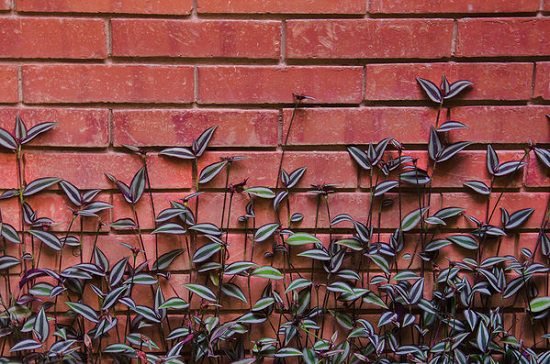
The variegated leaves resemble the stripes of the zebra, hence the name! The purplish-green foliage has a silver outer edge and white stripes running down lengthwise. It grows low to a height of 6-12 inches, and that’s why it can be grown as ground cover. It is one of the best types of wandering jew plants on the list.
3. Tradescantia pallida

It also goes by the name “Purple Heart” and is native to Mexico. Deep purple foliage, adorned with light purplish-pink flowers, looks marvelous and is the reason that it’s one of the most popular types of wandering jew plants! Apart from growing it as a striking ground cover, you can also have it in hanging baskets.
To know about more purple houseplants, click here !
4. tradescantia blossfeldiana.

Commonly known as the ‘Inch plant,’ it’s also referred to as Tradescantia cerinthoidebs . The thick green leaves have a fuzzy texture and a purple hue on the underside. You can easily propagate it from the cuttings, both in soil and water, once it gets growing. It bears delightful clusters of blue, purple, white, or rose pink flowers, making it one of the best types of wandering jew plants on the list.
5. Tradescantia Sillamontana

If precise geometric patterns are your thing, then you’ll love it because of its foliage. Growing from a thick succulent stem, the leaves are around two inches long and covered entirely in white hair. Magneta flower protrudes from the terminal end of the stem in summers.
6. Tradescantia spathacea
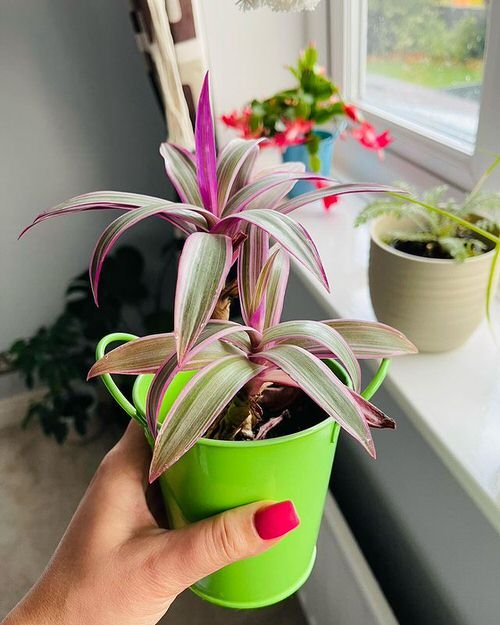
Known as Moses-in-a-basket, Oyster plant, or Boat lily, it is a sub-succulent herb from southern Mexico, Guatemala, and Belize. It grows in 6-12 inches long rosette and sword-like, narrow, and spiral-shaped dark green leaves, with purple bottom sides. The white flowers are enclosed with boat-like purple bracts, hence the name.
7. Tradescantia virginiana

Commonly known as the spider lily, it is a herbaceous perennial from the Commelinaceae family. The plant produces violet-purple to blue, three-petaled flowers, with yellow stamens and dark green arching leaves. You can grow this one of the most popular types of wandering jew plants under full to partial shade.
8. Tradescantia longipes
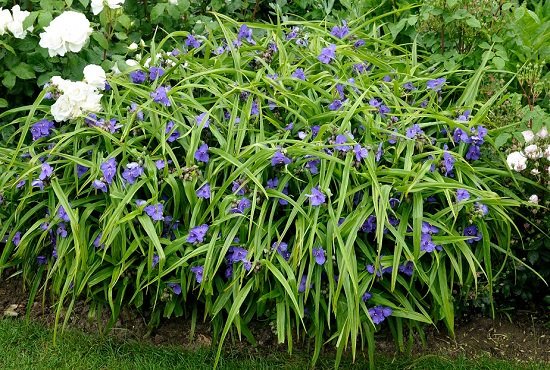
Adorn your garden by growing beautiful, purple-blue flowers of tradescantia longipes or spiderwort. It is native to Southern Missouri and northern Arkansas from the family Commelinaceae. Grow these three-petaled flowers for rock or naturalize gardens, in partial shade, by using well-drained, moist, acidic soil, making it one of the most popular types of wandering jew plants on the list!
Check out our article on indoor rock garden ideas here !
Wandering jew plant care tips.
- Grow a wandering jew plant in bright, indirect light or expose it to full sun, which it won’t mind either. Just keep in mind that low light can fade the markings on leaves.
- Water the plant directly around the roots, avoiding the crown, as it can result in rot.
- The plant prefers slightly moist soil, so maintain the right watering schedule.
- Use an all-purpose, water-soluble fertilizer, once a month, during the growing period.
Recent Posts
9 flowers with a lot of petals, grow unlimited basil plants in one pot this way, growing sage in pots | sage plant care in containers, 8 vegetables not to plant together and why, 100 best plant puns and plant jokes around the internet, 23 unique ways to grow cucumbers, 4 houseplants that remove carbon monoxide, 21 best walkable ground covers, join our 3 million followers:, related articles, 12 plants you can start with one cutting & a glass of water, 11 ways to train a wandering jew plant, 12 ways to grow zz plants in home and garden, how to propagate money tree | money tree propagation guide, how to flush plants without overwatering.
dO YOU NEED TO BRING A POTTED PLANT INDOORS DURING THE WINTER MONTHS?
Depends on the plant and where you live. Do research on the specific plant.
Sooooo number 4…. Is not a blossefeldiana. It’s a flumensis. …. You posted a tri-color-mundula variegata……. Not a nanouk. A nanouk is a blossefeldiana centerthoides
LEAVE A REPLY Cancel reply
Save my name, email, and website in this browser for the next time I comment.

Get the Best of BalconyGardenWeb Directly in your inbox.
POPULAR CATEGORY
- Best and Top of Gardening 1622
- Flowers & Blooms 671
- Growing Houseplants 601
- Gardening Guide 413
- Gardening Ideas 387
© 2023 Balcony Garden Web | All rights reserved
- Privacy Policy
- Terms of Service
- Feedback Page

Wandering Jew Plant (Tradescantia zebrina): Types, How to Grow and Care
Sharing is caring!
Plants with trailing and creeping habits are some of the best plants to keep. They are fast-growing and make thick carpet of groundcovers for gardens in no time and they also create striking hanging indoor plants.
Among the all-time best trailers to grow is the wandering jew. Easy to maintain and drapes beautifully, this colored plant will make any space more inviting and interesting.
Medicinal Properties
Propagation and maintenance, what is a wandering jew plant.
Tradescantia is one of the 37 genera under the plant family Commelinaceae (1). Some of its 75 species are commonly called ‘wandering jew’ (also known as inch plant), a name they adapted due to their long lifespan like the Jewish character from a Christian folklore.
Another name for this group of herbaceous perennial plants is ‘spiderwort’ after the spiderweb-like sap they produce when the stem breaks. They are native to Canada, Mexico, and Argentina and have been naturalized in other parts of the world (2).
The most common tradescantia grown ornamentally is the T. zebrina also previously called Zebrina pendula . It has long fleshy stems where the wandering jew plant leaves and roots appear. The lance-like leaves are a mixture of green and purple with silver stripes on the upper side and deep purple under (3). The plant grows close to the ground and can only reach 20 to 30 cm high.
Does Tradescantia Zebrina Flower?
The wandering jew is considered an ornamental plant primarily because of its showy colorful foliage but the plant does produce pink flowers.
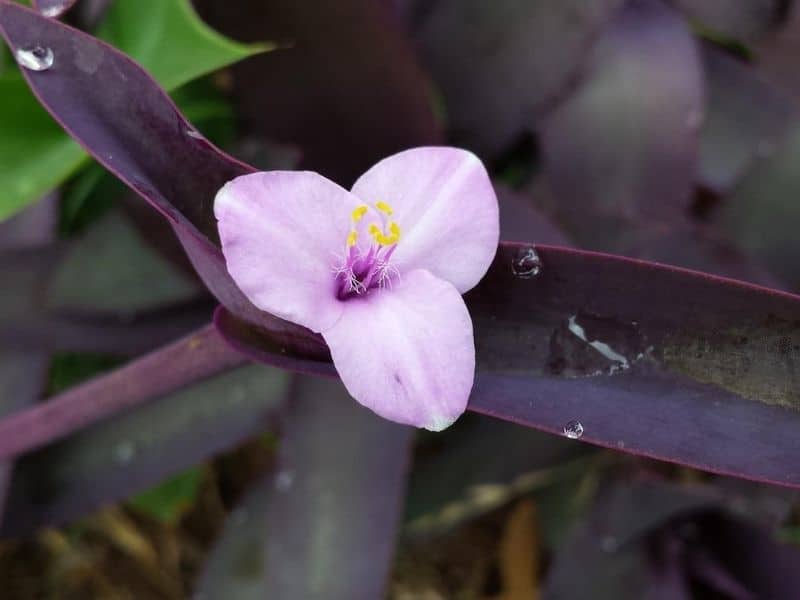
Small three-petaled pinkish purple flowers appear sporadically throughout the year (4). The resulting fruit is a capsule containing tiny brown seeds.
Is it Toxic to Pets?
Spiderworts are normally harmless plants but they contain toxic properties that may cause mild gastric problems and dermatitis to pets. Although they don’t lead to anything serious, it will be safe to keep the plants out of reach of pets and to keep the hands protected when dealing with the sap of the plant.
Because of the plant’s hardiness and adaptability to different environments, the wandering jew establishes well, in fact so well that it can be considered an invasive species. In countries like Australia, the plant has the capacity to invade natural vegetation. Although growing them is not prohibited, everyone is obliged to keep the plant’s growth under control (5).
Studies showed that Tradescantia has significant effects as an anticancer, antioxidant, and antibacterial medicinal plant. In traditional Chinese medicine, the wandering jew plant is highly valued as treatment for kidney failure.
The extract from the whole plant is cooked with dates, ginger, and water and consumed by patients. The plant is also known to treat high blood pressure, cough, urinary tract infection and tuberculosis (1).
How to Grow and Care for a Tradescantia
Here’s how to care for a wandering jew plant, one of the easy house plants to own.
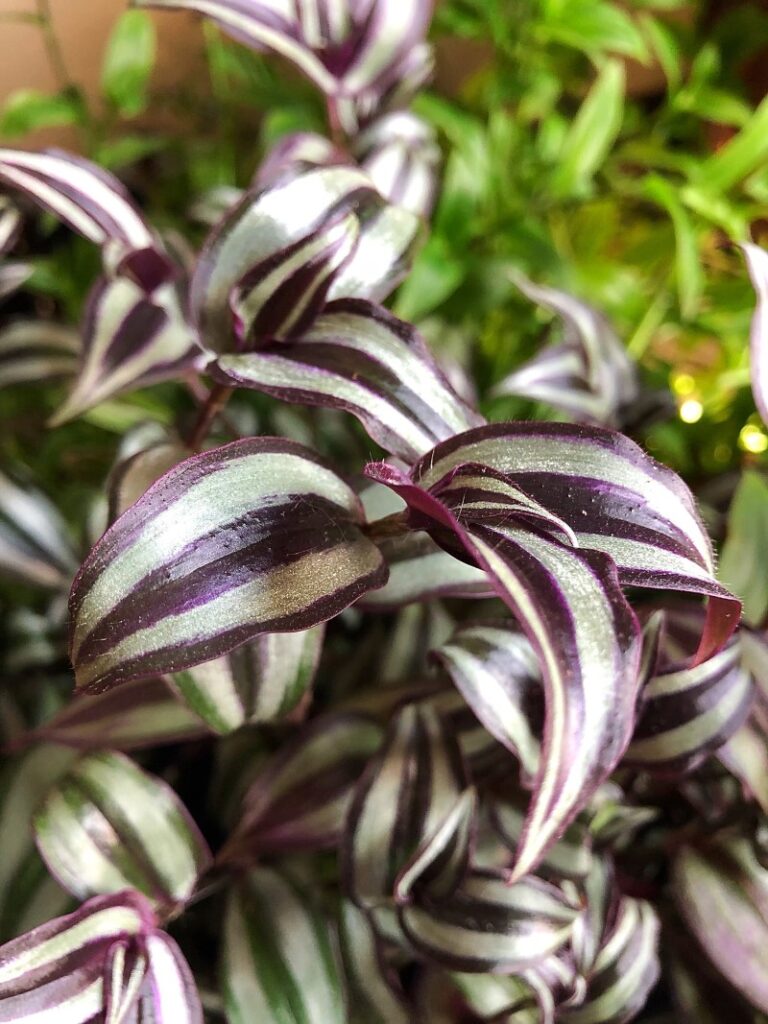
Light and Water
In the wild, the wandering jew plant thrives without assistance but under the right conditions. It likes filtered sun so indoor fluorescent light is enough. Placing them by the window and turning the plant every two weeks will keep the leaves colorful and the growth even on all sides (3).
The plant spreads easily in damp areas that’s why it naturally grows along riverbanks and roadsides. When potted, the soil should be kept moist but well-drained. Saturated soil often causes root rot.
Fertilize your Tradescantia plant once a month during the growing season (spring and summer) with a balanced, water-soluble fertilizer diluted to half strength. Avoid fertilizing in fall and winter when the plant is dormant. Over-fertilizing can lead to fertilizer burn and damage the plant, so follow the instructions on the fertilizer package carefully.
Temperature and Humidity
Spiderworts like it warm but there should be enough air circulation or else the leaves will sag. During the heat of the summer, taking the plant outside under shade will provide the necessary cool to the plant.
Mist the hanging plant early in the morning and late in the afternoon. If the plant is on a table, place a glass of water beneath the leaves or put the pot on a wet pebble tray. This will humidify the immediate vicinity of the plant aiding in its photosynthesis and transpiration processes.
Pests and Diseases
The most common living enemies of the wandering jew are aphids, mealybugs, scale, white flies, and spider mites. Manual removal at the onset of infestation is effective but they should be closely monitored as serious attack may lead to the plant’s death. If left unnoticed and the infestation has become severe, get rid of the plant by burning to avoid contamination.
Since the creeping inch plant is mainly soft almost like a succulent, soggy soil and too wet conditions lead to root and stem rot (4). As long as the plant is receiving just enough moisture, this disease will be avoided.
Propagating wandering jew plants is very easy. They can grow from seeds but will take years to establish so the more convenient stem cutting is best. The trailing or creeping stems form nodules where the roots will eventually grow as it comes in contact with the potting soil (2). When the hanging plant has longer trails than intended, it can be trimmed and the resulting stem cuttings can be rooted to form new plants.
There will be times that the potted wandering jew will become leggy, especially if it’s been receiving more shade. To promote a bushier growth pinch back by literally pinching the tip of the plant where the new growth occurs (4). This practice allows the formation of lateral stems.
In two or three years, these hardy plants may become pot bound, with the roots taking up most of the space in the pot. Repot in a larger container with a good mixture of soil, coarse sand, and compost to replenish the nutrients and provide room for the roots to breathe. Additionally, fertilize once every two months by foliar application just to improve plant vigor.
Common Varieties of Wandering Jew
The oldest and most common indoor wandering jew, this species has leaves alternating, often overlapping when young, purple leaves with silvery green thick stripes and solid purple underside. The stem is also a mixture of purple and green.
T. blossfeldiana
The leaves of this species are quite thicker, glossy, and covered in miniscule hairs called trichomes. The three-petalled flower is an ombre of white and pinkish purple with yellow anthers.
T. fluminensis ‘Tricolor’
This attractive variety showcases leaves with white, lilac, and green variegation. It appears smaller than the common wandering jew but bushier in form.
T. sillamontana
This whimsical species looks frosted with its silvery trichomes covering the entire plant. The green leaves are still alternately arranged but more compact which make a potted plant look more bushy than trailing. The light color of the leaves provide a complementing backdrop to the bright purple flowers.
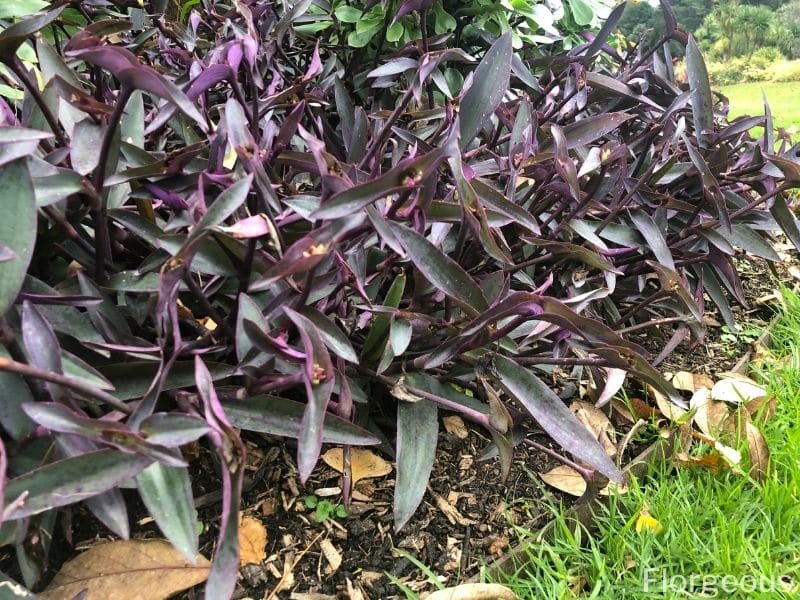
The leaves and stems of this species are in striking deep purple color hence the common name ‘ purple heart ’. Under shaded, they turn a hint of dull green. The leaves are also longer and have wider space in between.
Does Wandering Jew plant need full sun?
Wandering Jew plants (Tradescantia zebrina) prefer bright indirect light but can tolerate some direct sun, especially in the morning or late afternoon. However, prolonged exposure to intense sunlight may cause their dark green leaves to scorch.
How do you care for a wandering Jew plant indoors?
To care for a Wandering Jew plant indoors, place it in a location with bright, indirect sunlight, such as near a window. Water it when the top inch of soil feels dry, typically every 1-2 weeks, and provide well-draining soil. Additionally, mist the plant occasionally to increase humidity and remove dust from the leaves.
How do I make my Wandering Jew fuller?
To make your Wandering Jew plant fuller, prune it regularly to encourage branching and bushier growth. Pinch off the tips of the stems or trim back leggy growth to promote new growth and create a more compact appearance. You can also propagate wandering jew cuttings to create new plants and fill out the pot.
How long do Wandering Jew plants live?
Wandering Jew plants are generally long-lived when provided with proper care. With the right growing conditions indoors, they can thrive for several years, often becoming fuller and more lush over time with regular pruning and maintenance.
Reference List
(1) Dash, G., et. al. Tradescantia zebrina: A Promising Medicinal Plant. 2017. IAJPS, 4 (10). P. 3498-3502 .
(2) Arakelyan, H. Tradescantia zebrina- Mother Nature Healing. 2019. Researchgate.
(3) Vermeulen, N. Encyclopedia of House Plants. Taylor and Francis. 1999. P. 320.
(4) North Carolina State Extension. Tradescantia zebrina. NC State University. 2018. https://plants.ces.ncsu.edu/plants/tradescantia-zebrina/ . Accessed on 12 August 2020.
(5) The State of Queensland. IPA-Zebrina. Department of Agriculture and Fisheries. 2020. https://www.daf.qld.gov.au/__data/assets/pdf_file/0020/51284/IPA-Zebrina-PP102.pdf . Accesed on 12 August 2020.
Photo by Wirestock/depositphotos
Have you seen these?

Overwatered Lantana: Identifying, Fixing, and Preventing Water Damage

Overwatered Petunias: Signs, Damages, and Recovery Steps

Overwatered Pumpkin Plant: A Comprehensive Guide to Rescue and Prevention

Overwatered Dogwood Tree: Causes, Symptoms, and Revival Techniques

Overwatered Lavender: A Comprehensive Guide to Prevention and Recovery

Overwatered Geraniums: Comprehensive Guide to Causes, Signs, and Recovery Strategies
About the author.
Home » House Plants » Wandering Jew
Bolivian Wandering Jew Care: Learn How To Grow Callisia Repens

Best known by the common name Bolivian Wandering Jew or creeping inch plant, Callisia repens (kal-LIZ-ee-uh REE-penz) is a member of the spiderwort (Commelinaceae) family. Native throughout South America, the Caribbean, and Central America.
However, it has gained some popularity in the United States as a perennial ground cover in the southernmost regions and as an annual or indoor plant in cooler areas.

The Bolivian Jew plant has a variety of other nicknames, most of which have variations.
These common names include:
- Chain Plant
- Creeping Basket Plant
- Creeping Inch Plant
- Dwarf Wandering Jew
- Itsy Bitsy Inch Plant
- Little Jewel
- Tiny Buttons
- Turtle Vine
An easy to grow plant, dwarf wandering Jew is similar in appearance to both Tradescantia fluminensis and the striped inch plant (Callisia elegans).
They can be differentiated by the leaves, green with purple spotting and purple underside on the wandering turtle vine, green with white stripes and purple underside on the striped inch plant, and glossy green leaves (sometimes with white stripes) with a green underside.
Bolivian Wandering Jew Quick Care Tips
- Botanical Name: Callisia Repens Common Name(s): Turtle Vine, Inch Plant, Creeping Inch Plant, Bolivian Wandering Jew Synonyms: Callisia fragrans, Spironema fragrans, Tradescantia repens Family & Origin: Commelinaceae family, native to Central and South America Growability: Easy to grow Grow Zone: USDA zones 10-11 Size: Grows up to 12 inches tall and spreads up to 24 inches wide Flowering: Small white flowers bloom in the summer Light: Bright, indirect light Humidity: Prefers high humidity but can tolerate average humidity levels Temperature: Thrives in temperature not lower than 60°F Soil: Well-draining soil Water: Water when the top inch of soil is dry, do not overwater Fertilizer: Fertilize once a month during the growing season with a balanced fertilizer Pests & Diseases: Susceptible to spider mites and mealybugs, can also be affected by root rot if overwatered Propagation: Propagate through stem cuttings or division Plant Uses: Makes a great trailing plant for hanging baskets or as ground cover in a terrarium. Can also be used as a low-maintenance houseplant.
Another related species called purple succulent (Callisia fragrans) has large leaves in comparison to the others.
The flowers also differentiate wandering Jew from several other similar species. Tahitian bridal veil (Gibasis pellucida) has loose, stalked clusters of flowers. The hairy wandering Jew (Commelina benghalensis), native wandering Jew (Commelina diffusa), and zebrina ( Tradescantia zebrina ) all have blue or pink flowers.
Dwarf Bolivian Wandering Jew Care
Size & growth.
The Callisia Repens plant is a trailing plant with an overall height of between 4” and 12” inches and long, creeping low growing stems which stretch up to 2’ feet.

The stems have frequent branching from which small roots grow. Its small, alternating leaves are densely packed, shrinking in size the further out from the plant’s core they get.
Flowering and Fragrance
The small white flowers bloom throughout summer into autumn, sprouting in stalkless clusters in the forks of the upper leaves. These hermaphrodite flower clusters are odorless and tend to appear in pairs.
The flowers have three white petals and up to six stamens with smooth filaments. Tiny oblong seed capsules containing four rough brown seeds emerge after fertilization.
Light & Temperature
Callisia Repens plants prefers full sun to partial shade. Access to bright light helps keep the plant healthy and reduce the risk of it becoming straggly.
Outdoors, this vine plant fares best in USDA hardiness zones 10 to 11. However, cuttings can overwinter indoors in colder climates.

Meanwhile, it may also be grown as a houseplant in a sunny spot that never drops below 60° degrees Fahrenheit.
Watering and Feeding Callisia Repens
Dwarf Jew plant benefits from regular watering to ensure the soil remains moist during the growing season. Occasional misting of the foliage also helps to keep leaves from drying out and developing brown marks.
Avoid overwatering and allow the surface of the turtle vine soil to dry out during the winter.

During summer, a bit of liquid fertilizer every 10 to 14 days will encourage dense foliage.
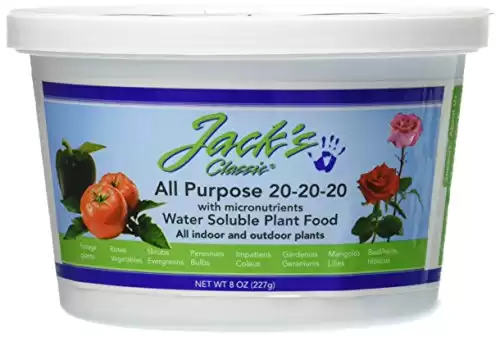
Soil & Transplanting
When used as potted plants or in a hanging basket, turtle vine does best in a standard potting mix or a peat mix. A similarly, organic-rich soil works well when planting in a garden.
Grooming And Maintenance
While the turtle vine requires very little maintenance overall, pinching the stem tips will help the turtle vine stay compact. Additionally, they may become leggy after two years. At that point, you may choose to replace them with a cutting.

How To Propagate Callisia Repens
While Callisia Repens may propagate through seeds, the easiest method is to use 2” inch stem cuttings in spring or early summer.
Place the cuttings where you wish to grow the plant and lightly cover with soil. If kept moist, the cuttings will take root, and new leaves will begin showing in only a few days.

Callisia Repens Pest or Disease Problems
Bolivian Callisia repens is resistant to most pests, although low humidity will attract red spider mites , who like to build their webs along the stem tips. Misting the foliage makes the plants less attractive to these pests.
Both cats and dogs may experience a red, itchy rash when coming into contact with the plant. Additionally, this plant is known to contain calcium oxalate crystals, which may pose a problem when ingested by most pets.
While not considered invasive in the US, the Bolivian Jew plant has caused problems in Australia and a few other countries. It may also be considered a weed when allowed to grow wild.
Suggested Callisia Repens (Bolivian Wandering Jew Vine) Uses
Dwarf Bolivian wandering Jew makes a great hanging plant. It can be used inside as a houseplant or outside as a dense, mat-like ground cover.

These beautiful plants are also a great addition to fairy gardens.
Reptile owners sometimes use the turtle vine to feed their pets, especially tortoises. When given in moderation, it is considered relatively safe despite the presence of calcium oxalate.
JOIN Our FREE Plant Care Newsletter
By entering your email address you agree to receive a daily email newsletter from Plant Care Today. We'll respect your privacy and unsubscribe at any time.
Wandering Jew Plant

A Perfect Choice for First-Time Plant Owners
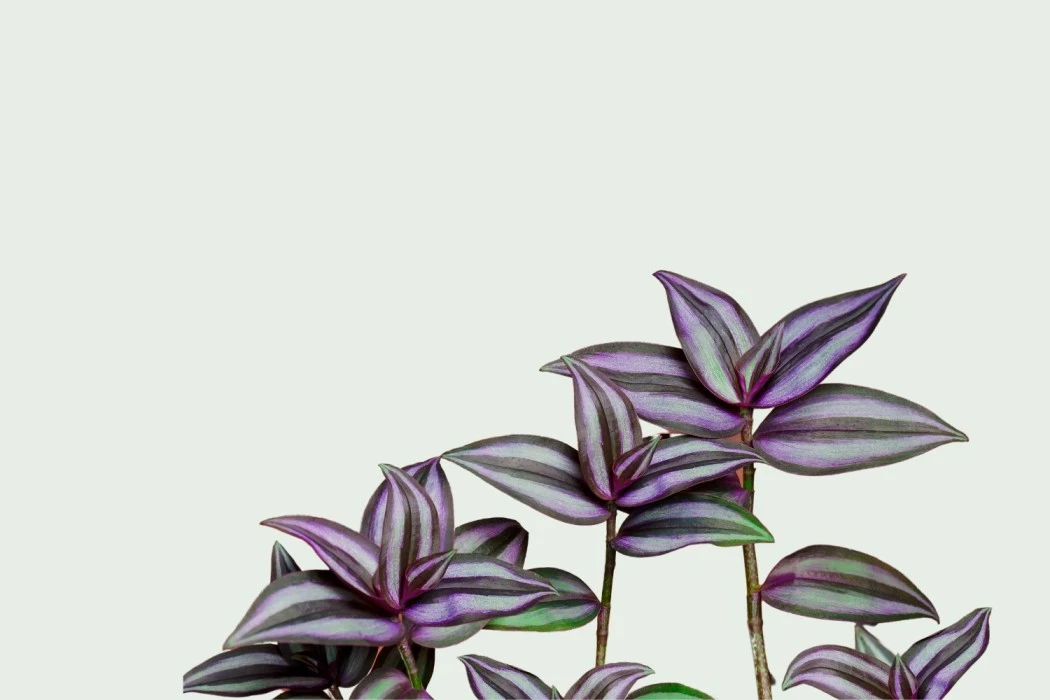
Get to know us
Growing problems in wandering jew plants.
Yellowing leaves may result from excessive sunlight. Relocate your inch plant to a spot with bright, indirect light or propagate a cutting for a new planting. Prolonged soil moisture can stress the plant, fostering rot. Adjust watering accordingly.
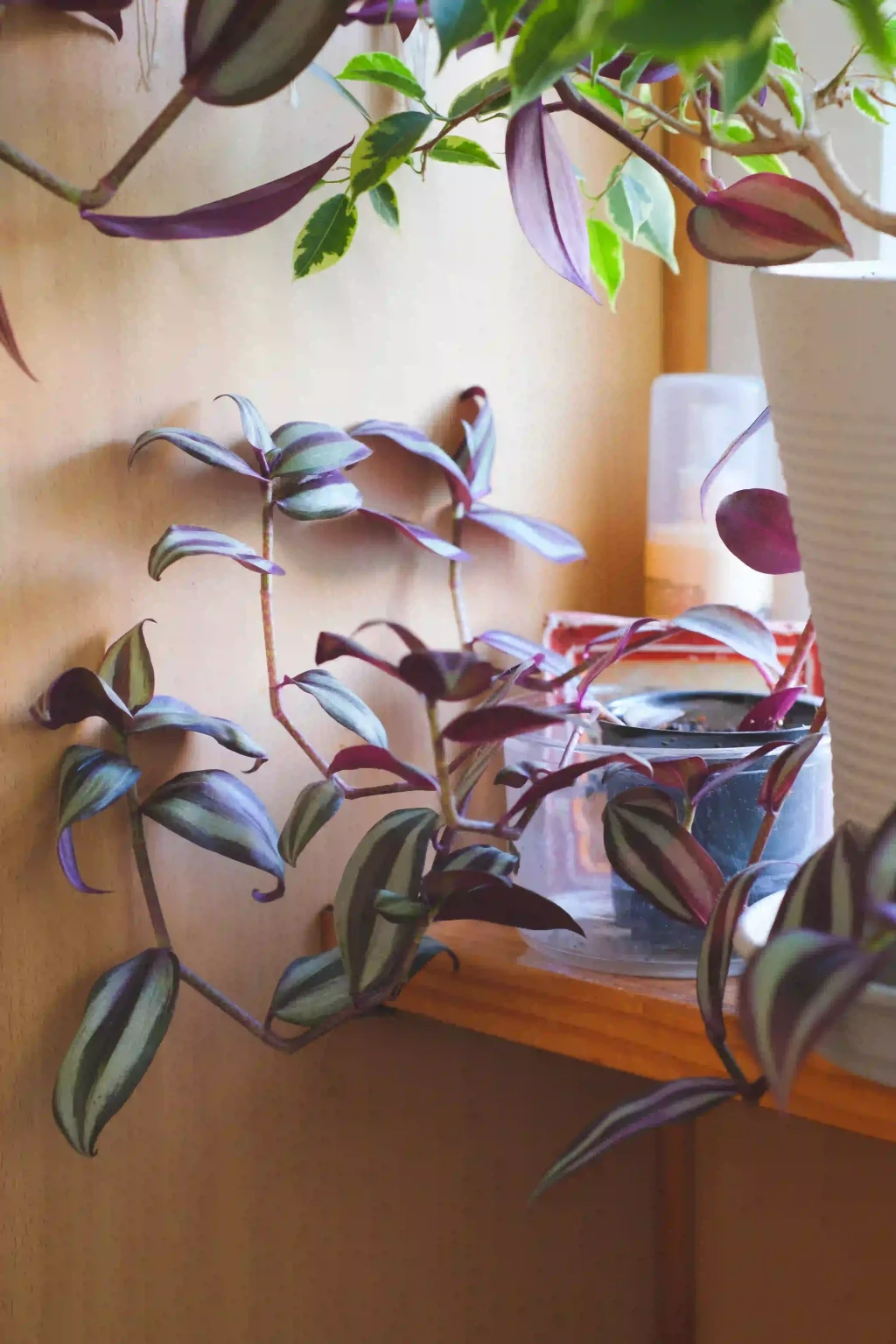
Dealing with Pests in Wandering Jew Plants
Spider mites are the primary pests for wandering jew plants. They thrive in warm, dry environments, so maintaining high humidity or misting your wandering jew plant is an effective countermeasure.
If these methods prove ineffective, try rinsing the plant with water to dislodge the mites. For more severe infestations, consider removing affected areas and employing a systemic insecticide.
Aphids also extract sap from the leaves of wandering jew plants. When cultivating these plants indoors, transport them outside for treatment with neem oil or a forceful water stream. Ensure follow-up applications every 7 to 10 days if aphids persist.
Addressing Common Issues in Wandering Jew Plant
- Overwatering
- Soil retaining excessive water
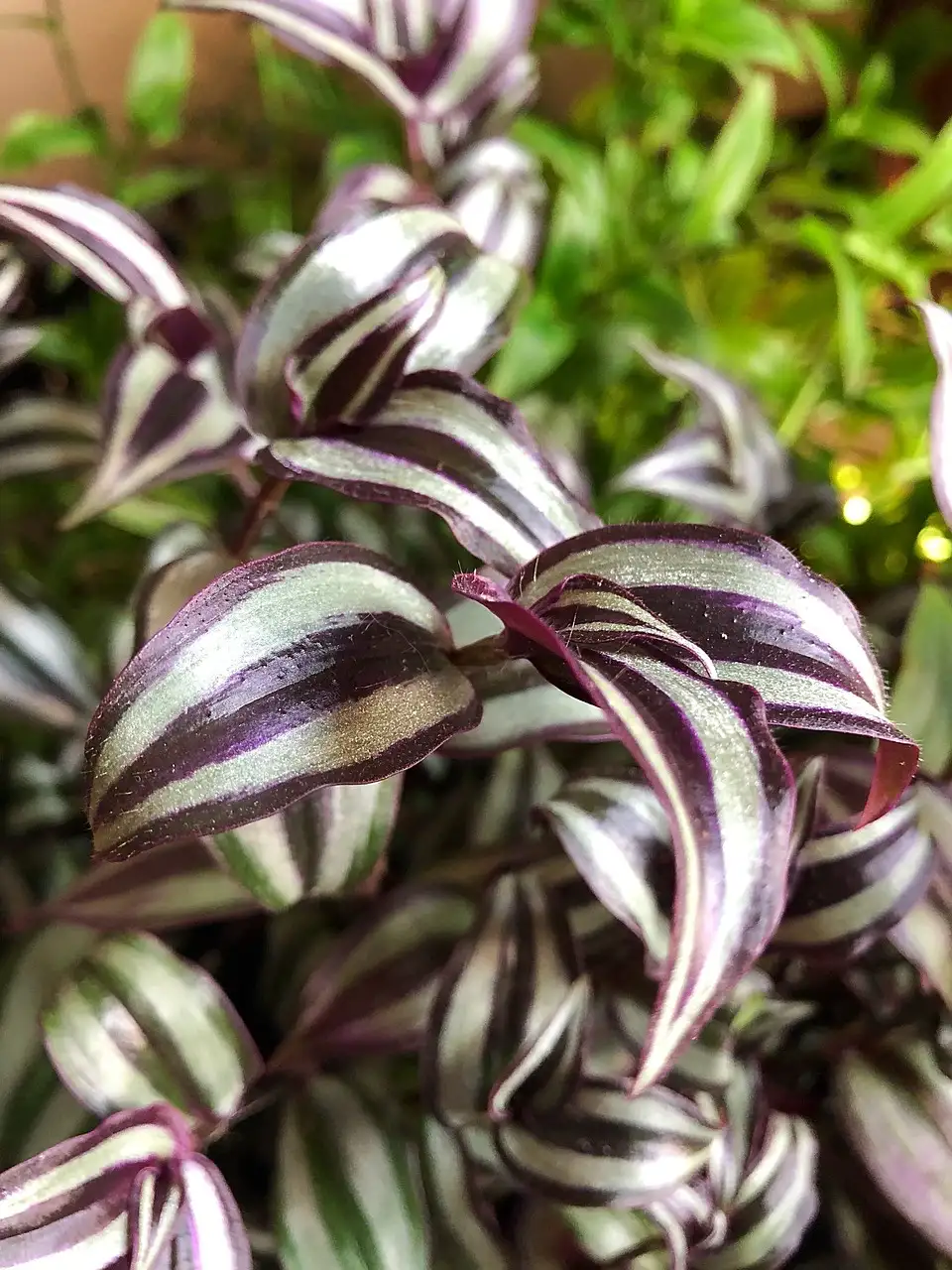
Wandering Jew Plant Care (Indoor & Outdoor)
Wandering jews display particular sensitivity to receiving the correct light dosage. They require ample light for maintaining their vibrant color, but exposing their leaves to direct sunlight can result in burns (except for the purple queen variety, which thrives in full sun).
The optimal position for cultivating them indoors is a window facing east or west. This way, they receive abundant natural light during the morning/evening and bright, indirect sunlight for the remainder of the day.
Insufficient light exposure leads to a fading and dull appearance of their leaves. Thus, if a location with abundant natural sunlight is unavailable, incorporating a grow light is advisable.
However, if the decision is made to transfer the inch plant outdoors for the summer, it is crucial to place it in a shaded or partially shaded area, sheltered from the intense afternoon sun.
The wandering jew plant prefers its potting mixture to remain consistently moist but not excessively saturated. In situations with indirect light, hydrate your wandering jew plant once a week or when the upper layer of soil becomes arid. Ensure that the soil never reaches complete dryness.
Nevertheless, when irrigating your desiccated potting mixture, administer water in intervals to guarantee thorough absorption by the soil, preventing it from simply flowing out of the planter. Apply a small amount of water, pause for a while to allow the soil to soak it up, and then proceed with watering until it drains from the planter’s bottom drainage hole.
The soil for your wandering jew is suitable for a conventional houseplant potting blend, yet they will thrive even more in soil enriched with additional organic material.
Enrich your potting mixture by incorporating some organic compost, perlite, and peat moss. Strive for the optimal equilibrium between retaining water and facilitating drainage. Water the plant and observe the soil’s tendency, then make adjustments accordingly. The preferred soil pH falls within the range of 5 to 6.
Another crucial aspect of effective wandering jew plant care is humidity, and a substantial amount is required. When the humidity drops too low, the leaves will begin to brown and wither.
This becomes particularly challenging when cultivating them indoors in the winter season, as the air inside our homes tends to be excessively dry. Therefore, maintaining high humidity levels is of utmost importance.
A convenient method to elevate humidity is by operating a nearby humidifier. Additionally, it is advisable to place an indoor humidity monitor close to your inch plant.
You may also place the pot on a pebble tray filled with water (avoiding soaking) or opt for growing it in a small plant cloche or a miniature indoor greenhouse.
Temperature and Humidity
Your inch plant thrives most in a temperature range of 60 degrees Fahrenheit to 80 degrees Fahrenheit. Exposure to frost can be fatal to the plant. However, in USDA hardiness zones 9 through 11, the plant might endure light frosts. In these regions, if the leaves wither, there’s a chance the plant will revive in the spring.
When the external temperature consistently drops below 60 degrees Fahrenheit, container-grown plants should be relocated indoors. While intense heat can scorch the leaves, the plant can endure high temperatures much better than it can tolerate cold.
An optimal relative humidity of 70% is recommended for Tradescantia plants. Indoors, achieving the right humidity level can be accomplished by utilizing a plant humidifier or misting the plants daily with filtered or distilled water.
The Inch plant generally doesn’t necessitate specific pruning. Pruning becomes relevant for the creeping inch plant in two scenarios: firstly, to eliminate withered foliage, and secondly, to govern the plant’s shape and growth pattern. If left unattended, the spiderwort plant tends to become leggy; to maintain a fuller appearance, periodically prune the stems or pinch back at least one-fourth of the branch length.
Utilize sharp and clean pruning shears or scissors to trim stems to the desired length, cutting at an angle between leaf nodes. To eliminate dead or yellowing leaves, simply pinch them away, ensuring the leaf stalk is also detached from the main stem.
Fertilizing
Spiderwort plants typically don’t require regular fertilization as part of their routine care. However, they can certainly benefit from occasional nourishment.
Feeding is only necessary during spring through summer; refrain from fertilizing in the fall or winter. Winter growth tends to be weak and leggy, and encouraging that is not desirable.
You can nourish your plant monthly with a liquid fertilizer diluted to half strength. I suggest opting for organic plant food over synthetic alternatives, as wandering dudes can be sensitive to chemical fertilizers.
A quality organic general-purpose fertilizer or compost tea would be excellent choices. If you prefer, you can also incorporate slow-release organic granules into the soil.
Fish emulsion and liquid kelp are also effective options, but it’s advisable to use them outdoors as they can emit a strong odor when used indoors.

Wandering Jew Plant Benefits
Tradescantia Zebrina isn’t merely aesthetically pleasing; it functions as an inherent air purifier. Positioned in your living area, it diligently eliminates undesirable substances such as formaldehyde and xylene. There are numerous advantages to Wandering Jew plants that render cultivating the plant somewhat worthwhile. Let’s Take a look at the primary benefits of Wandering Jew plants.
Aesthetic allure
Owing to their splendid visual appeal, Wandering Jew plants are predominantly retained in households and gardens as embellishments. They are ideal for suspended baskets or containers. Their beautiful deep purple, emerald green, and silver streaks impart a distinctive taste to every room in your residence!
Upon reaching maturity, Wandering Jew plants also commence flowering. They showcase stunning blossoms.
Purify Air
Inch plant (Wandering Jew), also recognized as Tradescantia zebrina, has gained popularity due to its captivating, exotic foliage. Its appealing oval-shaped leaves can appear in silvery, purple, and green hues. This resilient and easily-managed plant also boasts numerous small purple, white, and pink flowers that develop along the length of slender stems, reaching a height of up to three feet.
Not only are Inch plants visually pleasing, but they also contribute to indoor air purification. Emitting oxygen, they absorb pollutants and diminish allergenic dust mites in indoor environments; this makes them an optimal choice for enhancing indoor air quality. As per alive, this indoor plant reduces benzene, TCE, toluene, and terpenes.
A pleasant present
Houseplants might not be the initial consideration when pondering gifts, but they serve as the flawless means to bring a smile to someone’s face on any occasion.
The perfect gift for every special event, whether commemorating a holiday, advancement, engagement, or property ownership, could be a houseplant gift.
Opting for a Wandering Jew plant is among the finest choices for gifts. They are available in vibrant varieties, are uncomplicated to cultivate, and have a reasonably compact size.
Medicinal uses
To take advantage of the healing abilities of the Wandering Jew plant, the leaves and stems are mainly used which are processed in different ways such as decoctions and teas. Being an antioxidants-rich plant, it aids in general health by deactivating the free radicals and also fighting inflammation. Its properties as an an anti-inflammatory and also antimicrobial agent make it a natural treatment for the conditions such as nephritis and also urinary tract infections.
Furthermore, the infusion of the plant is widely used in Malaysia to enhance the kidney performance and also preserve the health of the urinary system. Research suggests a possible anti-arrhythmic effect, which is very good for the cardiovascular system, but further studies are definitely required to understand and develop this benefit.
Reducing Stress
Based on research, incorporating plants into your residence or workplace can contribute to a sense of ease, tranquility, and connection with nature. Consequently, placing Wandering Jew plants throughout your dwelling could aid in reducing tension and stress, enhancing your efficiency.
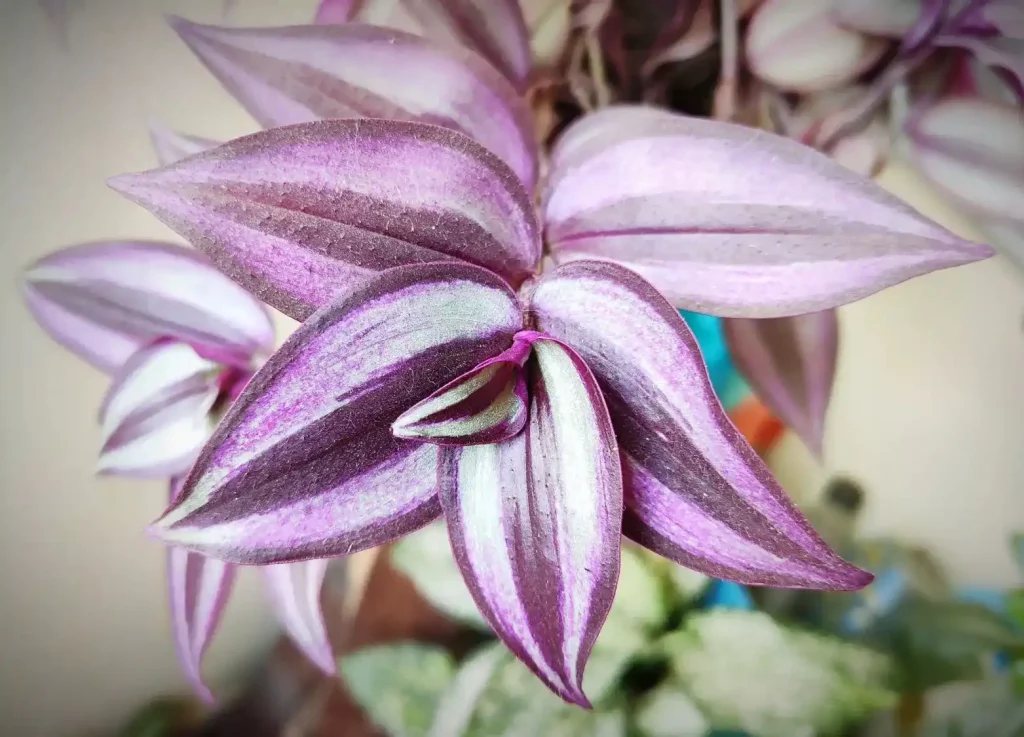
Quicks Facts About Wandering Jew Plant
Key Details about Wandering Jew Plants:
- Scientific Name: Zebrina pendula
- Common Names: Wandering Jew
- Propagation: Layering, Stem Cuttings
- Watering: Drench, Allow to Dry
- Humidity: Typical Home Levels
- Light Requirement: Bright to Filtered Light
- Potting Mix: All-Purpose
- Temperature: Indoor Settings
- Fertilization: Balanced
- Care Rating: Very Easy
- Decorative Use: Hanging Baskets, Tables
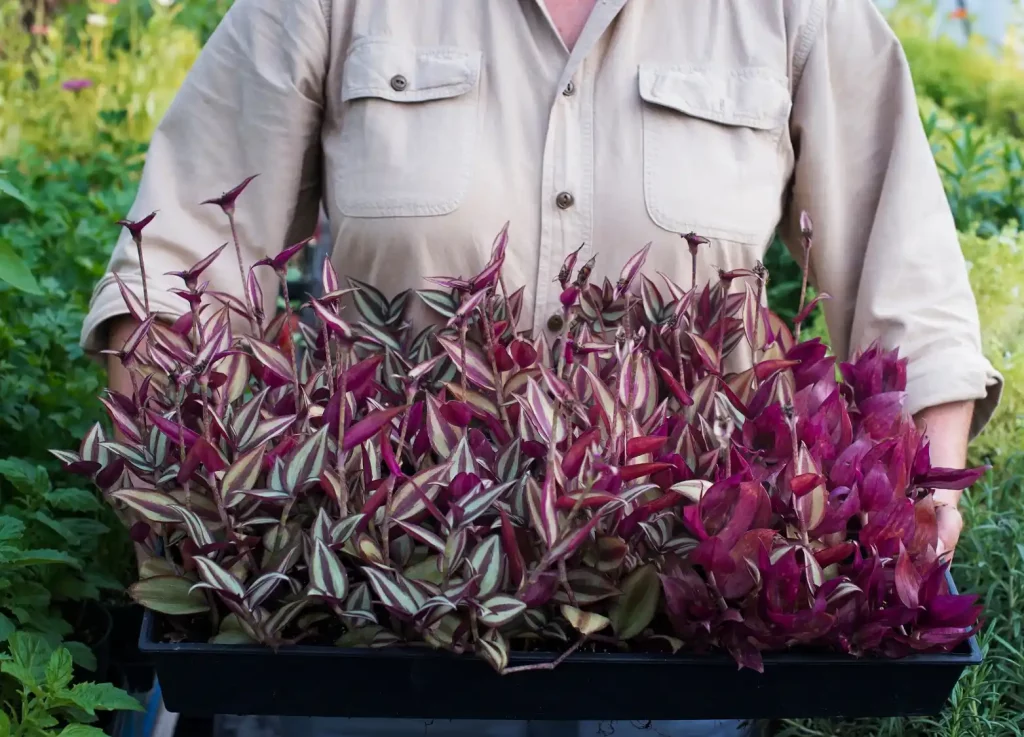
Our Gallery
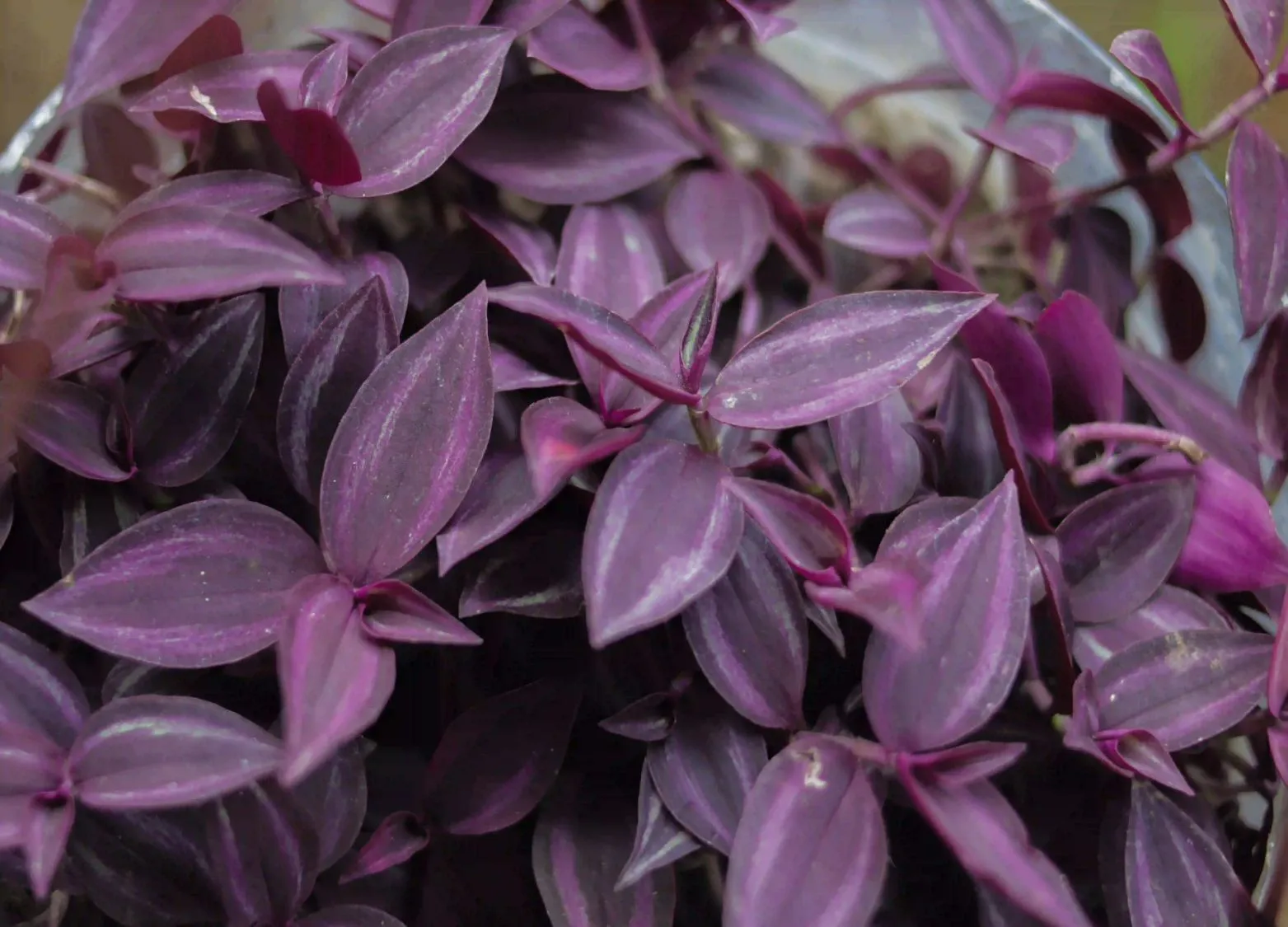
Planting and Propagating the Wandering Jew
Year-Round Propagation of Tradescantia Plants: Soil and Water Methods Propagating Wandering Jew through Soil
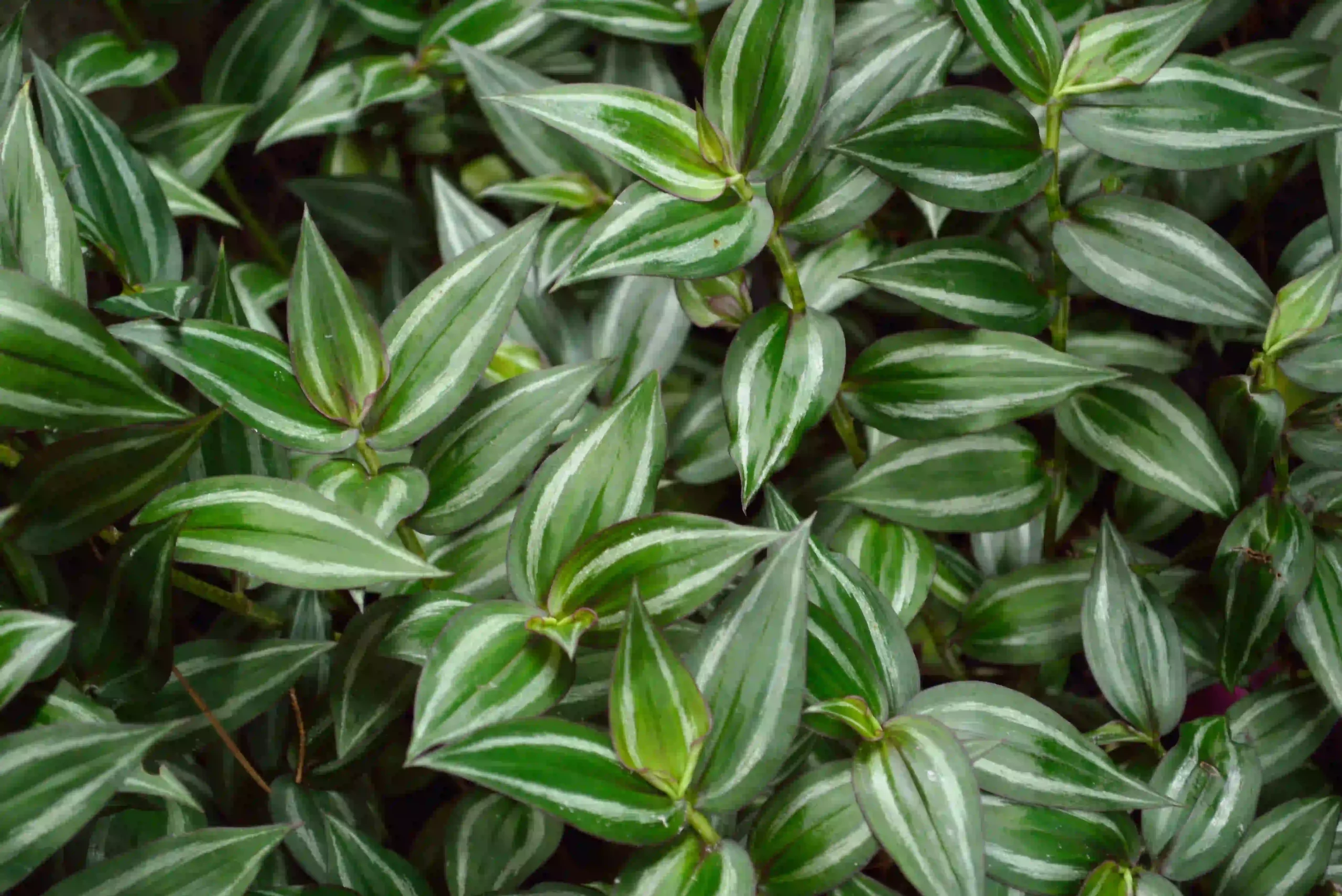
Propagating Wandering Jew through Soil
To propagate Wandering Jew in soil, take 4-6 inch cuttings, remove lower leaves, and plant them in a 6-inch pot filled with all-purpose soil. Keep the soil consistently moist, place in indirect light, and enjoy a vibrant new plant in a few months.
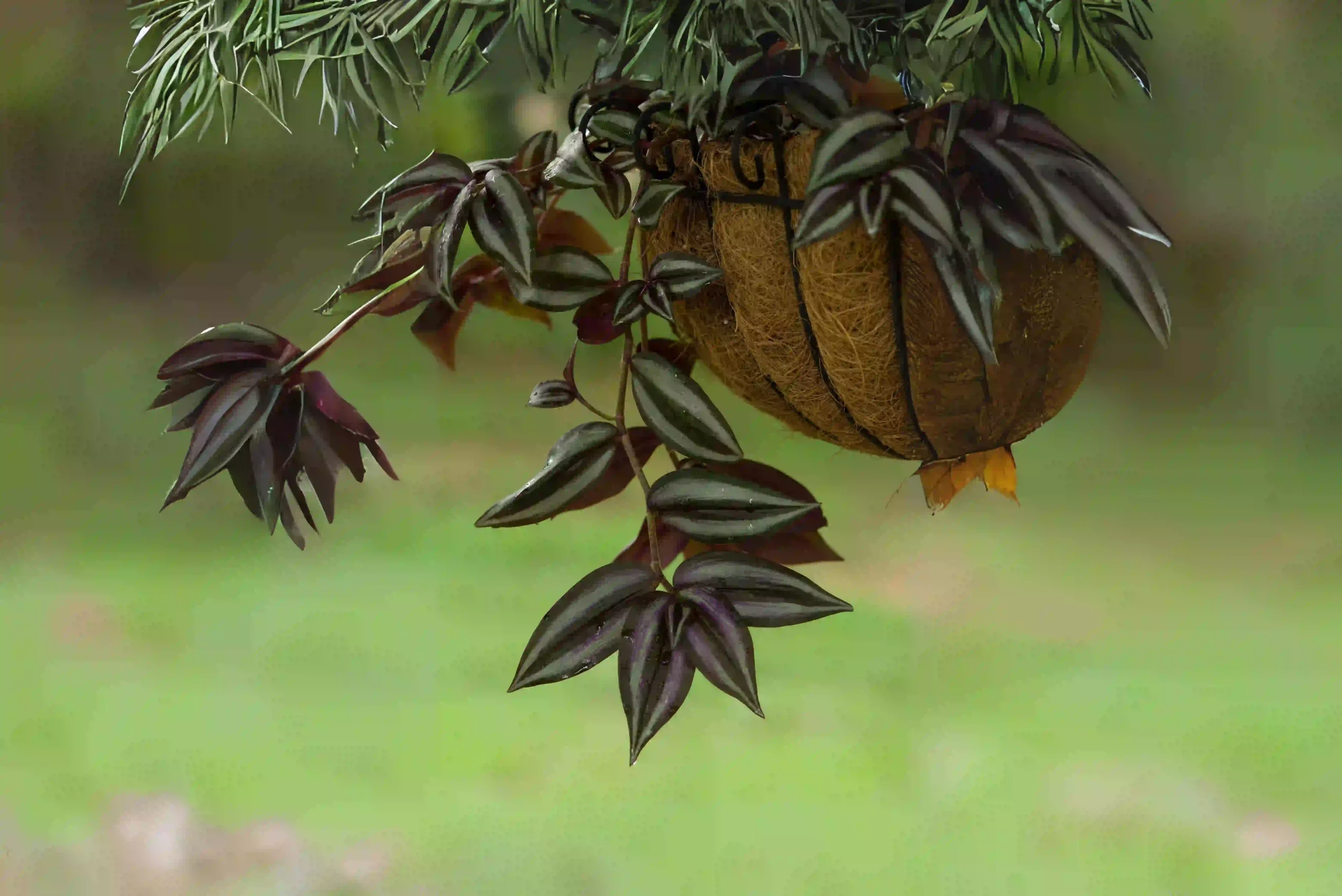
Propagating Wandering Jew through Water
To propagate Wandering Jew in water, make 4-6 inch cuttings beneath a leaf node, remove lower leaves, and submerge them in a glass or jar. After about a week, transfer the rooted cuttings to all-purpose potting mix, continuing standard care as the new roots develop.
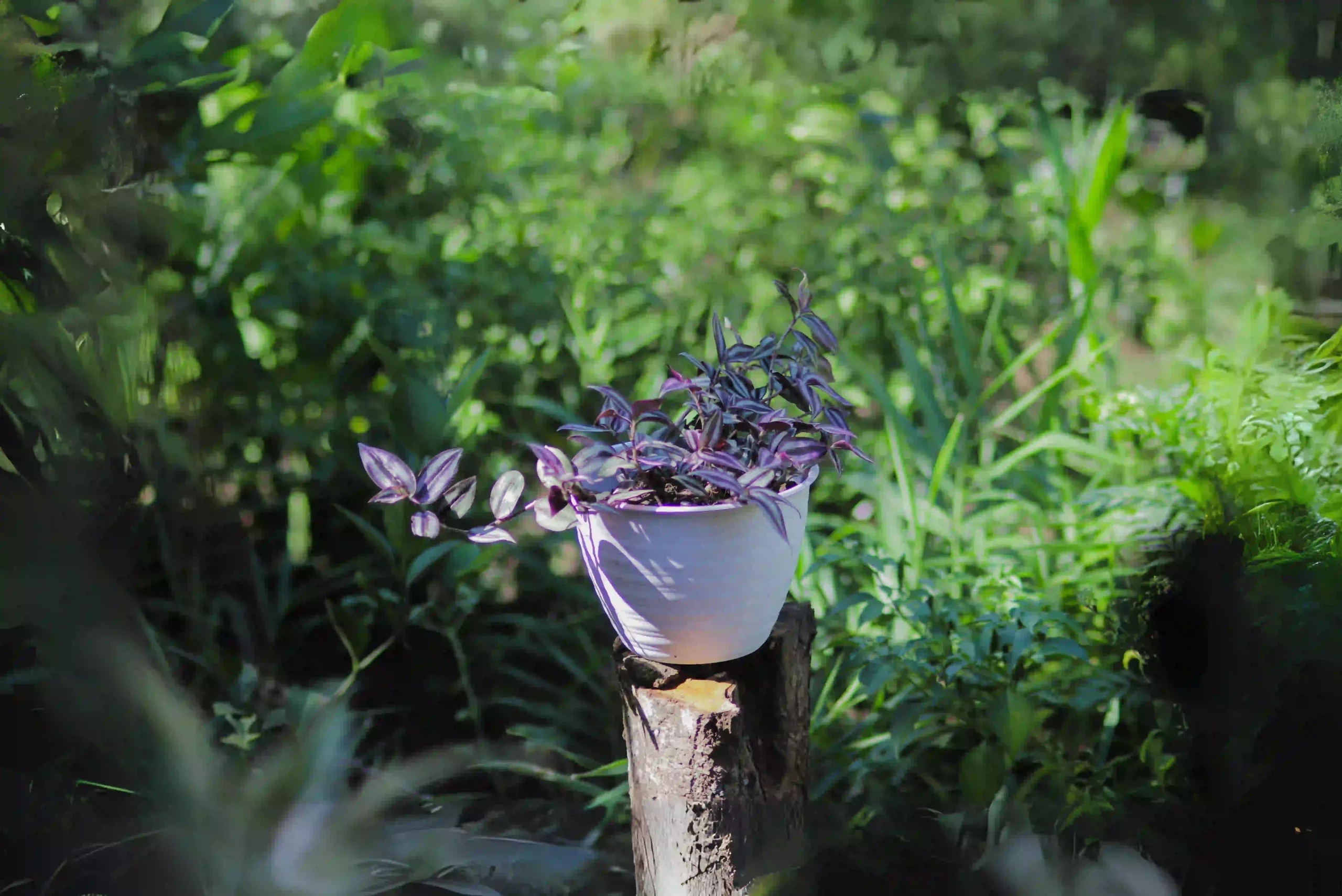
Repotting Wandering Jew Plant
Repot your Wandering Jew every two or three seasons in a slightly wider pot for healthier growth. Use porous containers, add fresh soil, and handle stems with care during the transfer, saving any fallen ones for replanting.
Let See the Review
Testimonials.
Designation
Lorem ipsum dolor sit amet, consectetur adipiscing elit, sed do eiusmod tempor incididunt ut labore et dolore magna aliqua.

How to Take care of a wandering plants indoor
Introduction The Wandering Jew plant scientifically known as Tradescantia zebrina is one of the most beautiful house plants...
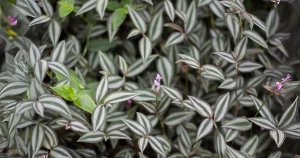
How to Take Care of Your Wandering Jew Plant
Introduction Regardless of whether you are an expert gardener or just a beginner, taking care of this Striped...
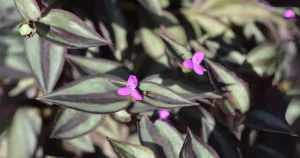
Reviving Your Wandering Jew Plant: Troubleshooting Tips for a Dying Base
Introduction Do you feel like you can't maintain the Wandering Jew plant in its best conditions? Have you...

Wandering Jew Plant
Table of Contents
A Wandering Jew plant, Tradescantia , is a fast growing, easy to care for plant that looks beautiful hanging in front of a window that gets bright, indirect light but no direct sun. Popular nicknames are “Inch Plant” or Spiderwort. Originally found growing as a 1-2ft tall wildflower in Canada and all the way south to Argentina, today a wandering jew plant is both a popular indoor and outdoor plant throughout the world.
Description
The wandering jew plant group is made up of several different varieties. Most have long vines of 2″-4″ oval or heart shaped leaves. Leaf color depends upon the exact type and can be solid green, green with a purple stripe, green with a white or yellow stripe, green with splashes of pink, purple, and cream, or solid purple. The back of the leaf may also be purple. Some wandering jew plants have hairy leaves and some with a silver shine to them. The wandering jew plant produces small flowers in white, pink, purple, or magenta.
Wandering Jew Plant Varieties
The five varieties most commonly used as indoor plants are the Tradescantia zebrina, Tradescantia fluminensis, Tradescantia sillamontana, Tradesantia pallida, and the Tradescantia blossfeldiana.. All types of Wandering Jew plants are easily propagated using stem tip cuttings.
- The Zebrina variety of the Wandering Jew plant has long vines covered in small, stemless leaves about 2” in length. The colorful patterned leaves, green with purple stripes, have a silver shine. The underside of the leaf is a deep purple or magenta color. A Wandering Jew zebrina produces small pink to purple flowers.
- The basic Fluminensis Wandering Jew plant has long stems of small, shiny, oval, dark green leaves with fleshy stems and produces triangular, white flowers. The more popular variegated fluminensis has cream colored or yellow stripes on the leaves.
- The Sillamontana Wandering Jew plant has a different growth pattern and leaf than other members of the tradescantia family. This is not a vining plant. All the leaves, which are covered in white hair, come off a single, thick stem. Magenta flowers develop at the ends of the stems.
- The Palida Wandering Jew plant (Purple Heart Wandering Jew plant) has deep purple leaves with white, purple, or pink flowers.
- The Blossfeldiana Wandering Jew plant has vibrantly colored, fuzzy, green leaves with splashes of pink, purple, and cream and produces clusters of white flowers.

T. Zebrina T. Sitara Gold T. Palida T. Blossfeldiana
Quick Care Tips
Bright light essential for colorful leaves
Reduce water in winter
Repot in the spring if necessary
Avoid temperatures below 45°F ( 7.4°C)
Propagate using stem cuttings
Prune aggressively to keep plant bushy
Wandering Jew Problems
Brown leaf tips: air too dry or spider mites
Limp stems and yellow leaves: plant needs more water
Variegated varieties turn solid green: plant need more light
The sap of a wandering jew plant is slightly toxic to small children, cats, dogs, and other pets.
Read more about common houseplants that are poisonous in my book Don’t Feed Me to Your Cat: A Guide to Poisonous Houseplants.
How much light does a Wandering Jew plant need: Bright indirect light helps the plant produce colorful leaves and flowers. Direct sun causes the color in the leaves to fade.
How to water a Wandering Jew plant: Water well and then allow the top 2″ to 3″ of soil dry out before watering again. If the soil is very dry and the plant is sitting in bright light, the leaves become stunted and lose color. Lack of water can also cause brown and crispy leaves on a Wandering Jew plant. This usually problem affects to older growth first. Over watering is more serious, resulting in root rot.
Feed monthly when a Wandering Jew plant is producing new growth with a water-soluble houseplant food diluted to 1/2 the recommended strength. How to fertilize a Wandering Jew plant: Using a plant food high in nitrogen helps the plant produce more colorful leaves. Over-fertilizing causes the bright colors in the leaves to fade.
Temperature
Best temperature for a Wandering Jew plant: Try to maintain temperatures between 60°- 80°F (15.6°- 26.7°C).
Does a Wandering Jew plant need high humidity: Average to high household humidity is best. If the air is too dry, the leaves of a Wandering Jew plant turn brown. Place a Wandering Jew plant on a tray of wet pebbles to increase the humidity; be sure the plant is sitting on the pebbles and not in the water.
Does a Wandering Jew plant flower: In ideal growing conditions, the plant produces small white, pink, or purple flowers.
Wandering Jew plant pests: Although these plants are fairly pest resistant, aphids, scale, and mealy bugs can be a problem. See pictures of these plant pests and learn how to get rid of them in Glossary of the website.
Wandering Jew plant diseases: The high humidity that helps the plant grow better also encourages fungal and bacterial idiseases
Best soil to use for a Wandering Jew plant: Use a well- aerated soil that drains quickly. If the soil seems heavy and clay-like, add some peat moss and perlite.
What size pot for a Wandering Jew plant: This is a fast growing plant so check the root-ball frequently to see if a larger pot is needed. Repot, when necessary, in the spring. Use the next size pot, nothing larger, and be sure there are drip holes in the bottom.
How to prune a Wandering jew plant: When the stems get very long and leggy as the plant matures, don’t hesitate to aggressively prune the plant. When pruning, make the cut above a leaf node (the place where a leaf is attached to the stem). It may take a while for the trimmed stems to bush out , so be patient. You can use the stem clippings to propagate new plants.
Propagation
How to propagate a Wandering Jew plant: Very easy to do, take stem cuttings in the spring, summer,or fall. You can read more about how to propagate a plant using plant cuttings in the Glossary of the website.
Poisonous Plant Info
A Wandering Jew plant is slightly poisonous with a Level #1 toxicity. It is toxic to dogs, cats, and small children. The sap of the plant is caustic and may cause skin irritations or a rash. It is, however, considered safe to put into bird or reptile enclosures.
If a Wandering Jew plant gets a few hours of direct sun every day, the color in the leaves fades. I’d recommend moving your plant to a different area where it will get bright indirect light .
You probably waited a little too long before pruning your Wandering Jew plant so that’s why it’s still not doing well. Unlike most houseplants, Wandering Jew plants take a long time before starting to produce new leaves. Place your plant in bright indirect light and be patient. You can always use some of the Stem Cuttings to start some new plants.
You are killing your Wandering Jew plant with kindness. A Wandering Jew plant gets brown leaves and mushy stems when it is over-watered and over-fed. This plant needs water when the top few inches of soil are dry. Over- feeding is worse than no food at all. Fertilize monthly with a water soluble plant food diluted to 1/2 the recommended strength. Feed only when the plant is producing new leaves. For now, cut off all of the brown leaves and soggy stems and replace the soggy soil with new, fresh, well-aerated soil. Place your Wandering Jew plant in a warm bright area, water carefully, and do not fertilize for at least two months.
How to Grow and Care for a Wandering Dude Plant
Here’s how to care for this pretty trailing plant.
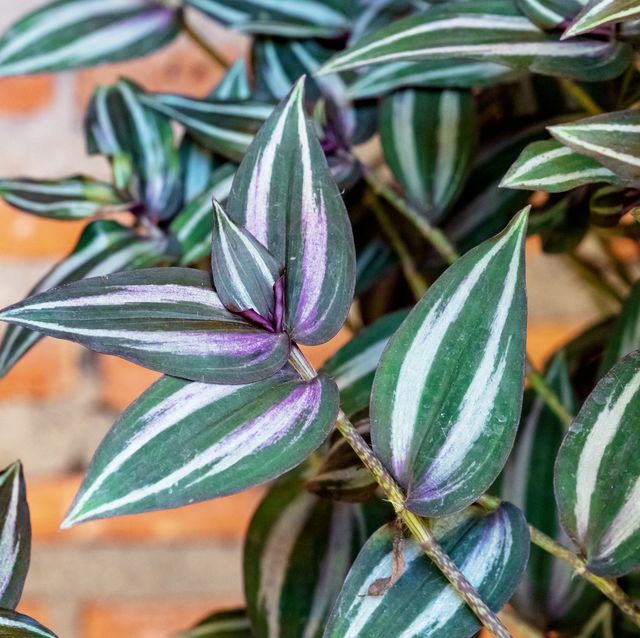
Country Living editors select each product featured. If you buy from a link, we may earn a commission. Why Trust Us?
With its long dangling stems, this plant tends to “wander” all over the place. Today, the plant often is called by its botanical name, Tradescantia, with “zebrina” referring to its silver striping.
It’s sometimes also called silver inch plant, but it can be confused with another plant, commonly called inch plant, Tradescantia fluminensis , which has solid green foliage.
Other varieties of wandering dude have become widely available in recent years, including the very popular nanouk type, which has foliage with pretty pinkish stripes and magenta undersides.
Native to Mexico, Belize, Guatemala and Honduras, the wandering dude usually is grown as a houseplant, but in USDA Hardiness zones 9 to 11 , it can be grown as a low-growing ground cover, too. ( Find your zone here .)
Read more: 15 Common Houseplants to Grow and Brighten Up Your Home
Ahead, learn everything you need to know about how to care for a wandering dude plant:
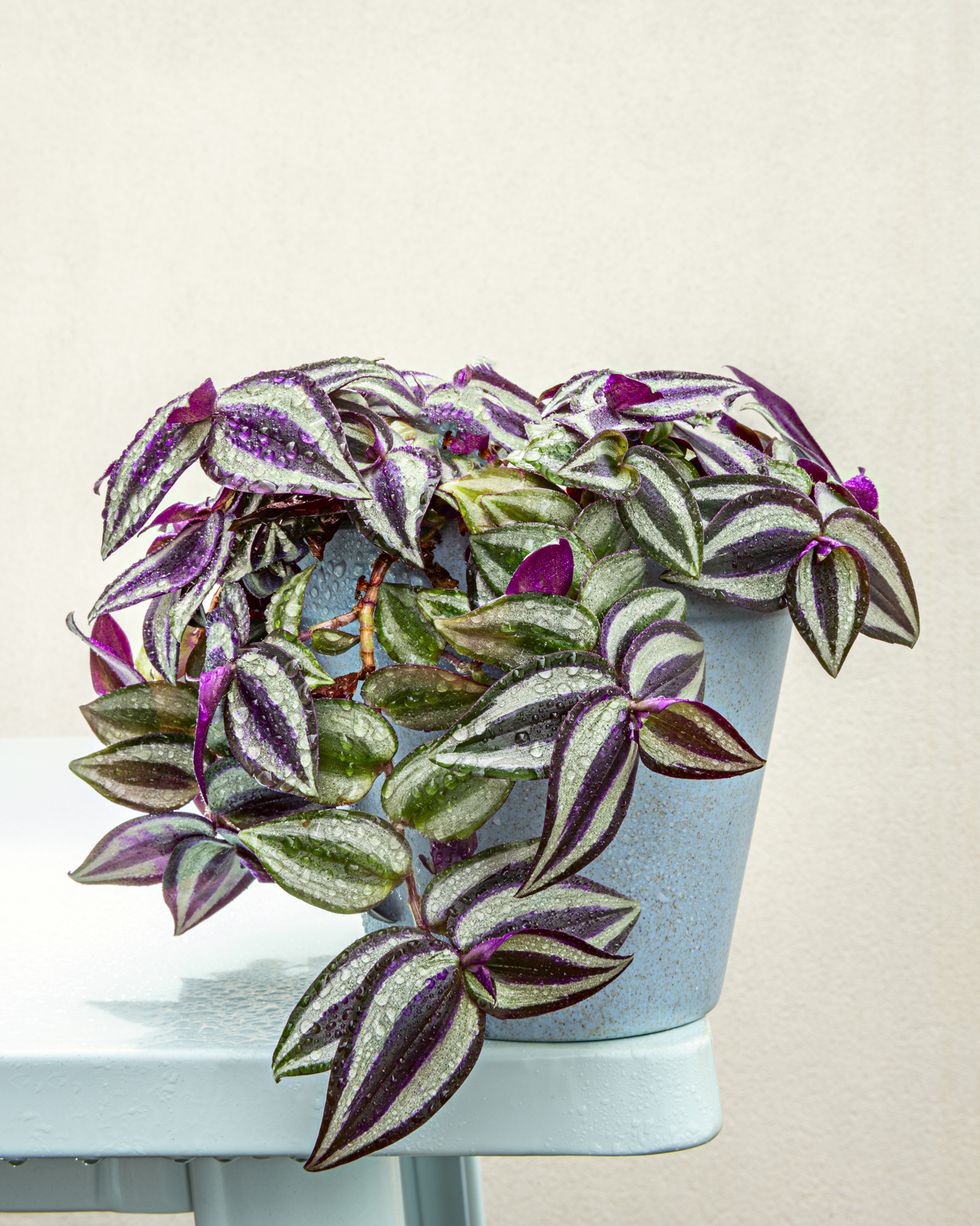
Wandering Dude Basic Info:
- Common Name: Wandering dude
- Botanical Name: Tradescantia zebrina
- Plant Family: Commelinaceae
- Type of Plant: Perennial, grown as houseplant
- Native Origin: Mexico, Belize, Guatemala, Honduras
- Sun Exposure: Full sun to part shade
- Mature Size: 6 inches tall by 1 foot wide
- Toxic to pets: Yes
Why Trust Us
I'm a garden writer with more than 15 years of experience growing houseplants, edibles, and landscape plantings. I also regularly trial new plant cultivars for performance and reliability, and test garden products to evaluate practicality and durability.
How Do You Care For a Wandering Dude Plant?
Give wandering dude bright, indirect light. If it doesn’t get sufficient light, this plant tends to get gangly and unattractive. Its purple coloring also may fade in low light, which means you should move it to a more brightly-lit room or use a grow light.
If your wandering dude is starting to get scraggly, simply snip off a few inches from the end of each stem to help stimulate the plant to push new, bushy growth. You can use plant snips or your fingers. You may need to pinch back frequently because wandering dude is a fast grower.
How Do You Water a Wandering Dude Plant?
You should water only when the plant feels mostly dry. Poke your finger in the soil before watering; if soil clings to your finger, wait a few more days and recheck.
If you let it get too soggy, that’s a sure way for it to get mushy and die. Like most houseplants, it’s better to err on the side of too dry, rather than too wet.
If you like, you can feed this plant with any general-purpose houseplant fertilizer, but it’s not entirely necessary.
Miracle-Gro Miracle-Gro Water Soluble All Purpose Plant Food, 3 lb
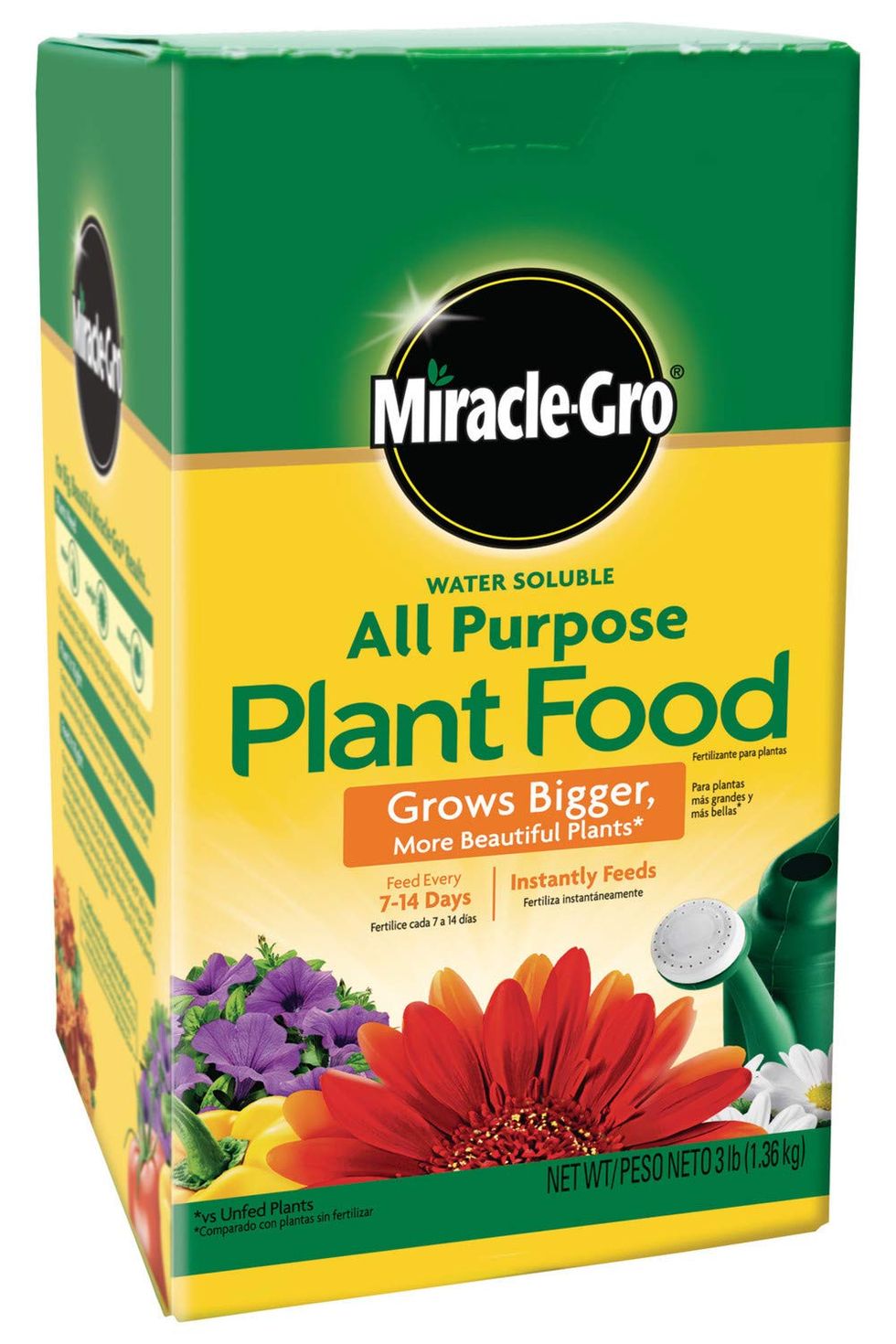
Can You Grow Wandering Dude Plant Outdoors?
Yes, it makes a great trailing plant spilling out of containers! Pair it with tall plants such as hibiscus, canna, elephant ears, or other tall, upright tropicals. If it starts to get leggy, just trim it back. Outdoors, it does best in full sun (northern climates) to part shade (southern climates). It may develop tiny pinkish flowers outdoors, though it rarely flowers indoors.
How Do You Propagate a Wandering Dude Plant?
Like pothos , this is a great plant to propagate to share with friends or to make new plants for yourself. Simply take a cutting, say, if it’s getting too long, then place it in a glass of water to root. Keep it in a bright spot in your home (not direct sunlight), and watch for roots to develop within about two weeks. Then plant in regular potting soil, and keep the soil lightly moist while it settles in.
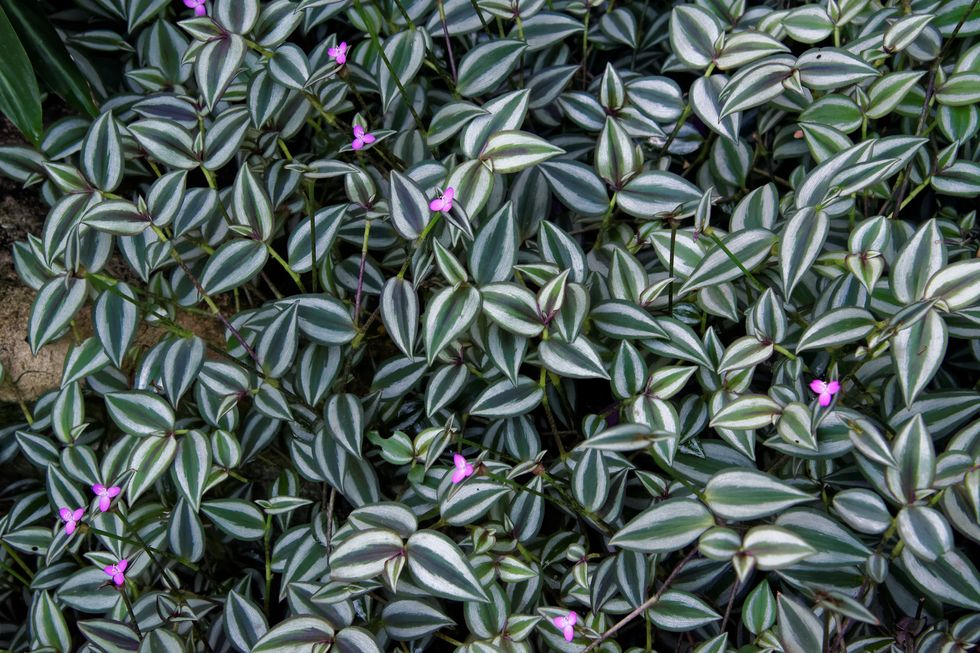
Is Wandering Dude Toxic to Pets?
According to the ASPCA , this plant is toxic to pets and may cause dermatitis, or irritation of the lips and mouth. But remember that any plant may cause vomiting or GI distress if eaten in large enough quantities, so keep this away from pets who are nibblers. Finally, call your vet ASAP if you suspect your pet has ingested it, even if you’re not sure. It’s always better to be safe than sorry!
In addition, the plant sap also may cause skin irritation in some people. Wear gloves when handling cuttings if you tend to have sensitive skin.
Read more: 28 Pet- Friendly Houseplants You Can Grow Without Worry
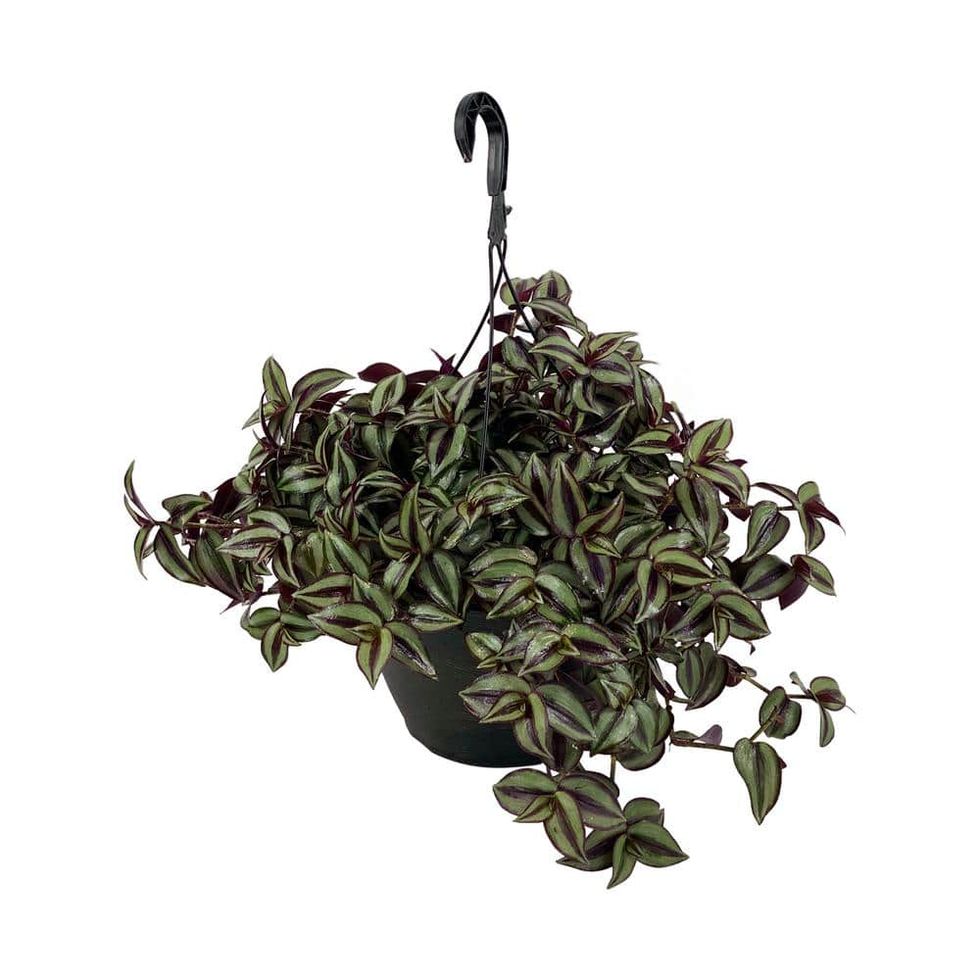
Vigoro Tradescantia in 11-inch Hanging Basket
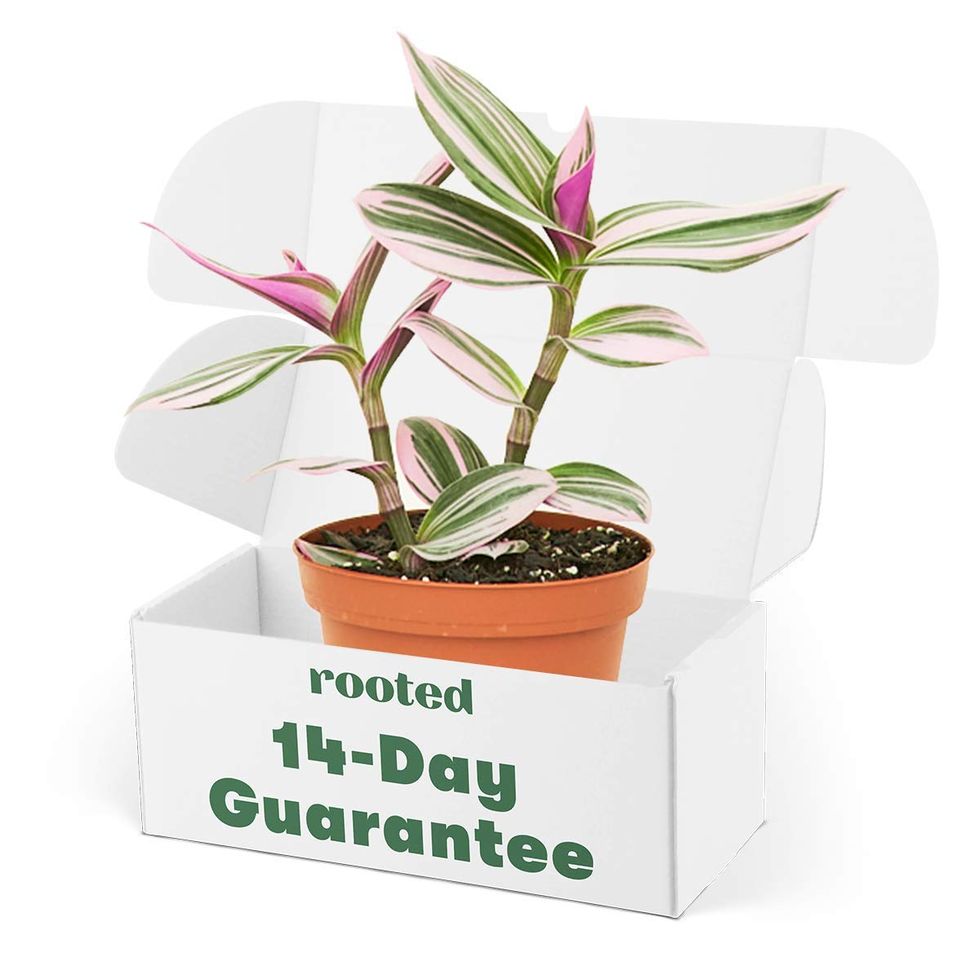
Rooted Tradescantia Nanouk, 4-inch pot
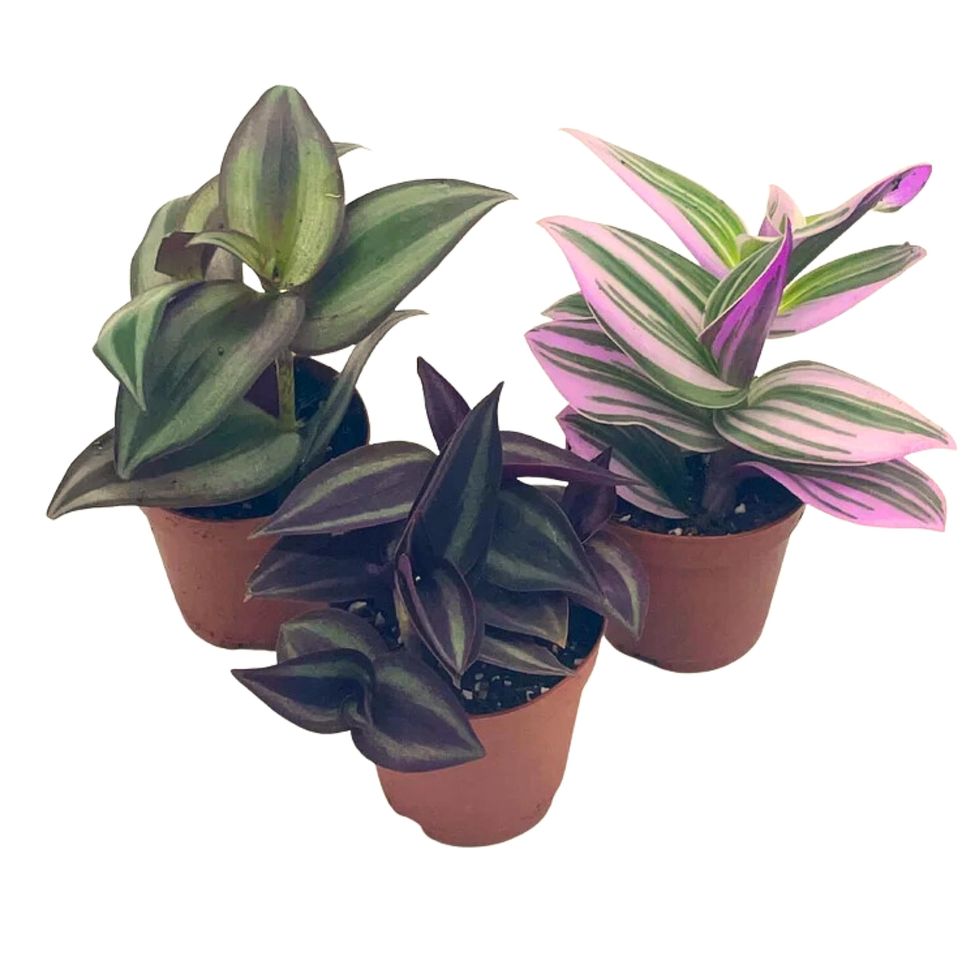
BubbleBlooms Wandering Dude Assortment
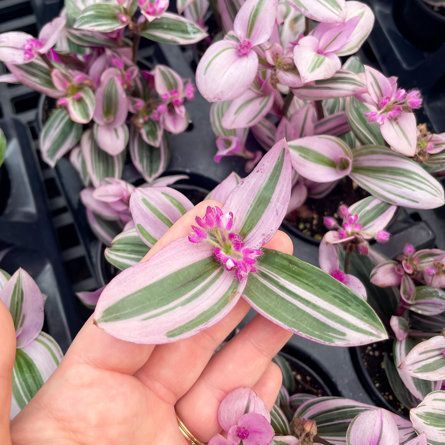
Wayfair Tradescantia Nanouk, 4-inch pot
Arricca Elin SanSone has written about health and lifestyle topics for Prevention, Country Living, Woman's Day, and more. She’s passionate about gardening, baking, reading, and spending time with the people and dogs she loves.

.css-1shyvki:before{background-repeat:no-repeat;-webkit-background-size:contain;background-size:contain;content:'';height:0.819rem;margin-bottom:0;margin-right:-0.9375rem;width:3.125rem;}.loaded .css-1shyvki:before{background-image:url('/_assets/design-tokens/countryliving/static/images/arrow.svg');}@media(max-width: 48rem){.css-1shyvki:before{display:none;}}@media(min-width: 40.625rem){.css-1shyvki:before{display:inline-block;}} Gardening Encyclopedia .css-unxkmx:before{background-repeat:no-repeat;-webkit-background-size:contain;background-size:contain;content:'';height:0.819rem;margin:0.7rem auto 0.9375rem;width:3.125rem;}.loaded .css-unxkmx:before{background-image:url('/_assets/design-tokens/countryliving/static/images/arrow.svg');}@media(max-width: 48rem){.css-unxkmx:before{display:block;}}@media(min-width: 40.625rem){.css-unxkmx:before{display:none;}}

17 Best Cottage Garden Ideas We Love

7 Tomato Plant Pests and How to Get Rid of Them

22 Best Hanging Plants for Every Space
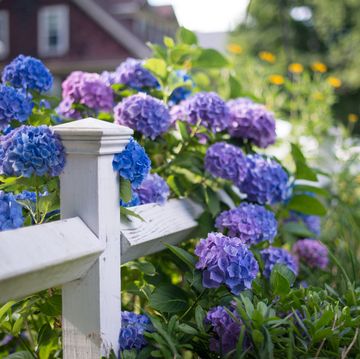
Grow Hydrangeas Like a Master Gardener!

21 Indoor Plants That Are Easy to Grow
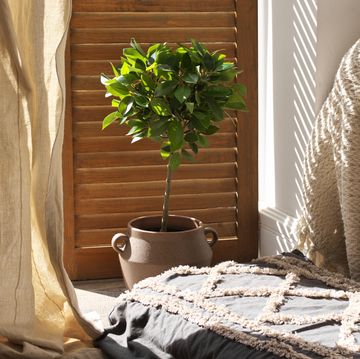
Buying a Ficus Tree? Here's What to Know
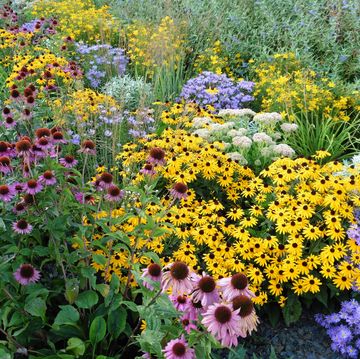
26 Full-Sun Perennials for Your Garden

Got Spider Mites? Here's How to Get Rid of Them
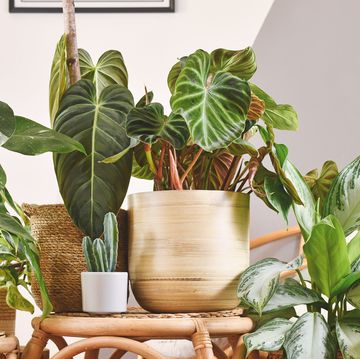
12 Big Leaf Houseplants You Need ASAP
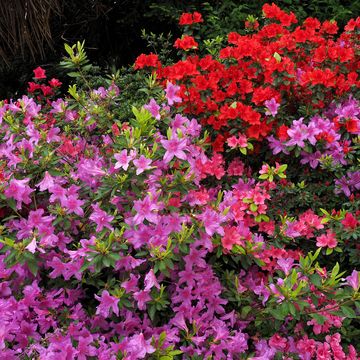
How to Grow Beautiful Azaleas

18 Spring Vegetables That Are Best Right Now
9 Essential Tips for Wandering Jew Plant Care
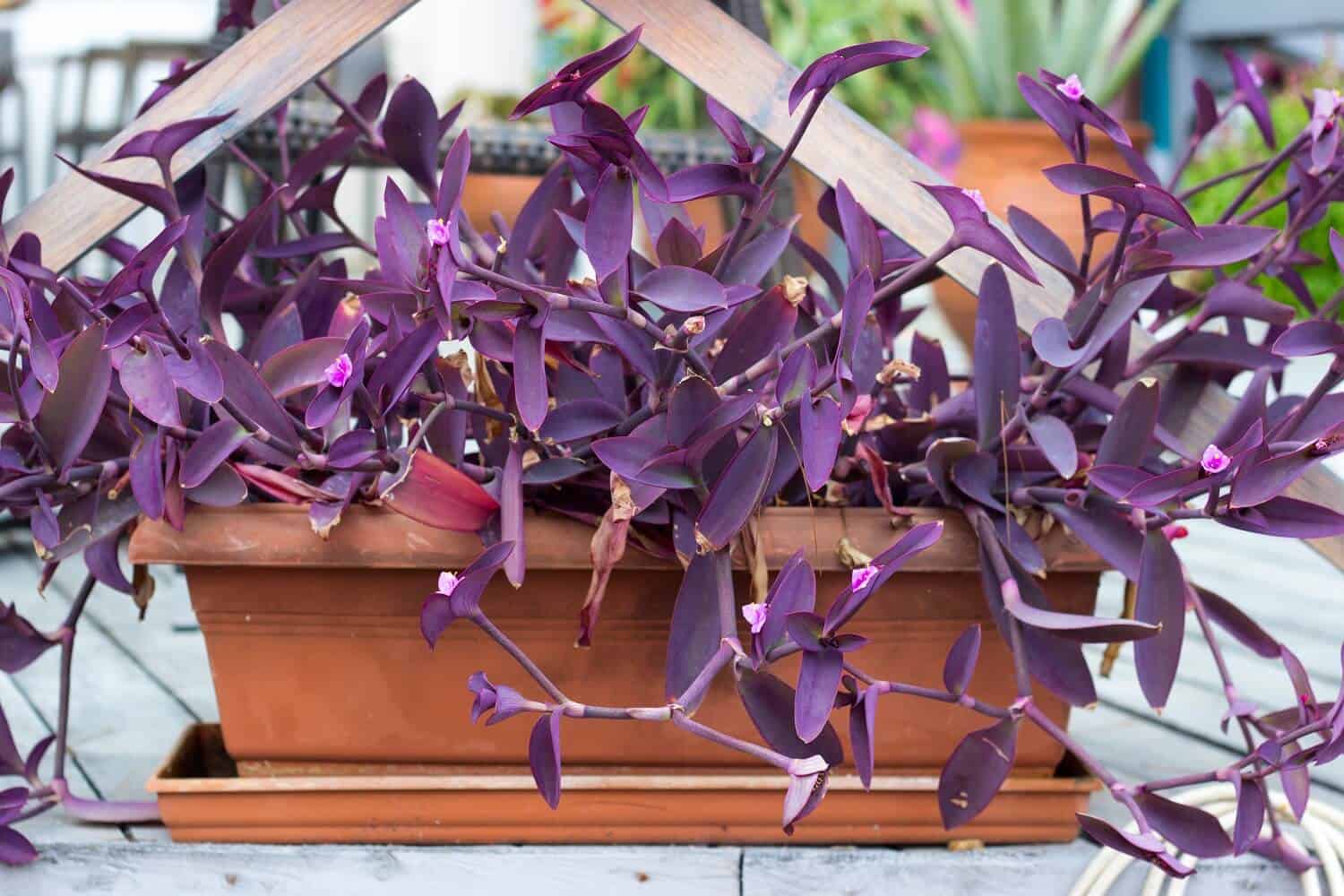
Sharing is caring!
Have you been looking for information on Wandering Jew Plant Care? Well, look no further. Call it luck or, pure coincidence that you have landed on this piece of information.
The article contains most if not all the things you need to know about taking care of this beautiful indoor vining plant . Be it propagation, watering, temperature and light requirements, pruning, repotting, or fertilizer application, it’s all in here.
Furthermore, I have touched on pests and diseases affecting this colorful, fast-growing indoor trailing succulent plant as well as common physiological problems associated with it.
Want to learn more about this plant?
Let’s begin.
Wandering Jew Plant Care: How to Grow and Care for Inch Plant ( Tradescantia zebrine )
1. propagate from stem cuttings.
Propagating a wandering Jew plant from stem cuttings is easy and quick. What’s more, is that you don’t need a special rooting medium or hormone for successful rooting. You just need to root the cuttings in water or soil.
Let’s start with rooting a Jew plant in water. First, cut at least 6-inch long cuttings from the healthy stems of the plant.
Then remove the bottom leaves from each stem and place the stems in a glass of water. Ensure that the bottom leaf node is submerged. In just a few days, tiny roots start to show, and in about 4 to 6 weeks, new growth appears.
At this stage, your cuttings are ready for transplanting. Use an all-purpose potting mix to grow your plants.
When it comes to rooting the Jew plant in soil, start by snipping several cuttings from the ends of healthy branches of your plant. Then using a clean and sharp blade, make a 45-degree cut just under the leaf node.
The next step is to fill an approximately six-inch hanging basket or pot with an all-purpose potting soil to about an inch below the top of the pot.
Afterward, make four holes approximately 2 inches deep around the edges of the pot and one more hole at the center.
Plant one cutting in each hole and add more soil as you press gently to hold the cuttings in position. Keep the soil evenly moist by regular watering and expect a new, full-leafy plant in a few weeks.
Pro Tip: Planting more than one stem in a single container makes the container appear fuller.
The plant thrives best in good-drained soil and with just an all-purpose potting mix, you are good to go!
It’s also fine to use regular potting soil provided that the soil doesn’t get soggy. You can improve soil drainage and aeration by adding some pumice or perlite.
In another case, your soil might seem to dry too quickly as opposed to holding moisture. Under these circumstances, mix in some vermiculite, peat moss or, coco coir to help the soil retain moisture.
3. Sunlight
This groundcover plant is hardy to zones 9 through 12 and it’s a nice houseplant.
Keep your indoor Jew plant, in a spot with bright but indirect light for example in an east or west-facing window. Your plant, therefore, will get plenty of natural light in the morning or evening, and bright indirect sun for the rest of the day.
This is important because when grown in too little light, the leaves’ color appears faded while under too much light, the leaves are prone to scorching.
On the other hand, an outdoor-grown plant requires a bright but partially shaded environment. This way the plant gets some shade during the hottest hours of the day.
This also applies to when you move your indoor plant outside for the summer.
4. Watering
Even though this plant is drought tolerant , it requires regular watering or, it won’t survive long spells of dryness or wetness. So, practice good watering habits and keep the soil moist but not soggy.
Using your finger, check whether the topsoil feels dry, or use a soil moisture gauge to check if the plant needs watering. If it does, water the plant thoroughly until water comes out through the drainage holes in the pot.
Then empty the sauce to avoid the development of diseases such as root rot.
5. Fertilizer Application
Although this plant doesn’t need to be fertilized, feeding it once in a while will benefit the plant by replacing the nutrients lost every time you water it.
Apart from this, fertilizing also encourages the plant to bloom. Imagine enjoying the beautiful view of purple, pink or white flowers even in winter!
Hence, feed the plant each month in spring through summer with a liquid fertilizer formulated for houseplants mixed at half strength.
Furthermore, this plant can be sensitive to chemical fertilizers so, use organic plant foods such as compost tea or a general-purpose fertilizer. Adding slow-release organic granules in the soil works well too.
You can also use liquid kelp and fish emulsion but only on outdoor-grown Jew plants as the two formulations can get somewhat stinky when used indoors.
6. Humidity & Temperature
Humidity is another key requirement for a healthy and good performing Jew plant. This plant loves lots of humidity.
Although maintaining good humidity levels indoors especially during winter can be challenging, it is possible to increase the levels using a humidifier .
Alternatively, fill a pebble tray with water and place the pot on the tray (don’t allow the pot to sit directly on water). This way, humidity around the plant increases as the water evaporates from the tray.
When it comes to temperature, the plant prefers warm temperatures of about 50-80 degrees. And when the temperature goes above 90 degrees, you need to water the plant more frequently and provide some shade to bring down the temperatures.
During winter, you need to be careful especially when the temperature is in a 45 degrees range. The plant will tolerate the condition for a short period but will die if the condition prolongs.
For this reason, device a way to help keep your plant’s ambient temperature above 50 degrees, for instance, a cold frame or a piece of woven cloth.
Pro Tip: When humidity levels are too low, the plants’ leaves start to turn brown and eventually die.
7. Repotting
This plant is fast-growing and repotting is quite necessary whenever the plant becomes crowded in its pot/container.
To repot, first select a container that’s approximately 50% wider than the existing one. Then, use some fresh potting mix around the sides of that container, remove the plant from the current container/pot and place it into the new one.
Next, remove or add the potting mix as needed to keep the plant into place and fill to about 2 inches below the containers’ rim.
Finally, press the potting mix lightly to hold the plant into place.
With time, there is a likelihood of your plant becoming leggy. When this happens, prune back the plant and pinch off the stem tips as well.
This way, the plant produces two new growths from right below the pinched areas and the plant becomes bushier and healthier.
Also, prune off the long tendrils if you like to have your plant thick and compact.
9. Look out for Pests and Diseases
Spider mites.
These are some of the most common pests in Jew plants and they cause damage by sucking sap from the plant. They like dry and warm areas.
Get rid of spider mites by misting, keeping the humidity high, or wash the plant with water to knock off the pests.
Plus, remove the infested plant parts/areas or use a systemic insecticide when the infestation is severe.
Aphids are another sap-sucking pests in wandering Jew plants. They are tiny, pear-shaped bugs that congregate along the stems in large masses.
Under severe infestation, the plant gets weak and eventually dies. Get rid of aphids by wiping the pests off the plant using a moist cloth (this works for low infestation), or spray the plant with an insecticidal soap or neem oil when the infestation is high.
This is the most common disease in wandering plants. It is caused by either over-watering or, your soil holding too much water. So, if the soil drains well but there is an occurrence of root rot, reduce the watering frequency.
And if the problem is poor drainage, devise ways of improving soil drainage such as adding some perlite or compost to the soil.
Common Problems in Wandering Jew Plant
Leggy plants.
Your plant might become leggy as a result of lack of light, especially during winter. You should hence keep your plant at a spot where it gets the right amount of sun.
However, if you don’t have such a spot in your house, try using grow lights to compliment the available natural light.
Brown leaves on inch plant
The leaves on your inch plant turn brown due to lack of enough moisture or humidity. Also, as the leaves age, they start dying out in the middle and this makes them appear brown. When this happens, prune the vines to refresh the plant.
Faded color on leaves
Faded or dull color on leaves is an indication of too much light, not enough light, or a bug infestation. Therefore, provide the appropriate growing conditions for your plant.
Now that you have read this article, I bet the question of wandering Jew plant care is a thing of the past.
But most importantly, you have seen the things that must be done correctly for a healthy plant.
For example; choosing an appropriate soil/potting mix, selecting the best propagation method, proper watering and, applying the correct fertilizer and at the right time.
Apart from this, pruning and, repotting crowded plants as well as protecting the plants from pests and diseases is a great way of ensuring you have a good–performing wandering plant.
Oh! And don’t forget to keep the environment humid enough.
What has been your experience growing wandering plants?
Share with us in the comments.
University of Wisconsin-Madison
Home Guides
1 thought on “9 Essential Tips for Wandering Jew Plant Care”
I ONCE READ THAT YOU SHOULD LET YOUR WATER SIT FOR 24 HOURS BEFORE USING IT TO WATER YOUR PLANT. ANY TRUTH TO THIS? ALSO, HOW DO YOU RECOMMEND ROTATING THE PLANT FOR EVEN SUNLIGHT. THANK-YOU, GG
Comments are closed.

Tradescantia Pink Panther Care Guide: Keep Your Plant Colorful and Beautiful
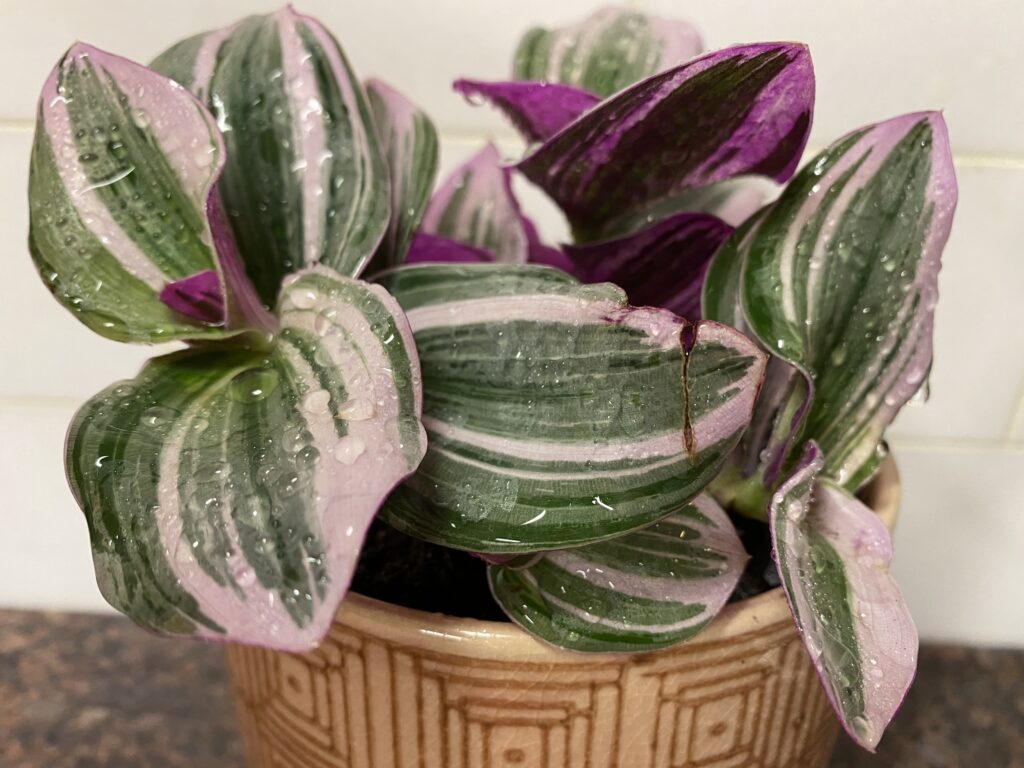
The Pink Panther Tradescantia is one of the most popular houseplants today thanks to it’s beautiful pink, purple, green and cream coloring. These rich colors highlight the wandering leaves as the plant grows outward, forming compact vines that make it visually and structurally interesting. This beautiful houseplant is also incredibly easy to grow with the right conditions.
Whether you grow your Tradescantia in a compact container or allowed to let loose and vine, this easy houseplant is a fast grower and easy to propagate, making it a trending choice for new plant parents.
- Temperature
- Toxic to pets?
- What to look for
The Tradescantia Pink Panther is considered a semi-succulent houseplant. Like succulents, Tradescantia Pink Panther prefers drier soil conditions between waterings. The scientific name for Tradescantia Pink Panther is Tradescantia Nanouk . Other common nicknames include Wandering Jew, Spiderwort, or the Inch Plant.
Whatever you call it, this plant thrives in most indoor environments like the home or office . With the appropriate blend of lighting, watering, temperature and humidity, your Pink Panther will grow quickly into a beautiful and lush plant. The ease of care, quick growth, and ease of propagation make the Tradescantia Pink Panther is really an excellent choice as a houseplant – especially for those new to the houseplant hobby. Pay attention to the specific light, water, temperature and humidity conditions to help your Tradescantia develop into a healthy plant for years to come!
The best lighting for Tradescantia Pink Panther
Lighting is one of the most essential keys to raising a flourishing plant. The optimal sunlight for the Tradescantia Pink Panther plant is bright, indirect light. Direct sunlight can scorch its leaves and cause harm, so it is best to place it in a location where it can receive filtered light, such as near a north or east-facing window. This will provide the plant with the necessary light it needs to grow healthy and strong.
It is recommended that the Tradescantia Pink Panther plant receives approximately 6-8 hours of light per day. This can be accomplished by placing it in a well-lit room or by using artificial lighting, such as a grow light. This will ensure that the plant receives the necessary amount of light to thrive.
When it comes to windows, north or east-facing windows are the best for the Tradescantia Pink Panther plant. These windows provide bright, indirect light that is ideal for this plant. However, if you have a south or west-facing window, you can still grow this plant as long as you provide it with some shade or use a sheer curtain to filter the light. This will help to prevent damage to the plant’s leaves.
If the Tradescantia Pink Panther plant receives too much light, its leaves may start to turn yellow or brown and become crispy. Conversely, if it doesn’t receive enough light, its leaves may become pale and start to droop. To avoid these issues, it is important to monitor your plant’s light levels and adjust its placement as needed. This will ensure that your plant remains healthy and vibrant.
The Tradescantia Pink Panther plant requires bright, indirect light for approximately 6-8 hours per day. It should be placed near a north or east-facing window or provided with artificial lighting. Monitoring your plant’s light levels and adjusting its placement accordingly will help to prevent damage and ensure that your plant thrives.
If your Pink Panther is kept outdoors, It’s also best to stay clear of direct sunlight – especially during the course of the extreme summer season – to stay away from burning the plant. And in the case that your plant does not get sufficient sunshine, it may lead to slower growth, droopiness, or lost leaves.
Plants will always try to grow towards your area’s light source. You can gradually rotate your plant pot about a quarter turn every week. Rotating every week will let keep your plant looking full and strong. This small step also prevents your plant from leaning towards the light source. Getting the best lighting balance will go a long way to making your plant happy. The majority of plant parents say they are worried their plants are not receiving the best amount of sunlight.
What’s the absolute best amount of water for my Tradescantia Pink Panther?
Providing just the right amount of water will go a long way to keeping your Tradescantia houseplant happy. And as semi-succulents, Tradescantia Pink Panther plants like to be kept on the dry side. This means to only water sparingly when your plant seems like it requires water, when the top 1”-2” of soil appear dry. Water well when the plant appears dry, but do not let the plant sit in moist soil for too long. This may lead to root rot and eventual decline. A pot with a sufficient drainage hole and porous material like terracotta will ensure that moisture isn’t sitting on your plant’s root system between waterings.
Whenever you’re unsure about watering, it’s optimal to choose to wait. Your Tradescantia Pink Panther would often choose to be underwatered vs. overwatered. When you do water your plant, be sure to provide it sufficient water to soak through the soil, simulating a powerful rainstorm. Filtered water is always best if it’s conveniently accessible to you. This will most likely keep your plant free from chemicals commonly found in drinking water.
How to prevent overwatering Tradescantia Pink Panther plants
Given their semi-succulent nature, you should stay away from overwatering your Tradescantia Pink Panther. In fact, 90% of houseplants that do not last are due to overwatering.
The ideal watering schedule for the Tradescantia Pink Panther plant is to water it once a week during the growing season (spring and summer) and reduce watering to once every two weeks during the dormant season (fall and winter). However, it’s important to check the soil moisture level regularly and adjust the watering schedule accordingly.
The Tradescantia Pink Panther plant necessitates moderate watering, and it’s crucial to avoid overwatering or underwatering. By following the ideal watering schedule and checking the soil moisture level regularly, you can ensure that your plant stays healthy and beautiful.
Overwatering can lure insects or fungal diseases that can kill your plant. What’s the easiest way to prevent overwatering? Right before you water your plant, check that the top inch of soil is completely dry. If you still feel moisture in the soil, your plant doesn’t really need to be watered.
Growing your indoor plant in a plant pot containing drainage holes and a tray guarantees unwanted water can correctly drain out – instead of drowning your plant’s roots. By allowing excess water to go through the pot, your Tradescantia Pink Panther roots can stay drier than if the water was stuck in the planter.
Without adequate water drainage, your plant would likely experience insects and fungus as the root system sits in standing water. This is important because once pets or rot is attracted to your plant’s root system, it’s very difficult to bring the plant back from this decline.
How to prevent Tradescantia Pink Panther under watering?
On the flip side, under-watering your plant can also cause issues and decline. When the top inch of your plant’s soil is completely dry, it’s time to water. Tradescantia Pink Panther plants actually prefer some dryness between waterings but may decline if you wait too long.
You may see your plant drying out as it makes an effort to retain moisture if you forget to water it on a regular basis. Seasonality also impacts the watering schedule for Tradescantia Pink Panther. During the winter, when the plant is dormant and not in its growth cycle, it’s completely normal to water less.
The ideal temperature for Tradescantia Pink Panther
When looking for the ideal temperatures for your plants, it’s always helpful to understand where they grow in the wild. Originally found in Mexico and parts of South America, Tradescantia Pink Panther thrives in warmer temperatures and will do well with average indoor temperatures between 65º-80º. This happy range of temperature makes them great indoor plants for the house. Additionally, these plants can be moved outdoors during warm summer months to encourage growth. Just remember to rehouse the plant back in doors when temperatures drop back below 65º.
While comfortable inside your home, your Tradescantia may react adversely to cold drafts, extreme heat, or other fluctuations in the place. Your plant will most likely stay healthy and grow if placed in an environment that’s unchanging at all times of the year.
This means steering clear of places such as drafty windows or near doors used throughout cold months. Keeping your Pink Panther plant within a stable interior temperature will keep it healthy and really help it thrive.
The ideal temperature range for the Tradescantia Pink Panther plant is between 60°F to 80°F (15°C to 27°C). This plant can endure slightly cooler temperatures, but it is imperative to evade exposing it to temperatures below 50°F (10°C) for extended periods of time.
If the Tradescantia Pink Panther plant is kept in conditions that are too hot, it may undergo leaf burn or wilting. This can transpire if the plant is exposed to temperatures above 85°F (29°C) for extended periods of time. Furthermore, high temperatures can cause the soil to desiccate rapidly, which can lead to root damage and stunted growth.
On the flip side, if the Tradescantia Pink Panther plant is kept in conditions that are too cold, it may undergo leaf drop or sluggish growth. This can transpire if the plant is exposed to temperatures below 50°F (10°C) for extended periods of time. Additionally, cold temperatures can cause the soil to become waterlogged, which can lead to root rot and other fungal diseases.
To ensure the well-being and longevity of your Tradescantia Pink Panther plant, it is crucial to keep it in a temperature range that is comfortable for the plant. This will aid in preventing any damage or stress that can occur from exposure to extreme temperatures.
Best humidity for Tradescantia
Your Spiderwort or Inch Plant will do well in spaces with average humidity, but it’ll thrive in places with higher humidity like a bathroom or kitchen which usually see more moisture throughout the day. This flexibility makes Tradescantia an incredibly popular choice to beautify their home by using an easy-to-care-for plant. If the moisture in your home or office is pleasant to you, your new plant will very likely do just fine.
The ideal humidity level for this plant is between 50% to 60%. If the humidity level drops below 40%, the plant may start to show signs of stress, such as curling or wilting leaves. This can make the plant more vulnerable to pests and diseases, which is not ideal.
However, if the humidity level is too high, the plant may develop fungal diseases or root rot. This can cause the leaves to turn yellow or brown, and the plant may start to drop its leaves. This is not a good sign, and it means that the plant is not happy.
To maintain the ideal humidity level for the Tradescantia Pink Panther plant, you can use a humidifier or place a tray of water near the plant. This will help to increase the humidity level and keep the plant happy. You can also mist the leaves regularly with water to increase the humidity level. This will help to keep the plant healthy and happy.
The Tradescantia Pink Panther plant requires a humid environment to thrive. The ideal humidity level should be between 50% to 60%. If the humidity level is too low or too high, the plant may start to show signs of stress and become more susceptible to pests and diseases. Therefore, it is important to maintain the ideal humidity level to keep the plant healthy and happy.
How to manage humidity
Given that these plants prefer regular humidity, it shouldn’t be difficult to make your office or home feel welcoming to your Spiderwort plant. This might be harder if you are in a particularly dry climate, or have chilly winters that can reduce the humidity lower than normal. If this is the case, an inexpensive spray bottle could be used to mist your plants regularly to keep the humidity levels up. Also, you might want to consider getting a humidifier to add cool mist to the air for your and your Tradescantia Pink Panther plant’s benefit.
Maintaining steady humidity will keep your plant strong and encourage new growth of your Tradescantia Pink Panther plant.
Soil Requirements
Keep your Pink Panther or Spiderwort happy with potting soil that provides rich nutrients and proper drainage to keep the plant balanced and healthy. The plant thrives in soil that is well-draining and rich in organic matter. A potting mix that contains a combination of peat moss, perlite, and vermiculite is ideal for this plant.
If you can’t make your own soil mix, Tradescantia plants will do well in most soils readily available at your nursery that contain organic matter like peat moss or coco-coir. The only soils to avoid are those that actively lock in moisture. Gently repot so the root system doesn’t get damaged and water has an easy route to find the drainage holes at the bottom of your container. When planting the Tradescantia Pink Panther, it is crucial to choose a pot that has drainage holes at the bottom. This will allow excess water to drain out of the soil and prevent waterlogging, which can be detrimental to the plant’s growth.
To ensure that the plant receives the necessary nutrients for healthy growth and vibrant foliage, it is recommended to fertilize it with a balanced fertilizer every two weeks during the growing season.
The Tradescantia Pink Panther plant requires soil that is well-draining, nutrient-rich, and slightly acidic with a pH range of 5.5 to 6.5. By providing the plant with the right soil conditions, it can thrive and grow to its full potential.
Should you use fertilizer or nutrients
Fertilizing your Pink Panther Tradescantia may provide extra nutrients to help it grow stronger. The best time to add fertilizer is before the spring and summer growing season. This will help your plant get ready to grow. It may even be a great time to transplant your plant to a larger sized planter. Likewise, it could also be a good time to add in new, nutrient-rich soil to change out old or compressed dirt from the previous year. Additionally, you don’t really need to worry about fertilizing your plant during the dormant fall and winter months.
A balanced, water-soluble fertilizer, such as a 10-10-10 or 20-20-20 formula, diluted to half strength, can be used. It’s recommended to apply the fertilizer every two to three weeks during the growing season, from spring to fall. However, it’s important to avoid fertilizing during the winter months when the plant is dormant.
In terms of nutrients, the Tradescantia Pink Panther plant prefers well-draining soil that is rich in organic matter. It also needs adequate moisture to thrive. To ensure that the plant gets the right nutrients, you can add compost or organic matter to the soil before planting. Additionally, top-dressing the soil with compost or worm castings every few months can provide a slow-release source of nutrients.
Watering is also an essential part of Tradescantia Pink Panther plant care. The plant prefers moist soil but can’t tolerate waterlogged conditions. It’s recommended to water the plant when the top inch of soil feels dry to the touch. Water deeply, but allow the soil to drain completely before watering again. It’s important to avoid letting the plant sit in standing water, as this can lead to root rot.
Providing the Tradescantia Pink Panther plant with occasional fertilization, rich and well-draining soil with organic matter, and adequate moisture can help it grow healthy and vibrant.
Common Pests and Diseases
The Tradescantia Pink Panther plant is a relatively low-maintenance plant, but it is still susceptible to some pests and diseases. Here are some of the most common issues that you may encounter when caring for this plant:
1. Spider Mites: These tiny pests can cause damage to the leaves of your Tradescantia Pink Panther plant. You may notice small webs on the leaves, as well as yellowing or browning of the foliage. To treat spider mites, you can use a neem oil spray or insecticidal soap. Be sure to follow the instructions on the product label carefully.
2. Mealybugs : Mealybugs are another common pest that can infest your Tradescantia Pink Panther plant. They look like small, white, cottony masses on the leaves and stems. To get rid of mealybugs, you can use a cotton swab dipped in rubbing alcohol to wipe them off. You can also use insecticidal soap or neem oil spray.
3. Root Rot: Root rot is a fungal disease that can affect your Tradescantia Pink Panther plant if it is overwatered or if the soil does not drain well. Symptoms of root rot include yellowing leaves, wilting, and a foul odor coming from the soil. To treat root rot, you will need to remove the affected plant from the soil, trim away any damaged roots, and repot the plant in fresh, well-draining soil.
4. Leaf Spot: Leaf spot is a fungal disease that can cause brown or black spots on the leaves of your Tradescantia Pink Panther plant. To treat leaf spot, you can remove any affected leaves and dispose of them. You can also use a fungicide spray to prevent the disease from spreading.
In general, the best way to prevent pests and diseases from affecting your Tradescantia Pink Panther plant is to provide it with proper care. This includes watering it only when the soil is dry, providing it with bright, indirect light, and ensuring that the soil drains well. With proper care, your Tradescantia Pink Panther plant should thrive and remain healthy for years to come.
Propagating your plant
The process of propagating a Tradescantia Pink Panther plant is a simple one that can be accomplished through stem cuttings. The optimal time to propagate the plant is during the growing season, which typically falls in the spring or summer months.
To begin the propagation process, it is important to select a healthy stem that measures at least 4 inches in length. Using a sharp and clean pair of scissors or pruning shears, make a cut just below a node, which is the point where the leaves attach to the stem.
After removing the lower leaves from the stem, it is recommended to leave only a few leaves at the top. This will help the plant conserve energy and focus on growing new roots.
To stimulate root growth, dip the cut end of the stem into rooting hormone powder. Then, plant the stem in a pot filled with well-draining soil. It is important to water the soil thoroughly and place the pot in a bright, indirect light.
While keeping the soil moist but not waterlogged, it is crucial to avoid exposing the plant to direct sunlight or extreme temperatures. Within a few weeks, the stem should start developing roots and new growth.
Once the new plant has established roots and is growing well, it can be transplanted into a larger pot or planted in the garden. With proper care, the new plant will grow into a beautiful and healthy Tradescantia Pink Panther plant.
Is Tradescantia Pink Panther toxic to cats and dogs?
Yes! Unfortunately, Tradescantia Pink Panther plants are not safe for cats, dogs, or other pets. This plant is toxic to cats, dogs, and other pets due to the presence of calcium oxalate crystals. These crystals can cause a range of unpleasant symptoms, including irritation and swelling in the mouth, throat, and digestive tract. If your pet ingests this plant, they may experience drooling, vomiting, difficulty swallowing, and even respiratory distress in severe cases.
To keep your pets safe, it’s important to take steps to prevent them from coming into contact with the Tradescantia Pink Panther. This might mean keeping the plant out of their reach or even removing it from your home altogether. If you do notice any signs of toxicity in your pet, it’s crucial to seek veterinary care right away. And while you’re at it, it’s a good idea to educate yourself on the toxicity of other plants in your home to ensure that your furry friends stay safe and healthy.
The toxic nature of these plants should make you reconsider if this particular plant is ideal for your home if you have any pets around that have a tendency of eating any houseplants you could get as this will make them sick.
What to shop for in choosing the perfect Pink Panther at the nursery or store
Think you can take care of a fresh Tradescantia Pink Panther plant after reading this overview on PottedPlants.org ? Whenever shopping, look for small Tradescantia plants at your local nursery. Usually, you may be able to get plants that are about 4″-6″ to enhance your collection.
There are a couple things to look for to be sure you pick a plant that’s healthy. Watch out for leaf damage, insects in the soil, or other signs of plant damage. This will ensure your plant is in good shape and will develop at home. Give your plant time to adjust to its new home – don’t forget, this is a major move for your new Tradescantia Pink Panther. If you have established plants at home, it’s also a good idea to isolate your new Tradescantia Pink Panther for a few weeks to ensure there are no pests, fungus or other issues not apparent at the nursery to keep your existing plants safe and healthy. Your new plant should adjust just fine if you offer it the appropriate care as detailed by this guide.
Similar Plants to Tradescantia Pink Panther
When it comes to houseplants, there are a plethora of options that are comparable to the Tradescantia Pink Panther in terms of both appearance and care requirements. Here are just a few examples to get you started:
1. The Tradescantia Zebrina, also known as the Wandering Jew plant, boasts stunning purple and silver striped leaves that are sure to catch the eye. This particular plant thrives in bright, indirect light and soil that is kept consistently moist.
2. Another great option is the Tradescantia Nanouk, which features leaves that are similar in appearance to the Pink Panther, with a lovely pink and green color scheme. Like its predecessor, the Nanouk prefers bright, indirect light and soil that is kept moist.
3. If you’re looking for something a little different, the Pilea Peperomioides, or Chinese Money Plant , might be just what you need. This plant has unique round leaves that resemble coins and grow on long stems. It prefers bright, indirect light and soil that is well-draining.
4. For those who prefer a more classic look, the Peperomia Obtusifolia is a great choice. This plant has thick, glossy leaves that come in a variety of shades of green and variegated patterns. It also prefers bright, indirect light and well-draining soil.
5. Finally, the Calathea Orbifolia is a stunning houseplant with large, round leaves that feature silver stripes. Not only is it visually appealing, but it also has the added benefit of purifying the air. Like the other plants on this list, it prefers bright, indirect light and soil that is kept moist.
Wrapping up
The Tradescantia Pink Panther is a plant that is low-maintenance and easy to care for, making it a great addition to any space. Its unique pink and green foliage adds a pop of color that is sure to catch the eye of any plant enthusiast. This plant thrives in bright, indirect light and requires moderate watering, making it a great choice for those who want a plant that is easy to care for. Whether you’re a seasoned plant parent or just starting out, the Tradescantia Pink Panther is a great plant to choose for its beauty and ease of care. So, if you’re looking to add some variety to your indoor plant collection, this is definitely a plant to consider.
Frequently Asked Questions
How often should i water my tradescantia pink panther plant.
Water your Tradescantia Pink Panther plant once a week or when the top inch of soil feels dry to the touch.
Does the Tradescantia Pink Panther plant need direct sunlight?
The Tradescantia Pink Panther plant prefers bright, indirect sunlight. Direct sunlight can scorch the leaves.
How often should I fertilize my Tradescantia Pink Panther plant?
Fertilize your Tradescantia Pink Panther plant once a month during the growing season (spring and summer) with a balanced fertilizer.
Can I propagate my Tradescantia Pink Panther plant?
Yes, you can propagate your Tradescantia Pink Panther plant by stem cuttings. Simply cut a stem with a few leaves and place it in water or soil.
How often should I prune my Tradescantia Pink Panther plant?
Prune your Tradescantia Pink Panther plant as needed to control its size and shape. Pinching back the tips of the stems can encourage bushier growth.
What should I do if my Tradescantia Pink Panther plant’s leaves are turning brown?
Brown leaves can be a sign of overwatering or underwatering. Check the soil moisture level and adjust your watering schedule accordingly.
Can I keep my Tradescantia Pink Panther plant outdoors?
The Tradescantia can be kept outdoors in a shaded or partially shaded area during the summer months. Bring it indoors before the first frost in the fall.

Tradescantia Zebrina (Wandering Jew Plant / Inch Plant)
By Tom Knight
About the Wandering Jew Plant
The Wandering Jew , Wandering Dude, Inch Plant , Spiderwort or Tradescantia Zebrina is a houseplant that can be grown in a hanging basket to show off its long beautiful trailing vines or kept contained and compact in a pot.
Very versatile, very easy and very hard to finish off, makes this a very good indoor plant to have around.
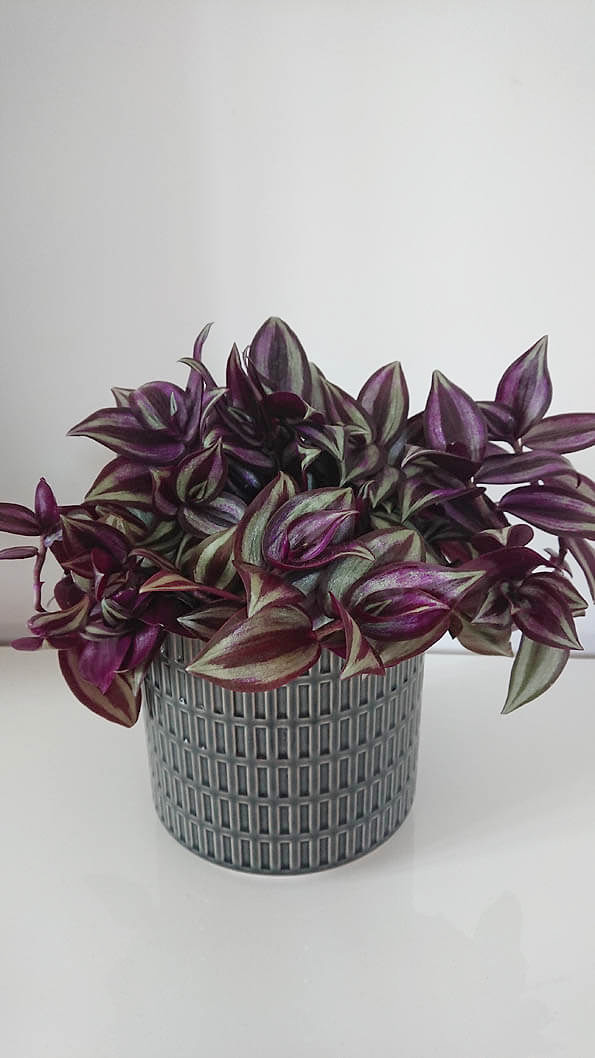
Tradescantia make for excellent houseplants as they fit into almost any design scheme
" Wandering Jew Plant for sale " and " How do I care for my Wandering Jew plant? " are two big hitters when it comes to our visitors asking us questions about this popular and easy care houseplant. We would suggest Amazon.com or Amazon.co.uk or our Where to Buy article to kick start the buying hunt, and our article below will (hopefully) answer the care question for you.
The common names are based around the plant's ability to easily spread itself.
To start things off, a lot of people also want to understand the common names this plant goes by - the Wandering Jew Plant and the Inch Plant . Both names are centered around its ability to spread and grow very quickly, with little care or intervention from people.
Pro Tip - This is truly one of the simplest houseplants to propagate. From taking cuttings, you can have fully grown plants in less than 6 months.
The Wandering Jew is a legend that basically follows that a Jewish man was cursed to walk the earth forever, therefore like this plant the Jew will, in time, eventually go everywhere .
A number of visitors have contacted us to say the use of this common name today could be misconstrued or even upset Jewish people.
Unfortunately we've not been able to find any specific use of this common name being deliberately used by houseplant owners (or the horticultural industry in general) in an anti-Semitic way (from what we've seen at least). When talking about this plant directly even a Rabbi feels that the name is probably not used with conscious anti-Semitic malice .
That being said, the use and choice of words is often important. Our website is about houseplants and the joy they can bring, and without even trying, this hobby is a very inclusive pastime for everyone.
Our communication to you therefore should reflect this. We'll continue to monitor the common name and use one of the alternatives on our social media channels such as Wandering Dude .
The " inch " plant name probably comes from a combination of the stem's ability to grow about an inch every week, and also because only an inch of this plant is needed to propagate itself.
There are several popular varieties of Tradescantia Zebrina for sale each sharing the recognisable glistening leaf surface and purple underside. T. zebrina 'quadricolor' has green, silver, pink and red leaf markings, whereas T. zebrina 'purpusil' has a green and purple blend.
Tradescantia fluminensis is a very close relative to T. Zebrina (or Zebrina pendula as it used to be called) and is also known as the Wandering Jew Plant. Although it's much less popular these days, its care requirements are identical to T. Zebrina except it will cope better with a slightly darker position.
Where to Buy? - Where can you buy all these interesting varieties you ask, that's easy, check out these Etsy Sellers! * You can also find a broad range as well as some more unusual types over on eBay * * We'll sometimes earn a small commission when you buy something through the affiliate links on our site.
It has smaller leaves compared to its bigger cousin and more green in the leaves. T. fluminensis is therefore very plain looking so search out some of the varieties instead such as T. fluminensis 'variegata' or T. fluminensis 'quicksilver ' or T. fluminensis 'Tricolor', these have cream and white stripes to give it a bit more of a visual punch.
You may find several types growing all in one pot for an extra hit. As the care requirements for each is pretty much the same you can leave them clustered together like this (providing you like this look of course).
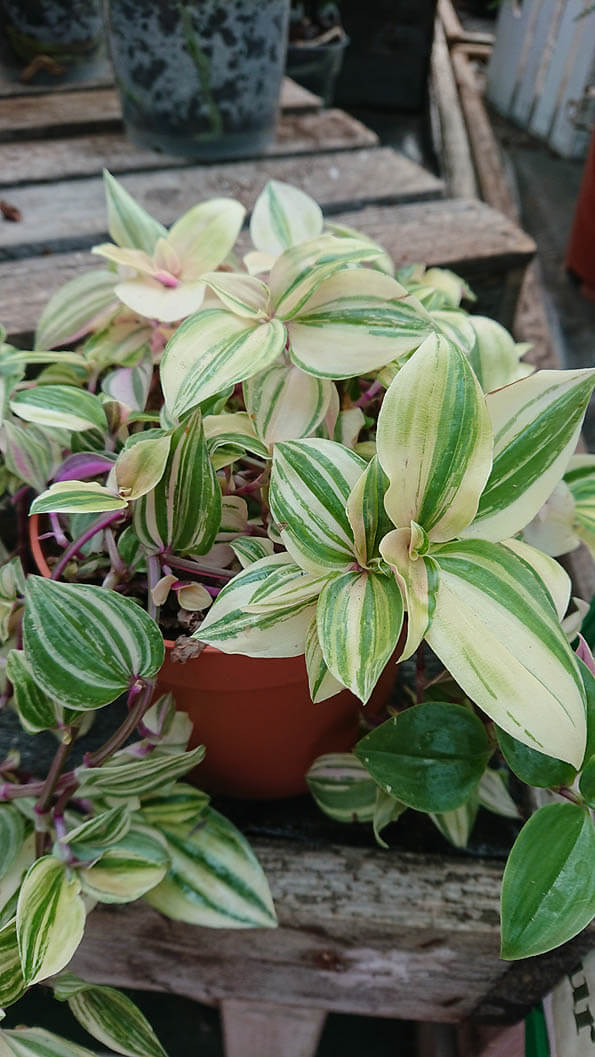
Variegated Tradescantia are becoming much easier to find
We should mention that the Wandering Jew Plant outdoors tends to become an invasive species if not properly maintained, as it's difficult to eradicate because if only an inch of it survives it will live on.
That said, our focus is on the indoor grower and so its potentially invasive nature outdoors isn't a problem. The Wandering Jew Plant is safe to have around cats and people, the sap in the leaves and stems, however, can be irritating so either wear gloves or wash your hands immediately if you come into contact with this.

Hi, I'm Tom!
If you're like me and enjoy the challenge of growing houseplants and getting them to thrive, then Ourhouseplants can help. This website shares my knowledge and years of growing plants and provides (hopefully) helpful advice on properly caring for your indoor plant friends.
Wandering Jew Plant Photos
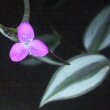
Wandering Jew Plant Care Guide
All Tradescantias including the Wandering Jew Plants need plenty of light to retain the variegated colours on the leaves, if things are too dim these will fade.
On the other side of the coin if too much light is provided leaf scorching is the end result, fortunately however the problem of " too much light " is basically only caused by excessively exposed locations during midsummer.
This is quite hard to provide indoors anyway, so you will only really risk this if you Summer your plants outdoors.
It's important they're placed in plenty of light but protected from very strong sun .
As you would expect from any easy houseplant, the Wandering Jew will cope with droughts and a little water logging from time to time.
Try to avoid this careless watering approach where possible though as a good looking plant needs to be watered correctly. The instruction here is simple, water your Tradescantia regularly and freely during the warmer seasons to try and keep the soil moist for much of the time.
In Winter cut right back because growth will slow or stop completely and the need for water will reduce drastically as a result.
The leaves are almost succulent like and therefore humidity is something you don't have to worry about a great deal. It will be worth misting the plant however if you start to notice the leaves becoming shriveled or brown leaf tips start to appear. You can also grow Tradescantia in an indoor bottle garden .
The opinion is often divided about how much and how often you should feed Wandering Jew Plants.
Some will suggest regular heavy feeding, perhaps as much as every other watering and others will say only once or twice a year at most, otherwise it will encourage the variegated leaves to turn green. The truth of it is that this plant will cope with almost anything you give (or don't give) it.
We fertilise normally (back of the bottle instructions) once a month and the OurHousePlant.com's Inch Plant is as good looking as the day it was brought.
Temperature
Give your plant average warmth conditions for quick growth, a cooler room of around 10°C (50°F) is also suitable too. In fact, the only no no, is exposure to frost or really chilly temperatures for prolonged periods. Frost will do serious damage and chilly locations will cause leaf discoloration.
It's best to repot once a year to give a little more space for the roots to grow, but as with everything else to do with this plant, it will still cope living in the same soil for years. This is handy if you've chosen to grow it in a hanging basket as these can be fiddly to upsize and can also be a little difficult to work with.
When you do repot though, normal potting soil is a great choice, just make sure you avoid mixes with a heavy manure content and don't use ordinary dirt from your yard.
Propagation
When it comes to propagation of Wandering Jews only the Spider Plant is easier and more reliable to work with. The success rate of Spider Plants is something like 99% and the Wandering Jew, 98%, so either way it's still incredibly easy to grow more plants.
You don't need a fancy heat mat or any special containers or tricks. You don't need to use any type of rooting hormone, and it's literally just a case of pushing the cutting a few centimeters into a fresh potting mix, water well and away you go. Trust us, once you know what you're doing it's so easy to do. Below is a break down of each step.
The stems of a mature plant are quite brittle so an accidental knock or an intentional snip on an existing plant will mean you have a Wandering Jew Plant stem cutting almost ready to go.
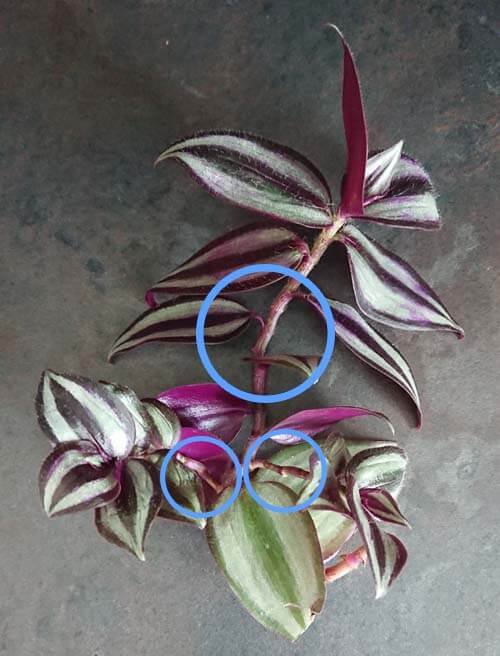
This broken stem can be used to create multiple plants
You don't need to wait for the fresh cut end to dry out so you could just push it into some soil (even in the existing pot where it was growing before if you're trying to recreate a bushy appearance).
But just replanting the large stem is potentially wasteful as there are several individual plants that can be created from a broken stem, like the one shown in the photo, this cutting could easily become three plants.
The photo above shows three sturdy stems with blue circles around them. Snip them off, making sure each is an inch long and has at least one leaf , although ideally for quicker results you will want a cutting that is several inches long and several leaves already in place.
Trim off any leaves on the lower part of the cuttings , because if any leaves touch the soil they will quickly rot, which could then cause the entire cutting to fail. Instead, remove the lower leaves and discard any unused material.
Below you can see the results of the above instructions - Three cuttings created from the original big one that are now ready to be planted up.
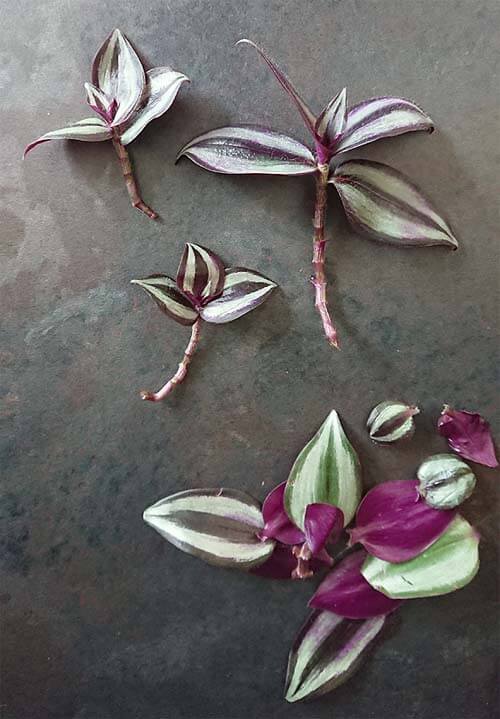
Several sections have been created and the lower leaves removed
Simply fill a container with potting soil or compost and wet it before inserting the stem ends into the soil. Make sure the cuttings are reasonably stable and fixed in place as they need good contact with the soil to stimulate root growth.
Pro Tip - Cuttings will take time to become bushy and to fill a pot by themselves, so because of the ease at which propagation can be done it's usually more effective to take several cuttings and put them all into the same pot.
You can use a rooting hormone, but we've found standard cuttings root with a very high probability anyway so don't bother.
Cuttings do much better if they don't touch each other and if they're planted towards the edges of the container rather than right in the center. Doing this will discourages rotting and the outer edges tend to be warmer than the very heart of the pot which gets the roots growing faster.
Once in place keep the soil moist (but not wet or soggy) and keep the plant warm. New growth should appear in just a few weeks. If you decided to grow several cuttings in a single pot and you notice any gaps later on, you can just push in new cuttings whenever needed to make it bushier.
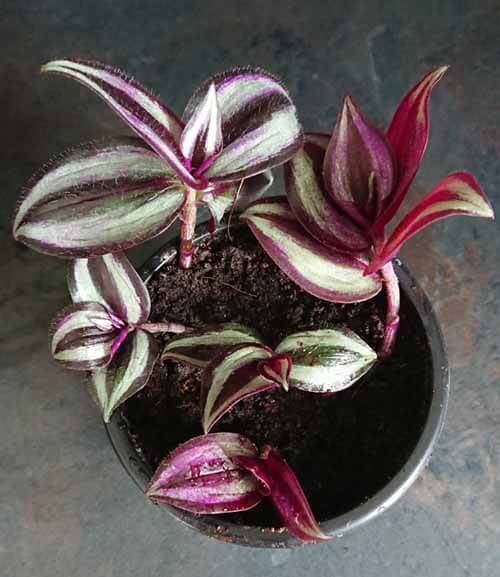
The cuttings planted up into a pot of compost
You can, of course, grow your individual cuttings in their own pots if that's what you'd prefer to do, but by putting several together like in the photo above it will mean after just a few months this pot will be completely covered with new growth.
All these cuttings will have knitted together nicely to give the illusion of one full plant when in fact it's actually several. This is something that would take almost a year or more if you're going for one stem cutting per pot.
Speed of Growth
The growth rate of Wandering Jew Plants when temperatures are warm is fast. As much as an inch a week in the growing seasons, if good light levels are provided and its watering needs are being met.
Its natural tendency is to "vine" and spread out, so if you aren't growing this in a hanging basket or you want to grow a neat compact looking plant then you must prune regularly to keep it tidy (don't forget the pruned stems can be used to propagate new plants).
Height / Spread
The height of this plant won't ever go beyond 6in / 15cm however every single stem can eventually grow to 6ft / 1.8M.
This type of spread might be what you're looking for of course i.e. if you want it to trail down from a hanging basket perched up high. However the stems can always be kept shorter by pinching out the growing tips on a frequent basis.
The Wandering Jew Plant is another houseplant that is grown for it's foliage rather than the flowers it produces, however they can still add a nice touch when they appear.
The pink or purplish flowers these plants produce will be small and can appear at any time of the year, although it's much more likely in late Spring early Summer.
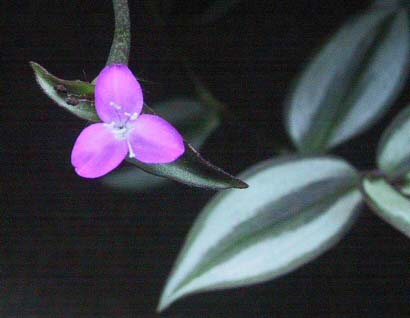
Inch Plant's aren't normally grown for their flowers, but they'll still bloom indoors sometimes
Are Tradescantia Plants Poisonous?
Generally speaking, Tradescantia is very mildly toxic to pets and people.
While it does little harm if eaten, the sap within the leaves and stems can cause contact dermatitis on the skin, especially in those with sensitive skin or those with an allergy . Wash your hands quickly after handling and you shouldn't have any issues.
Anything else?
Your plant is looking tired, it's become leggy and unattractive, convinced you have done something wrong you Google " Wandering Jew care instructions " to try and find out how to fix things. The answer you'll find will be pretty much the same everywhere because as any seasoned owner of this plant will tell you, this " look " is inevitable.
The vines grow long and quickly. Over time as they age the older leaves yellow and fall off creating the appearance you feel you've caused through poor treatment, which isn't usually the case.
Basically what's happened is that the plant has pushed and spread itself away from the pot it was growing in.
You can start again by taking cuttings and next time prune more frequently to encourage everything to keep closer, compact and neat.
Caring for Wandering Jew Plants Recap
Good Light Needed To keep the beautiful markings you need to provide good to bright light. Avoid direct sun exposure and low light conditions.
Average Watering Tolerant of a wide range of watering styles, it secretly wants to be well watered and for the soil to be moist for much of the time.
Average Temperature Provide temperatures at or above 18°C ( 65°F ) for best results.
Feeding Feed the soil once a month during Spring and Summer.
- No direct sunlight or low light positions
- Do not try and grow your plant in very cold places
Wandering Jew Plant Problems
Normally this is down to age, the oldest leaves will yellow and fall naturally. Although if this happens and you notice there are limp stems too then this is likely to be caused by quite prolonged and extreme underwatering.
Leaves changing to green / lost variegation
Although you can buy a green leaved variety of Wandering Jew, the majority are variegated and therefore if the leaves are changing colour this is obviously a problem.
The cause is almost certainly too little light. Overwatering can dull the colours but this doesn't make them go completely green. The cure therefore is to move the plant to a brighter area in your home.
Crispy brown and translucent leaves
Sometimes you'll find dead brown crispy leaves or some leaves going yellow or translucent, as shown in the photo below.
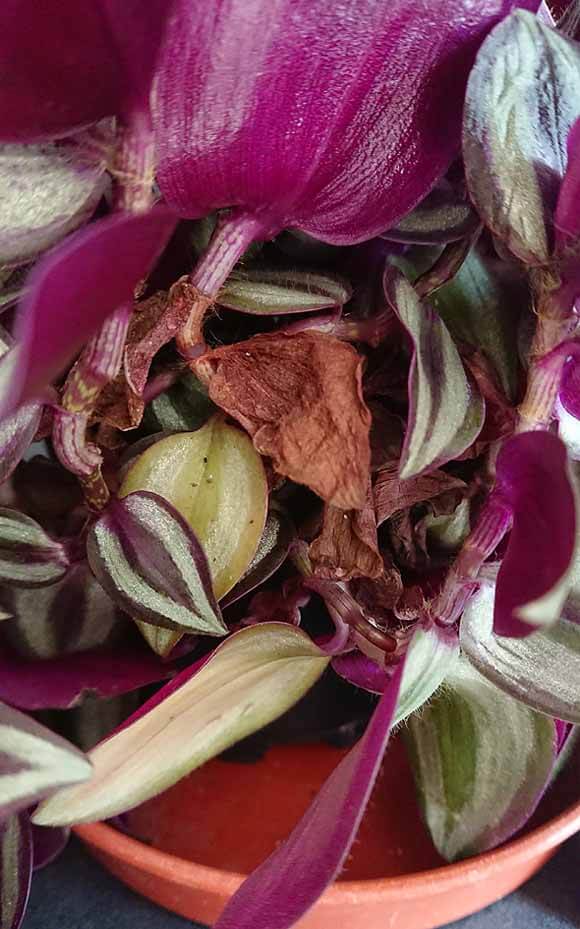
Tradescantia houseplant with unhappy leaves
This is going to be caused by one of the following (or in some cases a combination).
- Natural Ageing . Close to the heart of the plant tend to be the oldest leaves which are likely receiving very little light due to the shade from the canopy of the outer leaves. It's sensible for the plant to shed these leaves as they're not serving any propose. These leaves should pull off easily, so just remove them.
- Too much light . Excessive direct burning sunlight will quickly scorch and destroy the leaf. These plants want bright light but not full sun.
- Underwatering . Too little water can cause leaves to crisp and dry out. Make sure you're giving your plant ample water during the growing months.
Wandering Jew Plants love water when growing strong, but as with the majority of indoor plants too much watering will eventually rot the stems. Keep the soil moist not water logged.
Bare spindly and / or leggy growth
This is typically the issue discussed in the " anything else " section above, i.e. this appearance is usual after the plant is quite old. It may also be caused however by too little light (the variegation will have faded also), too little water on a regular basis (accompanied with yellowing leaves), or not enough fertilizer .
Wandering Jew Plant leaf tips are brown and shriveled
Although quite unusual in most homes this is caused by placement in a room with very low humidity, i.e. the air is too dry. You might also be trying to grow your plant next to a heat source like a fire or heater.
Either move the plant somewhere else or follow some of our tips to increase humidity in the home. You should resolve this quickly as your Wandering Jew Plant will also be easy prey for Red Spider Mite infestation.
About the Author

Over the last 20 years, Tom has successfully owned hundreds of houseplants and is always happy to share knowledge and lend his horticulture skills to those in need. He is the main content writer for the Ourhouseplants Team .
Also on Ourhouseplants.com
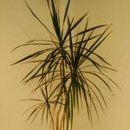
(Article / Gallery) Photo credit of the Wandering Jew T. fluminensi to LucaLuca (Article / Gallery) Photo credit of the Wandering Jew flower to Ruestz
About Ourhouseplants.com
Our website is for anyone looking for success with indoor gardening.
With care guides and information about all popular indoor plants, we're here to help get your houseplants thriving. From the beginner to the more experienced, there's something for everyone.
As a Team, we've almost 50 years of hands-on experience and various horticulture skills. So let us help you to grow your knowledge and become a houseplant expert.
Six Reasons You Can Trust Us
- Recent Updates
- Privacy Policy
- © OurHouseplants.com - 2013 - 2024

- Patio, Lawn & Garden
- Gardening & Lawn Care
- Plants, Seeds & Bulbs
Image Unavailable

- To view this video download Flash Player

Purple Wandering Jew Live Plant Cuttings - (9) Cuttings - Tradescantia Zebrina Live Plant for Growing Indoor - No Root
Purchase options and add-ons
About this item, additional details.

Customer ratings by feature
Consider a similar item.

Frequently bought together

Videos for similar products

Product Description
Looking for specific info, product information, warranty & support, compare with similar items, customer reviews.
Customer Reviews, including Product Star Ratings help customers to learn more about the product and decide whether it is the right product for them.
To calculate the overall star rating and percentage breakdown by star, we don’t use a simple average. Instead, our system considers things like how recent a review is and if the reviewer bought the item on Amazon. It also analyzed reviews to verify trustworthiness.
Customers say
Customers say the plant seeds arrived healthy and are growing well. They also find the appearance beautiful and vibrant. Customers say some of the cuttings have already started to root. They appreciate the completeness and quantity of the plant. Customers also like the stability.
AI-generated from the text of customer reviews
Customers are happy with the health of the plant seeds. They mention that the shoots arrived healthy and are growing well. Some customers also mention that they are thriving and potted.
"These are gorgeous very dark purple cuttings that were packed with care and healthy ...." Read more
"These cuttings got to me fast and healthy . They has tiny roots already starting on them. There was a large amount if cuttings...." Read more
"...They were very well packed & beautifully healthy on receipt . I put 5 in soil & 3 in water. All are doing great & I have new leaves sprouting already!" Read more
"cuttings came in very good condition. packaged well, and they started growing up when I planted in the soil. beautiful plant" Read more
Customers are satisfied with the appearance of the plant seed. They mention that it is beautiful, vibrant, and healthy. Some say that the cuttings are dark purple and that they are thriving.
"These are gorgeous very dark purple cuttings that were packed with care and healthy...." Read more
"... Beautiful . Thank you!" Read more
"...Packaged great with care and in amazing shape !" Read more
" absolutely loved his cuttings thank you do happened to have cutti gs is Swedish Ivy would love sone" Read more
Customers are happy with the roots of the plant seed. They say the cuttings are healthy and started growing roots immediately. Some customers say that the cutting had tiny roots already starting on them.
"...They sprouted roots in water within days and now thrive in my hanging planter." Read more
"These cuttings got to me fast and healthy. They has tiny roots already starting on them . There was a large amount if cuttings...." Read more
"These were just as they said, the clippings grew roots fast and fixing to plant them!!" Read more
"...They started growing roots immediately . Once planted they have grown so much!..." Read more
Customers are satisfied with the condition of the plant seeds. They mention that the cuttings came in very good condition. Some are also impressed with the size, quality, and vibrant colors of the seeds.
" cuttings came in very good condition . packaged well, and they started growing up when I planted in the soil. beautiful plant" Read more
"So impressed with size, quality and vibrant colors of these cuttings! The cuttings were lovingly packed with care for their journey...." Read more
"My cuttings arrived well packged and in perfect condition . These healthy cuttings were potted up with in minutes of arriving." Read more
"...They were packed with alot of care and showed up in pristine condition !" Read more
Customers are satisfied with the completeness of the plant seed. They mention that it contains a large amount of cuttings, and that the leaves are thick and full.
"...They has tiny roots already starting on them. There was a large amount if cuttings ...." Read more
"... Very generous number of cuttings too! I would definitely order again from this seller." Read more
"...And had sprouted in their travel time. The leaves are SO VERY THICK & Full !!!!! Absolutely GORGEOUS!!! I’m so excited about these I could bust!!!..." Read more
" Nice full cuttings ! Was able to transplant immediately and already growing!" Read more
Customers are satisfied with the stability of the plant seeds. They mention that the plants are strong and beautiful. They also say that the packaging was very secure and that every clipping is growing strong.
"...It's been a week now and they are thriving. Every clipping is growing strong . This seller definitely knows what they are doing." Read more
"This came in packaged very secure . The plant was beautiful. Thank you so much." Read more
"I was delighted with the robust , healthy, beautifully colorful plant clippings...." Read more
"i’m very happy with these plants so strong abd beautiful thank you..." Read more
Customers find the value of the plant seeds to be terrific for the money. They also say it's an excellent purchase.
"...One month later, they are ready to be repotted in larger pots. Excellent purchase ." Read more
"...A truly terrific value for the money and now I have thriving beautiful vines giving my kitchen a burst of color." Read more
"...I’m so excited about these I could bust!!! The value is beyond $10 that’s for sure!! Will definitely look to buy from this seller again!" Read more
"...Great job! And very great price . Don’t hesitate on these beauties!" Read more
Reviews with images

- Sort reviews by Top reviews Most recent Top reviews
Top reviews from the United States
There was a problem filtering reviews right now. please try again later..
- Amazon Newsletter
- About Amazon
- Accessibility
- Sustainability
- Press Center
- Investor Relations
- Amazon Devices
- Amazon Science
- Sell on Amazon
- Sell apps on Amazon
- Supply to Amazon
- Protect & Build Your Brand
- Become an Affiliate
- Become a Delivery Driver
- Start a Package Delivery Business
- Advertise Your Products
- Self-Publish with Us
- Become an Amazon Hub Partner
- › See More Ways to Make Money
- Amazon Visa
- Amazon Store Card
- Amazon Secured Card
- Amazon Business Card
- Shop with Points
- Credit Card Marketplace
- Reload Your Balance
- Amazon Currency Converter
- Your Account
- Your Orders
- Shipping Rates & Policies
- Amazon Prime
- Returns & Replacements
- Manage Your Content and Devices
- Recalls and Product Safety Alerts
- Conditions of Use
- Privacy Notice
- Consumer Health Data Privacy Disclosure
- Your Ads Privacy Choices

IMAGES
VIDEO
COMMENTS
Wandering jew plants are super easy to propagate. Take cuttings that are 3-4″ long, and include a couple of leaf nodes. Dip the cut ends into rooting hormone, then stick them in moist soil. Don't allow the soil to dry out, and keep the air around the cuttings humid. A propagation chamber makes this simple.
Repotting Tradescantia Plants. If your wandering jew is beginning to become a bit crammed in its pot, select a pot that's 1-2″ wider than its current one. Prepare your pot with a little fresh potting soil around the sides. Remove your inch plant from its existing pot, setting the root ball into the new one.
Fill a 6-inch to 1-gallon container that drains with a rich, well-drained potting mix. Water the soil to settle it. Make about a 2-inch indentation in the soil where you want to place the Wandering Jew cutting. Remove the bottom leaves from the cutting where you will be inserting it into the soil.
W andering Jew Plant Care. To keep your Wandering Jew plant thriving, ensure it receives bright, indirect sunlight. Keep it in average room temperatures of 60-75°F (16-24°C). Fertilize once a month during spring and summer. In winter, relocate the plant to a cooler area with temperatures of 54-59°F (12-15°C).
Pruning. Wandering Jew plants require regular pruning. The plant grows quickly, and if you don't prune, then it can overtake the pot fast. Pruning also helps the stem, from getting "leggy," meaning that the plant starts to look bare at the base. Pruning keeps the plant healthy and growing at an optimal rate.
The wandering Jew plant is a common name for different species of plants that belong to the Tradescantia genus. There are around 75 different types of plants in Tradescantia genus and some are called inch plants, spiderwort, striped wandering Jew, Boat Lily, Purple Queen, or flowering inch plant. Wandering Jew plants are great house plants because they are relatively easy to care for.
3. Pot your Wandering Jew plant. Fill the pot about two-thirds of the way with light, well-draining potting soil, then place the plant in the center of the pot. Add soil to surround and fill in the sides. Gently press down on the soil around your plant and water it until the soil is completely moistened.
Tradescantia displays small 3-petaled pink, white, or purple flowers.. Wandering Jew Quick Care Tips. Botanical Name: Tradescantia zebrina Common Name(s): Wandering Jew, Inch Plant, Spiderwort Synonyms: Zebrina pendula, Zebrina purpusii Family & Origin: Commelinaceae family, native to Mexico and Central America Growability: Easy to grow Grow Zone: 9-11 Size: Grows up to 2-3 feet long
An inch or two with a few leaves works best. Remove the leaves at the bottom so part of the stem is exposed. Place the cutting in a glass of water to root or plant it directly in soil. You can put cuttings back in the mother plant's pot to give her a fuller appearance on top.
The Wandering Jew plant, scientifically known as Tradescantia spp., is a genus of herbaceous and perennial plants, belonging to the Commelinaceae family.It is not a single plant but rather the common name for a variety of Tradescantia species, including Tradescantia fluminensis, Tradescantia pallida 'Purple Heart', and Tradescantia zebrina, among others.
The thick green leaves have a fuzzy texture and a purple hue on the underside. You can easily propagate it from the cuttings, both in soil and water, once it gets growing. It bears delightful clusters of blue, purple, white, or rose pink flowers, making it one of the best types of wandering jew plants on the list. 5. Tradescantia Sillamontana.
To care for a Wandering Jew plant indoors, place it in a location with bright, indirect sunlight, such as near a window. Water it when the top inch of soil feels dry, typically every 1-2 weeks, and provide well-draining soil. Additionally, mist the plant occasionally to increase humidity and remove dust from the leaves.
Best known by the common name Bolivian Wandering Jew or creeping inch plant, Callisia repens (kal-LIZ-ee-uh REE-penz) is a member of the spiderwort (Commelinaceae) family. Native throughout South America, the Caribbean, and Central America. However, it has gained some popularity in the United States as a perennial ground cover in the southernmost regions and as an annual or indoor plant in ...
Propagating Wandering Jew through Soil. To propagate Wandering Jew in soil, take 4-6 inch cuttings, remove lower leaves, and plant them in a 6-inch pot filled with all-purpose soil. Keep the soil consistently moist, place in indirect light, and enjoy a vibrant new plant in a few months.
About. A Wandering Jew plant, Tradescantia , is a fast growing, easy to care for plant that looks beautiful hanging in front of a window that gets bright, indirect light but no direct sun.Popular nicknames are "Inch Plant" or Spiderwort. Originally found growing as a 1-2ft tall wildflower in Canada and all the way south to Argentina, today a wandering jew plant is both a popular indoor and ...
The common name of the plant, wandering Jew, refers to a myth from medieval times about a Jewish man who taunted Christ on his way to the Cross. ... Place a plastic bag over the pot to create a mini greenhouse. This will create a humid atmosphere as well as keep the soil moist while your cutting is growing new roots. Place the container in a ...
The wandering dude is a novice plant parent's dream: It's an easy to grow plant, has beautiful silver, green and magenta foliage, and drapes beautifully from pots.Wandering dude (Tradescantia zebrina) also is super-simple to propagate so you can make more baby plants (for free!).With its long dangling stems, this plant tends to "wander" all over the place.
1. Propagate from stem cuttings. Propagating a wandering Jew plant from stem cuttings is easy and quick. What's more, is that you don't need a special rooting medium or hormone for successful rooting. You just need to root the cuttings in water or soil. Let's start with rooting a Jew plant in water. First, cut at least 6-inch long ...
The Tradescantia Zebrina, also known as the Wandering Jew plant, boasts stunning purple and silver striped leaves that are sure to catch the eye. This particular plant thrives in bright, indirect light and soil that is kept consistently moist. 2. Another great option is the Tradescantia Nanouk, which features leaves that are similar in ...
The Wandering Jew is a legend that basically follows that a Jewish man was cursed to walk the earth forever, therefore like this plant the Jew will, in time, eventually go everywhere. A number of visitors have contacted us to say the use of this common name today could be misconstrued or even upset Jewish people.
This Plant spreads to form a dense ground cover over time. White flowers in axillary cymes are enclosed by long-lasting, boat-shaped, purple bracts, hence the common name of Moses-in-a-basket. Flowers bloom throughout the year. Flowers are followed by fruit. This plant is easily grown indoors in pots or containers. Also Read: Different Types of ...
Wandering jew plant outdoors is best placed in a spot where it stays between 50-80 degrees most of the year. Provide a bright, but partially-shaded environment, and your plant will be thrilled. ... The mini-monstera, Rhaphidophora tetrasperma, isn't a true monstera at all! Learn about this tropical wonder in our in-depth growing guide.
Step 2: Trim weak or thin areas - Next, remove any thin, weak, or leggy sections of your wandering dude plant down to a lower leaf segment. You can either pinch them back with your fingers, or cut them using clean, sharp shears or snips. Cut back wandering jew just above a leaf joint.
This item: Purple Wandering Jew Live Plant Cuttings - (9) Cuttings - Tradescantia Zebrina Live Plant for Growing Indoor - No Root $11.88 $ 11 . 88 Get it Jun 3 - 5